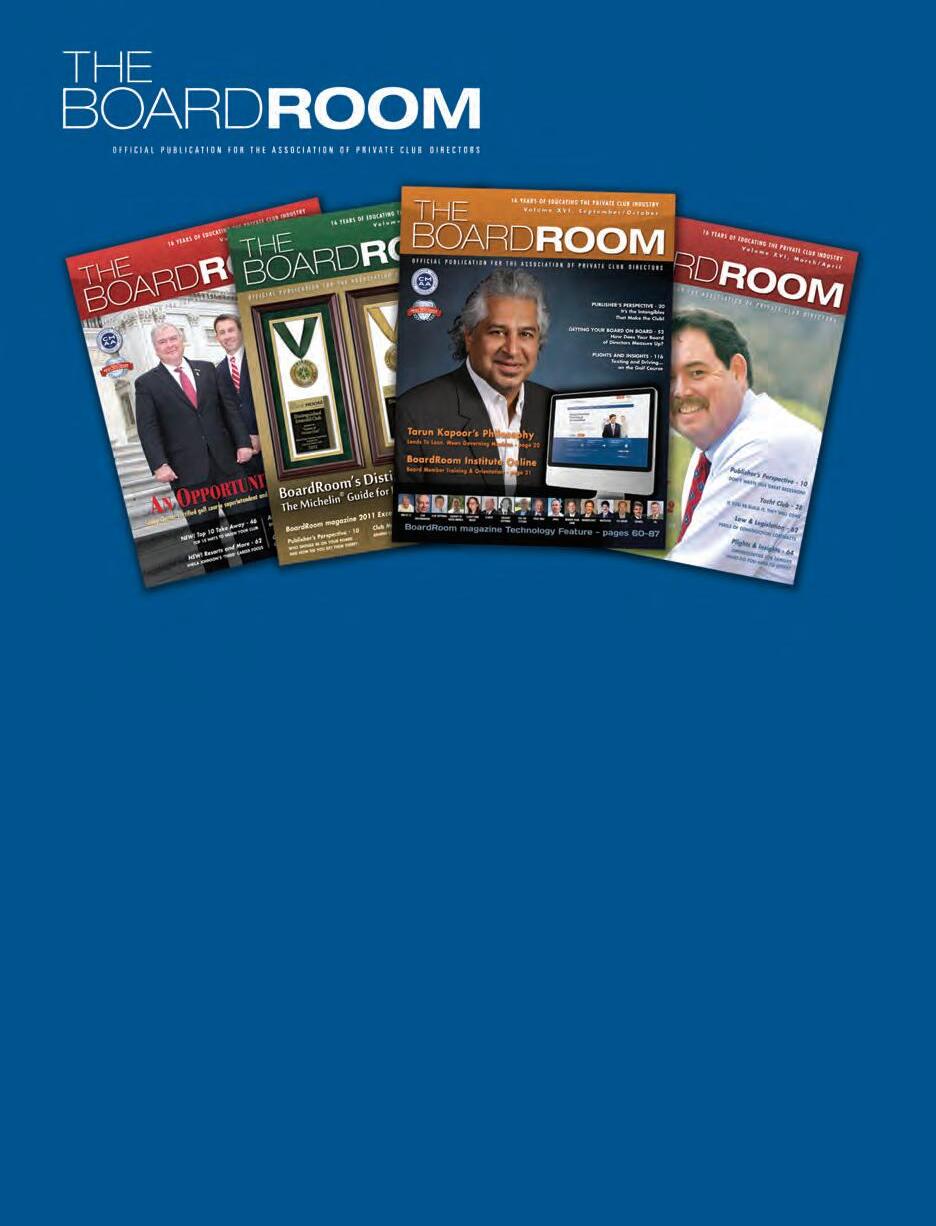







































The churn continues…as technology for the private club industry marches on!
Our annual Technology issue (September/ October) focuses on our contributors and vendors, as they give us their opinions of what and where and the why of today’s club technologies, including some by way of case studies.
They’re telling us where we’re at and where they think we’re headed. It’s their opinions, and unquestionably technological change continues to happen quickly for private clubs. We think their viewpoints can cast some light on your discussions with your technology suppliers…as well as your members.
Again the many technological companies who service the private club industry, tell us their stories about software, hardware and the many innovations they provide for their private club clients…all of course aimed at deepening the members experience for private club members.
But my, how the world…the private club world, is changing.
Not all that long ago, the use of cell phones, smartphones and other technological pieces were verboten in most, if not all, private clubs.
Check your phone in at the front door often appeared as the ‘modus operandi.’ There can be no disturbing the culture and years old tradition.
Today the difference is remarkable, as clubs work with their memberships to make their facilities and amenities that much more appealing, simply because that’s how members, their families and clubs want it, and are functioning today.
Likely one of the biggest steps has come through the information flow from clubs to their members…technology has allowed members to become so much better informed in a variety of ways, and it is also allowing clubs to better serve their members.
Bob Bodman, for example, writes about the fact that a ‘convenient, secure, club-specific, cloudbased integrated database system” is the most effective systems for managing club documents.
That’s a far cry from the years of paper trails that club staff had to weed through to find something of importance.
Clubs for years have been laggards when it comes to adopting the latest and greatest, and
that has led Bill Boothe to ask the question, “So what should we do?” Bill suggests the answer isn’t quite as simple as it used to be, but he does give private clubs a list of how clubs are closing the gap between older and newer systems, and that doesn’t necessarily mean everything is new. The point is, clubs are taking charge and being proactive to make their tech systems work better.
At the same time, Ron Cichy and his group of researchers have confirmed that club boards are looking for “desirable ways to balance opportunities for innovations with the deeply rooted legacy ties of members.”
Their research finds that members are increasingly using technology to enhance their communication with their clubs…and that’s an added benefit of the overall membership experience. The research finds that ‘technology is capable of building emotional connections with members, helping these owners (members) feel even more connected to the club. As Cichy says, “the possibilities for technology to enhance the private club experience become endless.”
And finally we have drones…and a fascinating article written by Toby Ingleton about golf course architects (ASGCA members), who are discovering myriad ways to use drones in their daily work. What started out as a ‘fly-by’ over a golf course to see what’s there, has led to an ‘a-ha’ moment for more than one golf course architect. Today drones are an invaluable tool. And again, “the possible uses are boundless,” says Ingleton.
And finally, we present more of BoardRoom’s Top Presidents for 2015 with stories featuring Anthony J. Magdowski, President, Detroit Athletic Club, Detroit, MI; Greg Miarecki, President, Chicago Yacht Club, Chicago, IL, and Peter Miller, President, The Club at Ibis, West Palm Beach, FL. BR
Got a comment?
Drop us a note: dave@boardroommag.com
Publisher/CEO
John G. Fornaro
Editor/Co-Publisher
Dave White
Assoc. Editor/VP Creative/Co-Publisher
Heather Arias de Cordoba
APCD Executive Director
Bill Thomas
Editorial & Marketing Director
Dee Kaplan
Account Manager
Dina Alleluia-Carr
Contact Information
www.BoardRoomMagazine.com www.apcd.com (949) 376-8889 or (949) 365-6966
Subscriptions and Website
Heather Arias de Cordoba www.BoardRoomMagazine.com (949) 365-6966
Featured Columnists
Rick Coyne
Henry DeLozier
John G. Fornaro

Co-Founder/CEO
John G. Fornaro
President Keith Jarrett
Chief Analyst Frank Gore
Chief Information Officer
Jeff Briggs
Executive Director
Bill Thomas
Contact Information
www.DistinguishedClubs.com (949) 376-8889
Harvey Johnson Bonnie J. Knutson Richard Kopplin
Contributing Writers
Heather Arias de Cordoba
Bob Bodman
Chris Boettcher
Bill Boothe
Susan Bozeman
Peter Cafaro
Boyd Carr
Ronald F. Cichy
Rita B. Craig
Michael Crandal
Ray Cronin
Dave Doherty
John Embree
Rhett Evans Tom Everett Jim Fedigan
John Finley
Steve Graves
Larry Hirsh
Rick Ladendorf
Lynne LaFond DeLuca
Terry Hackett
Kelley Harris
Rob Harris
Toby Ingleton
Nancy Levenburg Jerry McCoy Kevin F. Reilly Bill Schwartz Dave White
MiRan Kim
Susan Lyle
Ryan Maione
Ray McDonald
Steve Mona
Macdonald Niven
Robyn Nordin Stowell
Gregg Patterson
Frank Pitsikalis
Ricky Potts
Rachelle Reali
Praneet Rhandhawa
Toni Shibayama
Rosie Slocum
Craig J. Smith
Michael Sparks
Alyson Stevenson
Mitchell Stump
Michael Talbot
Frank Vain
Ned Welc
Bruce R. Williams
Don Williams
Jim Wisniewski
Dean Wochaski
Endorsements, Strategic Partners and Allied Associations









BoardRoom
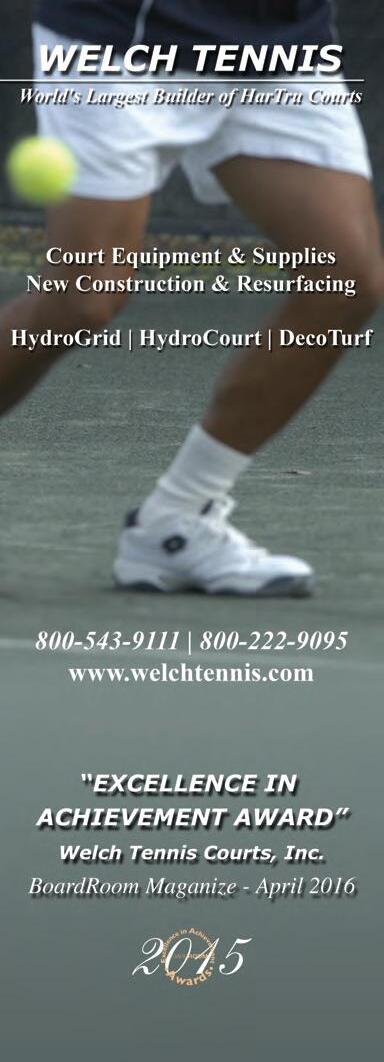

PERSPECTIVE | 10

BY JOHN G. FORNARO
In most cases, the board goes through a 100 percent change within three years. This can be a ‘sticky wicket’. It seems boards are continually taking the Maalox approach… something to deal with the symptoms rather than digging out the root problems.

BY BILL SCHWARTZ
We’ve defined perfect food cost, in Part I of this series, as the cost required to provide exactly the amount of food required to meet the legitimate need during the period in question. And we discussed the path to achieving, or at least getting closer to the perfect food cost. Now we’ll look the procurement section of the path.
CLUB FACTS & FIGURES | 66


BY KEVIN F. REILLY & HARVEY JOHNSON
Ask any security expert and they will tell you that it’s not a matter of “if”, but “when” your organization will suffer a cyberattack. And while you might think a country club isn’t a huge target for hackers, the reality is that no organization is safe anymore, particularly smaller entities.

BY HENRY DELOZIER
“Badges? We ain’t got no badges. We don’t need no badges. I don’t have to show you any stinkin’ badges!” His indignation is not unlike that of some club directors who seem to enjoy an above-the-law status, doubting that certain standard requirements apply to them.

BY RICHARD KOPPLIN
In Stephen M.R. Covey’s The Speed of Trust, the premise is that you can accelerate every business decision if there’s a real sense of trust among the participants. How do you create an environment of trust in the boardroom, among directors and also with the club general manager/chief executive?

BY JERRY MCCOY
This has been an interesting year…so many clubs with projects at many different levels of completion. And it’s amazing that the same issues resurface from club to club and project to project. Remember what Winston Churchill said, “To improve is to change, to be perfect is to change often.”
CASE STUDY| 14

BY RICK COYNE
“Belonging matters. Each of us yearns for the tribe: for the affiliations that will support us, protect us, define us, help us make sense of a complex and overwhelming world.” – Allen Blue, co-founder of LinkedIn, from his the recent book, The Membership Economy. How fitting for membership in a private club?

BY BONNIE J. KNUTSON
When we were youngsters, the notion of children as members was in the realm of comedian Rodney Dangerfield. They got no respect. Now, kids are – or should be – on every club’s radar screen. Today’s family is an inclusive family with parents empowering and encouraging their kids to be involved in decisions across the board.
120

BY NANCY M. LEVENBURG
What is a perk? A perk (as a noun) is defined as extra money, privileges, fringe benefits, etc. pertaining to a job or assignment. A perk for me as a Grand Valley State University faculty member is the ability to exercise for free at the university’s $6 million recreation center, or reduced pricing to exercise through a corporate membership at a l ocal YMCA.
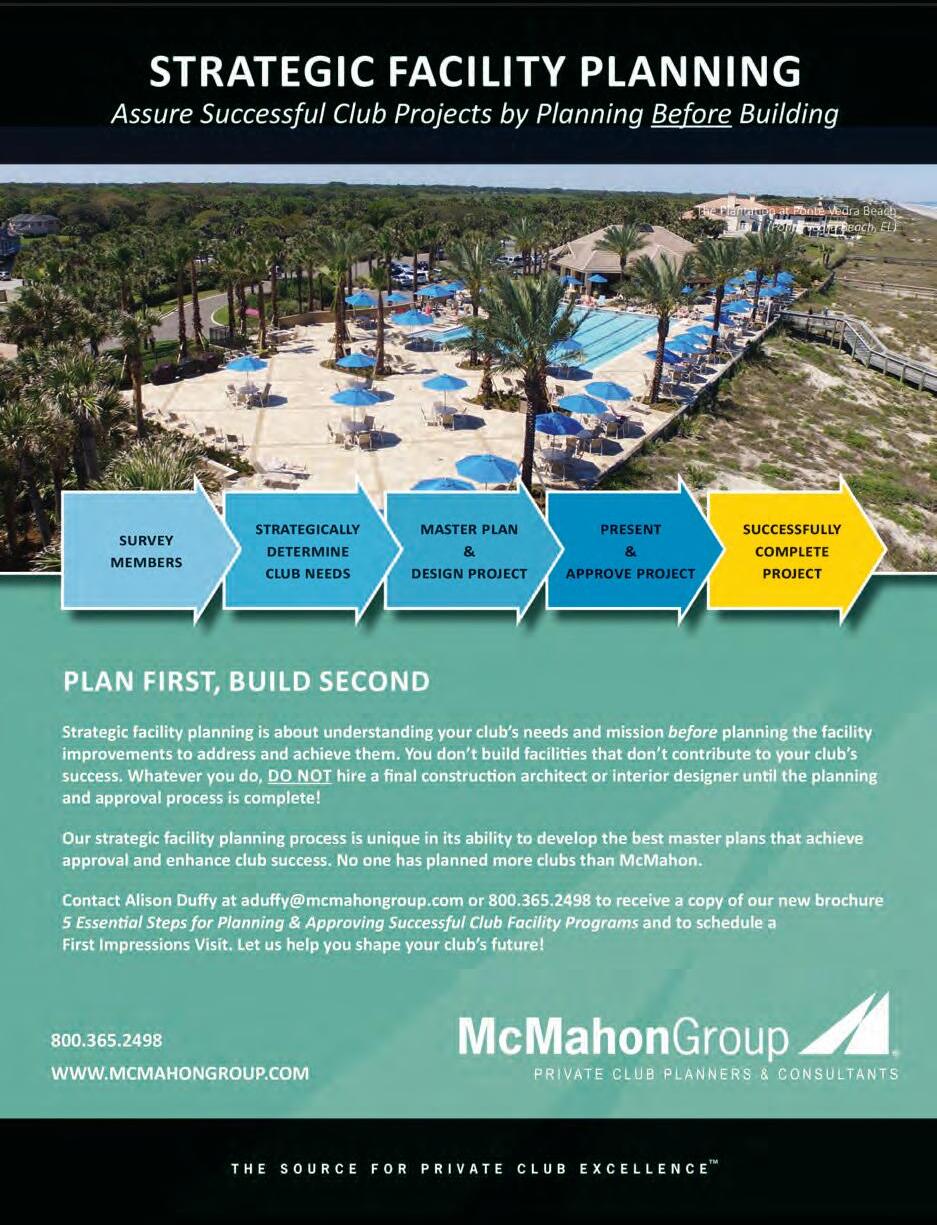
COVER STORY.
Gordon Welch By Dave White
INSIGHTS.
Why Have a Board Meeting?
By Michael Crandal
DISTINGUISHED IDEAS.
By
Heather
Arias de Cordoba
INNOVATIVE IDEAS.
20
24


84 & 85
92, 93, 94 By Heather Arias de Cordoba
TRIBAL MAGIC. .
The Certified Eye Opener By
Gregg Patterson
ON THE FRONTLINES.
Social Media: Recognize the Issues By Macdonald Niven & Rachelle Reali
GOLF DISPUTE RESOLUTION.
Resigning Members Continue To Pay Dues By Rob Harris
Chris Boettcher
of the Drones For Golf Course Design
RESPONSIVE WEBSITE.
ATTRACTING NEW MEMBERS.
PROVIDING GREAT SERVICE IS OUR PASSION. .
38



HEALTH & WELLNESS COMMITTEE.
Use Technology to Spread the Word By Rick Ladendorf
LEGAL
Cyber Hacking is Serious Business - Part I By Robyn Nordin Stowell
Capital Investment – Part I By Ray Cronin FINANCE
If You Build It, Will They Come? By Larry Hirsh
Non-Member Revenue By Mitchell Stump
Understanding Why Greens Go Bad By Dave Doherty
40 F&B SOFTWARE IMPLEMENTATION.
TOP CLOUD QUESTIONS - PART III.
A BETTER MEMBER EXPERIENCE.
42
44
46
Removing Silos Leads to Incentives By Tom Everett
Merging Tradition with Technology By Steve Graves
MEMBERSHIP
The Future for Technology Is Now! By Bruce R. Williams
“That’s The Way We Have Always Done It.” By Dean Wochaski
PASSION FOR EXCELLENCE/COLLABORATION. . . 48 FULLY INTEGRATED TECHNOLOGY. .
CLUB SOFTWARE THAT’S EASY TO USE.
50
52
INTEGRATED APPROACH TO ACA COMPLIANCE . . . . 53
SOCIAL STUDY IN SOCIAL MEDIA. . . .
Club Collateral a Reflection or a Deflection? By Rosie Slocum
Enhanced Team
Strategies By Lisa Carroll & Armen Suny EXECUTIVE
Tech and the Real World of Social Clubs By Frank Vain
Tips to Prepare for an OSHA Audit By Toni Shibayama
EXECUTIVE

Private club boards of directors pose a fleeting presence.
In fact, in most cases, the board goes through a 100 percent change within three years, with usually a third of the board being replaced each year.
This can be a ‘sticky wicket’, because it’s often more difficult for a club to stick to a long term strategy with a short term board. It seems boards are continually taking the Maalox approach… something to deal with the symptoms rather than digging out the root problems.
What to do?

The board has a duty to measure its performance against the strategic plan, as well as the club’s greater vision and mission. After all, performing in accordance with those goals is the point of having them written down in the first place. A strategic plan creates a stable environment for the club’s long-term health, establishing common goals and a common thought process that would otherwise evaporate whe never the board experiences 100 percent turnover.
Skip Avery, EVP at Chambers and past president of the CMAA
The difficulty is that boards of directors often forget why they are there…what their duties should be and how they should fulfil their roles as the guardians of each private club’s future.
Where does it all start? The roles and responsibilities of each board member must be clearly defined after each and every election and what
they should do expands from there. This includes several key questions each board should ask of its members.
For example, do boards have a duty to monitor the board’s performance against a club’s long term plans?
“Absolutely,” explains Tarun Kapoor, a private club consultant with Kapoor and Kapoor Hospitality. “Not only are the boards transitory – temporary guardians of the club, they have to lead the club’s committees who are also transitory by collaborating with them. Moreover, as volunteers, they also have to collaborate with management –the paid experts. And without a strategic plan that the club is bound to, this collaboration will not be possible.”
Ah, the strategic plan, that document that clearly lays out the future direction of the club, a document that shouldn’t change upon the whim of the board’s new president, or personal agenda.
“One of the board’s most important roles and responsibilities is to be the strategic leader, guiding the club strategically,” injects Jack Sullivan who specializes in strategic planning for the industry consulting firm, Kopplin Kuebler & Wallace.
“An active strategic plan is one of the best business tools available to clubs and all of its constituents, keeping everyone focused on longterm goals and objectives. A good strategic plan is not just the board or management’s plan; it is the entire club’s plan,” Sullivan added.
“It’s the roadmap for the club’s future success in an environment that is constantly changing and the membership should be updated regularly on the plan’s status through town hall meetings and correspondence. When discussing strategic planning, one of my favorite sayings is this: ‘The purpose of a plan is not to produce a plan, but to produce results.’”


“Badges? We ain’t got no badges. We don’t need no badges. I don’t have to show you any stinkin’ badges!”
You probably recognize that oft-quoted line from the 1948 film The Treasure of the Sierra Madre. It’s the bandit’s retort when asked to prove the authority he claims for his group of banditos.
His indignation is not unlike that of some club directors who seem to enjoy an abovethe-law status, doubting that certain standard requirements apply to them. In today’s private club environment, their attitude could not be further from the truth.
In fact, private club boards are being held to an ever-higher standard of performance and conduct by members who expect their clubs to be governed in a business-like manner. Every club leader – including board members –should be knowledgeable of four mission-critical documents:
• Club bylaws are the written authority under which the board governs. With that authority comes the responsibility to govern well and to attend to such fiduciary duties as care, loyalty and obedience.
- The duty of care requires that decisions are made on sound and informed judgment.
- The duty of loyalty calls on board members to put the interests of the nonprofit before any personal or professional concerns, as well as to avoid potential conflicts of interest when acting on behalf of the organization.
- The duty of obedience ensures that the organization complies with all applicable federal, state and local laws and regulations, and that it remains committed to its established mission.
• The strategic plan, which is the roadmap to accomplishing the short and long-term goals of the club, should be routinely reviewed as part of the board’s agenda, according to Derek Johnston, partner at Global Golf Advisors. “The club’s primary goals and objectives should be reviewed at every board meeting,” Johnston says.
• The balance sheet also must be reviewed routinely and regularly by board members.
According to Philip Newman, a partner in the trusted accounting firm RSM U.S., “Well-governed clubs know that they cannot afford to have the balance sheet become the parking lot for financial mistakes. They keep a keen focus on working capital, so members can rest assured the lights will be kept on.
“Focus on your balance sheet, understand how to create a realistic budget, put the right management team in place – and then let the members enjoy the amenities – that’s how good club governance should work,” Newman added.
• Form 990 is an informational tax form that most tax-exempt organizations must file annually. The form gives the IRS an overview of the organization’s activities, governance and detailed financial information.
Form 990 also includes a section for the organization to outline its accomplishments in the previous year in order to justify maintaining its tax-exempt status. In collecting this information, the IRS wants to ensure that organizations continue to qualify for tax exemption after the status has been granted.
Every board member of a private club should be fluent in the current Form 990. This is the primary public document that describes the business status of the club … for better and for worse.
Many clubs require all board members to execute the Form 990 as a part of their board duties.
Many clubs are non-profit corporations –even if they are not tax-exempt. They should review and understand key points of focus. Newman points out, “Even if a club is taxable, taking a look at some of the questions on a Form 990 can be a good exercise in staying within the governance guidelines expected of a non-profit entity.
“Too many commentators on club governance seem to focus solely on the relationship between the board, the committees and the GM,” says Newman. “But governance speaks to so much more than that.”


“Belonging matters. Each of us yearns for the tribe: for the affiliations that will support us, protect us, define us, help us make sense of a complex and overwhelming world.” – Allen Blue, cofounder of LinkedIn, from his the recent book, The Membership Economy.
“Memberships only work when based on mutual respect and benefit.”
How fitting for membership in a private club?
The point is that any business that relies on the loyalty and usage of its members can learn from other industries as well. Membership is an economic driver, without which, any membership organization will fail. Understanding the needs of current and next generation of members is crucial to sustainability. Market orientation – What can we learn?
Well for starters, most major membership based organizations are marketing oriented throughout every department, each driving consistent brand and perceptions. This is not by accident. It happens when a strategic organizational philosophy is developed that permeates into every event and activity, and every touch and experience. It happens when the organization is providing relevancies to its entire market spectrum, generationally, for families, for children and for men and women. But what are relevancies and how do they change generationally? And suffice to say, needs and relevancies are more different today than ever before.
It starts with philosophy and the courage to recognize and react to change – All the indicators are there for us, reams of data and statistics support it, clubs that have adapted are experiencing significant success, yet too many clubs still refuse to either accept reality, nor react to the necessity of market repositioning. Those that have accepted change as a reality have succeeded by driving the re-education of their members, changing how they allocate assets, and in reprogramming events and activities to appeal to a broader spectrum of their market, both members and yet to be members.
Clubs are fishbowls – The external market sees everything a club does internally as its brand philosophy. If the club is old and stodgy, the external market or potential member sees that as the way the club wishes to operate. If is appeals to the con-
sumer, great. However, it’s likely that the market for old and stodgy is quite limited. Assuming the fishbowl marketing theory to be true, then it stands to reason that by changing the programming, by offering more generationally, gender and family relevant assets, programs and events, that your brand image will attract a broader cross section of potential advocates and new members.
It can’t be only about the existing members –Keeping existing members happy is a must. But let’s face it, having a more vibrant, activity laden, generationally diverse membership that uses the club frequently, is sending positive messages to the community, building loyalty among all members, and recreating a brand that will be more attractive, ultimately driving new or replenishment member growth.
Discounts, incentives and short-term fixes are a tactic, not a strategy – As an industry - in response to a sagging economy, overbuilding, aging and loss of members - the reaction was diverse.
Unfortunately, many chose the path of discounting and gimmickry and have found that this tactic has resulted in a “revolving door” of matriculation and attrition. Everything in this narrative is leading to a strategic look at core issues that prevent market success - before employing a pricing tactic that can lead down a very slippery slope. If you’ve already gone down that trail, don’t despair. I may take a little longer to recover, but follow these guidelines and recovery will occur.
Onboarding to create loyalty – New members are generally happy members without any baggage. Build a 30, 60, 90 and 120-day program interdepartmentally to follow new member’s usage, build a communication plan that provides for department heads to periodically call and invite the new member to events, and ensure that the entire staff knows who the new members are…going out of their way to personalize the experience.
In Part II, we’ll examine how technology plays a role on delivering what is necessary to drive collaborative understanding, strategy and tactical implementation. BR
Rick Coyne is CEO, Professional Club Marketing Association. He can be reached via email: rcoyne@clubmark.com


We’ve defined perfect food cost, in Part I of this series, as the cost required to provide exactly the amount of food required to meet the legitimate need during the period in question.
And we discussed the path to achieving, or at least getting closer to the perfect food cost. Now we’ll look the procurement section of the path.
Procurement starts with deciding how much food to order. Generally, this is done by the chef or purchaser using a combination of par levels, existing inventory and anticipated demand.
While par levels are helpful, they also build in a bias toward excess inventory, since they are designed to insure stock doesn’t run out. Excess inventory, however, leads to potential loss from spoilage, overuse or theft. All three are significant contributors to variance, and can be reduced by ordering as little as possible.
This can be done by reducing par levels, purchasing in less than case lots, having policies for handling running out of stock, by making sure items are stored in such a way as to preserve shelf life, improving forecasting techniques and taking frequent physical inventories – especially before placing significant orders. Let’s examine some of these more closely.
Par levels can be reduced by keeping them in inventory units – not purchase units. For example: three cans instead of one case. They should also be adjusted seasonally, and there should be no par levels set for items that are used infrequently.
In a perfect world there would be no inventory – the vendors would hand us things as we need them. Adjust par levels to correspond to order frequency, and if possible increase order frequency in order to accommodate lower levels. Absolute best case – eliminate the use of par levels for all but non-perishable items. Purchasing in less than case lots – or split cases as vendors call them – can result in higher prices per unit, but the difference is typically so small the effect is seen three or four decimal places out in the food cost number. Spend a little bit more per item you split and store less. This is especially true for items that don’t turn over very fast.
Many times the walk-ins and freezers are full of items where more was prepared than needed. This could be caused by high par levels for prepared goods, or perhaps from simply buying in the wrong pack size. If a recipe calls for half a No. 10 can, what happens to the other half? Perhaps we should buy smaller cans. If not, we need to be sure we can properly store the half can for maximum shelf life. Vacuum sealing has been used successfully by some clients to preserve shelf life.
The mother of all reasons for overstocking kitchens is the fear of running out. Some clubs have adopted a “fresh is best” mentality and inform their members they intend to run out on occasion so they will have only the freshest ingredients available.
Publishing this policy will help reduce complaints if you run out. Informing members in advance of ordering that a menu item is no longer available eliminates the need to tell a member “we’re out of that” after they pore over the menu and order what they want, and can actually increase demand for that item in the future because of its perceived popularity.
Keeping an “86” board (list of entrée portions left or out) in the dining room for all to see can fit nicely into the fresh is best plan as well.
Notice that none of these concepts involve changing the menu, increasing prices or haggling with vendors to get the best price (although that is certainly advisable), but all will have the effect of reducing variances.
Following these guidelines will certainly keep you moving in the right direction on the Path to Perfection. Next step – inventory management.
If you missed Part I in the July/August issue where we discussed the concept of running a perfect food cost, email me if you would like a copy. BR
Bill Schwartz is the founder and CEO of System Concepts, Inc. (SCI). Based in Scottsdale Arizona, SCI is a food and beverage procurement and inventory management consulting firm and the developer of the FOOD-TRAK System, which is widely used in club operations around the country. Bill can be reached at 480-951-8011 or bills@foodtrak.com.
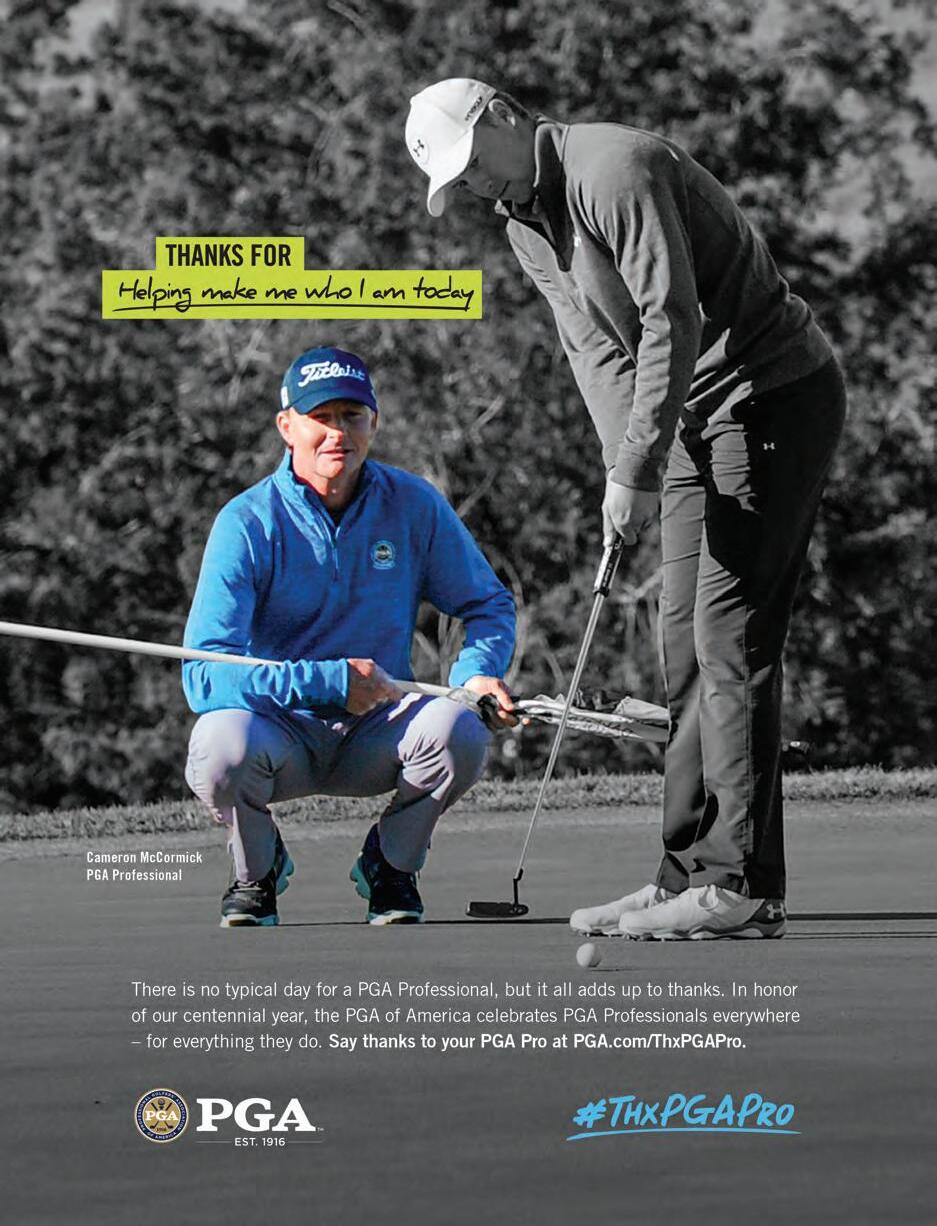

About 10 years ago I read a popular business book, Stephen M.R. Covey’s The Speed of Trust.
His premise is that you can accelerate every business decision if there’s a real sense of trust among the participants.
In today’s political environment, this issue seems to dominant every discussion and it’s certainly relevant for private club boards and their general manager/chief executives.
How do you create an environment of trust in the boardroom, among directors and also with the club general manager/chief executive?
There are three simple strategies I’d suggest to build trust with the GM/CE and three different strategies I believe are effective for building trust among the board members.
With the first strategy the GM/CE should provide a thorough new board member orientation every year when the new members have been elected and before the first board meeting. This is not just a cursory look at the past three month’s board minutes and club financial statements but a thorough review of all of the physical assets of the club.
Additionally, this is an opportunity to meet each department manager, allowing each to showcase what they do all day and how they contribute to the success of the club.
The second allows the GM/CE to demonstrate their ability to understand the “business of the club.” They should know the details of the balance sheet and profit and loss statement better than any board member.
The GM/CE should be viewed as the person who can best explain not only any variances in the monthly financials but, just as importantly, can discuss the trend lines and how they see the future fiscal picture for the club.
The third is “engaged visibility” of the GM/CE in every area of the club. This is critical for not only the membership but also the employee team. People want to see the “person in charge” no matter what size club. The quickest way for a GM/CE to lose credibility/trust in a club is to be invisible.
Those three protocols will greatly improve the trust factor for the GM/CE in any club.
Now, how can the board members build trust among themselves? Again, here are three key strategies.
The first is to insure that board members’ roles and responsibilities are clearly defined. The club president should insist on a “responsibility matrix” that clearly outlines every operational area and who is assigned to each area.
The same should be done for every club committee. This provides for a clear understanding of what the expectations will be for each board member and how they will interact with the management team.
The second board strategy is called leveling This is the honest and open communication at every board meeting where members are comfortable in sharing their candid comments without feeling any restraint because of what other members might think.
Board members are encouraged to give candid feedback on any issue without being judgmental or critical of another board member. This type of open discussion should take place freely behind the closed doors of the board room and not in the dining room or bar after the meeting.
The third trust builder for board members is called unity of purpose. After an issue has been discussed and a course of action has been voted on, the decision of the board should be supported by the entire board.
It doesn’t matter if it was a close vote or unanimous; that’s what the board decided. Period! And when the board room doors open, that decision was a “board decision” as far as any club members or club employees are concerned.
If the club GM/CE and the club board engage these six trust building strategies, the speed of trust will be accelerated in both management and governance. BR
Dick Kopplin is a partner in Kopplin Kuebler& Wallace, an executive recruiting firm providing services to the private club industry. The company has offices in Scottsdale, Jupiter, Atlanta, Denver, Cleveland, Washington D.C. and Naples. Dick can be contacted at (480) 443-9102 or at www.kopplinandkuebler.com

“My goal is to help private clubs by creating a better board that is well informed, well educated and represented.”
That’s the objective of Gordon Welch who is taking over the reins as president of the Association of Private Club Directors, the parent association of BoardRoom magazine.
“Through information, education and representation we will help produce a better run club and improve the communication between the board and the general manager,” Welch explained.
John Fornaro, CEO of APCD and publisher of BoardRoom magazine, in making the announcement said, “Gordon’s focus is on membership and education of club boards of directors…not the clubs themselves, but the directors who are representing the members. We welcome him aboard.
“There is certainly a need for board members’ orientation of their roles and responsibilities, and this will happen through BoardRoom Institute, the online board orientation program. It’s one of APCD’s products.
“Through this educational process, boards will be more prepared for their fiduciary responsibilities, long term planning and their other responsibilities as board members. And the objective is working collaboratively with the club’s paid management…collaborative governance is our goal.”
APCD is the association for private club boards, Welch intoned.
“As such, APCD provides information, education and support so that boards can better govern their club regardless of the size, location or structure. Our goal is to give the general manager and the club the best possible outcome through education of the board of directors,” Welch explained.
“We want to reduce the number of lawsuits in our industry. We want boards to focus on a club’s future…its
long term sustainability and leave the day to day operations to the paid management. Too many boards are trying to micromanage the club and its management team.
“And we know we can have an effect in increasing the average tenure of a GM/COO and their staff through the education and knowledge of roles and responsibilities as well as boundaries,” he added.
Welch comes to APCD with a sparkling resume… including 16 years as a private club general manager, two years as CMAA’s director of education and another six years as senior vice president of CMAA.
“Serving the membership of CMAA for eight years was fantastic – a dream come true.
“But my passion to better educate boards comes from many years of working with boards and also serving as a board member.
“A board’s institutional memory is only as good as the last board, and we often make little use of that knowledge and information. If that board has no training or specific education regarding their position and history of the board, it will flounder. I’ve seen it happen. At that point the board starts making changes that, for example, often affect the integrity of the golf course and there’s often overspending.
“A tool such as APCD and its educational programs gives the board guidelines to help better serve the not only the board but also the membership, therefore assuring a better future for the club.
“During my 16 years as a GM/COO I have seen quality boards and loved serving the membership of these clubs while assuring growth and sustainability in a club.
“Unfortunately, I’ve also seen directionally challenged boards, and also served at a club where the board had no backbone. As challenging as it was, I was forced to have a
board member removed from a club because the board president would not act on behalf of the club. In that case, I wouldn’t allow the club to be sued for sexual harassment and had to make a difficult decision.
“Still, I’ve had thousands of positive experiences, watching members’ children grow up, being a part of their parents’ lives, and watching clubs grow and prosper.”
Welch was elected to CMAA’s National Board of Directors in 1996 and shortly thereafter joined CMAA as director of education. He was a CCM, CHE and member of the Honor Society.
COVER STORY BY
DAVE WHITE
general managers being replaced every three years. That’s why APCD is a perfect fit for me.
“I understand all sides of this equation and have served in all of these capacities. I want to assure general managers that I understand their roles and am there to help. I want the board to know there is a better way to govern the club…that it can be done collaboratively and effectively.
Board training for APCD will be done through BoardRoom Institutes’ online training program.



“One of the annual discussions during that time focused how to help board members be more aware of their roles and how to reduce the fear of
“Our training at APCD is the best, most effective, trackable education on the planet. The BoardRoom Institutes’ training center touches on many club issues,” Welch expressed.
“It ranges from something as simple as the types of clubs and ownership and club structure and governance to the role of the president (and all of the executive committee and chairs), to fiduciary responsibility and strategic planning.
“We have the best in the business training your board and the best part – you don’t have to fly someone in, pay them to schmooze you for a day and leave with their big fat check! As a member benefit the BoardRoom Institute is included for all of your board members and committee chairs!
“As club leaders you want to make sure your board members are doing their homework and through the dashboard of the institute you can track who has logged in and completed their work and who hasn’t. It’s a great tool for any president or GM,” Welch added.
In Welch’s opinion, general managers will benefit as well.
“The GM benefits through proper understanding of the roles and the training APCD provides. The GM will be able to go through the same education as the board members so there is no misconception of what we provide. We are not out to trick anyone or upset anyone. We are here to give proper education.
“Our education tells board members about their roles and responsibilities, and that what they do doesn’t include micromanagement. In fact, we tell the board members that daily operations are the responsibility of the GM/COO and their staff. I would never suggest a board needs to be involved unless there are inconsistencies. Even with a discrepancy the board should stay out and have a professional review of the issues and make an educated decision,” Welch opined.
“From my own experience, the ability to work with a knowledgeable and well-informed board is priceless. A professional, mutual respect is the basis of a well-run organization. There is no bigger liability than an unqualified, disrespectful and underprepared board member. If you give us a chance, we will change that for your club.”
What does Welch see as today’s issues?
“Today’s issues are changing with generations. While we still see timeless issues of food and beverage or service, we see a greater challenge with young employees. There are high expectations and no dedication with many of today’s college grads and part of the private club is based on dedication and discrimination, “Welch explained.
“Other issues are as basic as, ‘What is my job as a board member?’ What do I do as a committee chair? How do we deal with board conflict?
“We continue to see clubs file for protection through our bankruptcy courts. We see golf continuing to drop off and we see clubs prostituting themselves to get dues income.
“In the coming months we will see the effects of world oil prices, the new world economy and a change of US Presidents having an influence on our cities and states.
“Clubs must hold true to themselves. Be who you are and what you know and what you are known for. Plan for or make policies on LGBT issues, equality in the boardroom and member conflict because they are coming to your club, if they’re not there already. It will happen in our industry.
“I do see a turn-around for clubs. As the GenXers age they will want some form of privacy for their families. It may be on a smaller scale, but the privacy issues will win out, “ Welch added.
“However, I think the pain that APCD does remove, and the problem, APCD can solve is trust. We must remove the lack of trust between the board and the general manager, staff and club members.
“This we can solve through the BoardRoom Institute One of the new modules is going to be around better communication and trust,” Welch expressed.
“Club leaders need to understand that making staff feel safe on a deep level is a first priority, and I don’t mean sit down with the team and have a nice chat. That doesn’t build the type of trust that your club needs to be an effective high-performing club.
“In a recent Harvard Business Review a research study showed trust between leaders and their people is absolutely necessary in order for safety (trust) to exist and, ultimately create that high-performing team. Trust is formed by in-depth conversations backed-up by positive actions. Doing more than you promise is a highly effective tool.
“This,” Welch injected, “leads me to another module I want to produce … the annual transfer of power and expectations. When there’s a transfer of power (a new president coming on stream), the past president is sent out to pasture to do nothing, and these people have so much knowledge. The past president goes from knowing everything and daily contact with most everyone to nothing.
“We need to address this because taking advantage of the past president’s knowledge can be a huge benefit to a club and GM. I also think ethics and equality in the boardroom are often issues we need to address.
“We can’t play Doctor Phil, but I do think we can have an impact on the longevity of the GM through discussion, education and development of trust. Some GM’s are gunshy and just don’t have trust. With the board members and general managers trusting in each other, we can get there, “ Welch added. BR
Gordon Welch can be reached by phone at: (918) 914-9050 or via email: gordon@gordonwelch.com






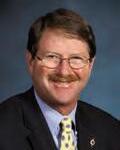

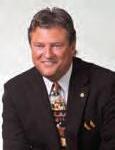
MICHAEL CRANDAL, CNG
One of the most telling mistakes a club can make unwittingly is to seldom have board of director meetings.
Many sitting on club boards right now are tempted to immediately turn the page and read another article as this one surely doesn’t apply to them − since they know the many hours they spend at each of their 10-plus monthly meetings every year. Plus, the first sentence just doesn’t seem to make much sense. Huh?
(Go ahead. Read it again. This time a bit slower.)
Here’s the underlying question: “Is your club truly having board of director meetings − at all?”
For those in club leadership positions to seriously formulate an answer – start by asking why your board meets. Some may wince. “Well, I suppose the real reason why we have board meetings is because it’s been about 30 days since the last one.”
Healthy clubs with strong governance policies and professional management are easily identified by the quality of their board meetings. They work seamlessly together with predictable results of focused and productive meetings that seldom last more than 90 minutes.
The majority of ‘work’ is accomplished at the committee levels between board meetings – not during board meetings at all. While committees are advisory only, management closely coordinates their input to make sure all suggestions are operationally sound, fiscally responsible, and most importantly, in keeping with the policies established by the board.
Only those committee chairs fully prepared with a formal report and/or a request for board action on a recommendation are included on the board agenda. Approved recommendations are then delegated to management with the full authority and responsibility to achieve the desired ends by any means within approved club policies.
Near the top of every agenda, the GM/COO presents an executive summary touching upon the entire operation with proven reliable data and timely information. This report is comprehensive and yet concise enough to seldom require more than 10 minutes of board time. In order to keep
any questions and answers focused, the club president personally reviews the executive summary and then it’s emailed to the entire board several days before the meeting.
With the club having a policy of no direct board role in day-to-day club operations, and being supported by capable management, rambling and unproductive gatherings every 30 or so days are replaced by a board that truly functions as a board, rather than a big unwieldly committee.
When it comes to club operations, the board has one employee. The GM/COO has all the others.
This model enables the board to focus on the larger issues, to delegate all departmental operations to the GM/COO, to direct the expectations of management without meddling, and to effectively truly lead the club and membership into the future.
Meaningful board of director meetings become predictable when:
1. The board never assumes the responsibility of doing work that should more appropriately be done at the committee level between the board meetings.
2. The board has a policy of no active role in operations other than delegating the full authority and responsibility to management who is then held accountable.
The highest and best use as a board is to thoughtfully consider policies and issues that are timely, thoroughly developed, “scrubbed down” by the appropriate committee and management in advance, and then presented to the full board for action.
Thank you for not turning the page all that quickly. Because of that we can now call the next meeting of the board of directors to order. BR
Oh, and one more thing, just in case you're wondering. The letters after our author's name Michael Crandal, CNG stand for: Certified Nice Guy. Self-certified, by the way. But, a nice guy nonetheless. Michael presents leadership, operations and business ethics presentations. He and his wife, Kim, reside in the Buckhead area of Atlanta, GA. (760) 464-6103 direct www.linkedin.com/in/michaelcrandal





When it comes to a department that can really bring the “wow” factor to your club, look no further than your member events/food and beverage department!
This department brings together every membership type in your club – golf, tennis, social, yachting, athletic. What do they all have in common? Everyone enjoys a great meal, fun times with friends and other members and a great party!
Designing a dynamic member events calendar does not just happen. It takes careful consideration and a determined sense of creating memorable events that are not-to-be-forgotten, create a buzz and bring the “wow.”
The first step is to take a look at how you are creating your annual calendar of member events. Use every resource you have to design a calendar that appeals to every aspect of your member’s interests and demographics.
Ideas can come from just about anywhere, but make sure that you are using your member committees such as the social committee, wine committee, “kids” committees, etc. Also, member focus groups as well as the information you collect in your member profiles and surveys are a great place to garner ideas for what will interest your members.
Staff brainstorming sessions and creative partner (vendor) brainstorming sessions are invaluable when trying to create events that are trendy and different from your typical traditional events. Using your vendors to brainstorm is an extremely underused resource. They are typically very current with event and food and beverage trends and can help you create events that create a buzz among your members.
Other considerations when creating event themes can be:
• Traditions versus special events – have a good mix of traditional and new!
• Age group – have separate as well as combined events that appeal to all prevalent age groups in your club
• Seasonal/time of year – some traditional events are “timeless” and can appeal at any time of year, but take advantage of events that are seasonal. Our members like to live in the moment!
• Personal interests – events should appeal to what interests our members most. It ensures a higher attendance and lets your members know you are in tune to their needs!
• Club branding – everything you do should reflect the club’s culture and branding.
• Trends – always build events around the latest in culinary, fashion and sporting trends. Events like a Lululemon trunk show; A bocce or pickleball tournament during a dinner event; adding on an olive oil tasting to a traditional pasta night with a specialty olive oil company; a craft beer and food pairing with a beer sommelier, and super-hot right now, pop-ups! A “popup” event can be a dinner event, summer “treat stands” around the pool, coffee/juice bars, etc.
It’s a temporary, seasonal event that takes place unexpectedly and with a sense of “whimsy.” Pop-up dinners can take place in an unexpected location such as a rooftop, driving range or dock or with an unexpected twist such as a local, celebrity chef. The possibilities are endless! It does not have to involve a dining event –it can be a retail boutique shop pop-up!
Your member event calendar is an exciting way to bring fun and relevance to the club and impact retention at the same time.
An involved member is a happy member! Create your events around what your Members love and what sounds exciting and fun and you are sure be the club that everyone wants to join! BR
Lynne LaFond DeLuca is the executive director of the Association of Club Catering Professionals and a private club industry consultant. In 2014, Lynne was named “One of the Most Influential Women in the Private Club Industry” by Boardroom magazine. You can reach Lynne at Lynne@TheACCP.com, or visit the website www.TheACCP.com.
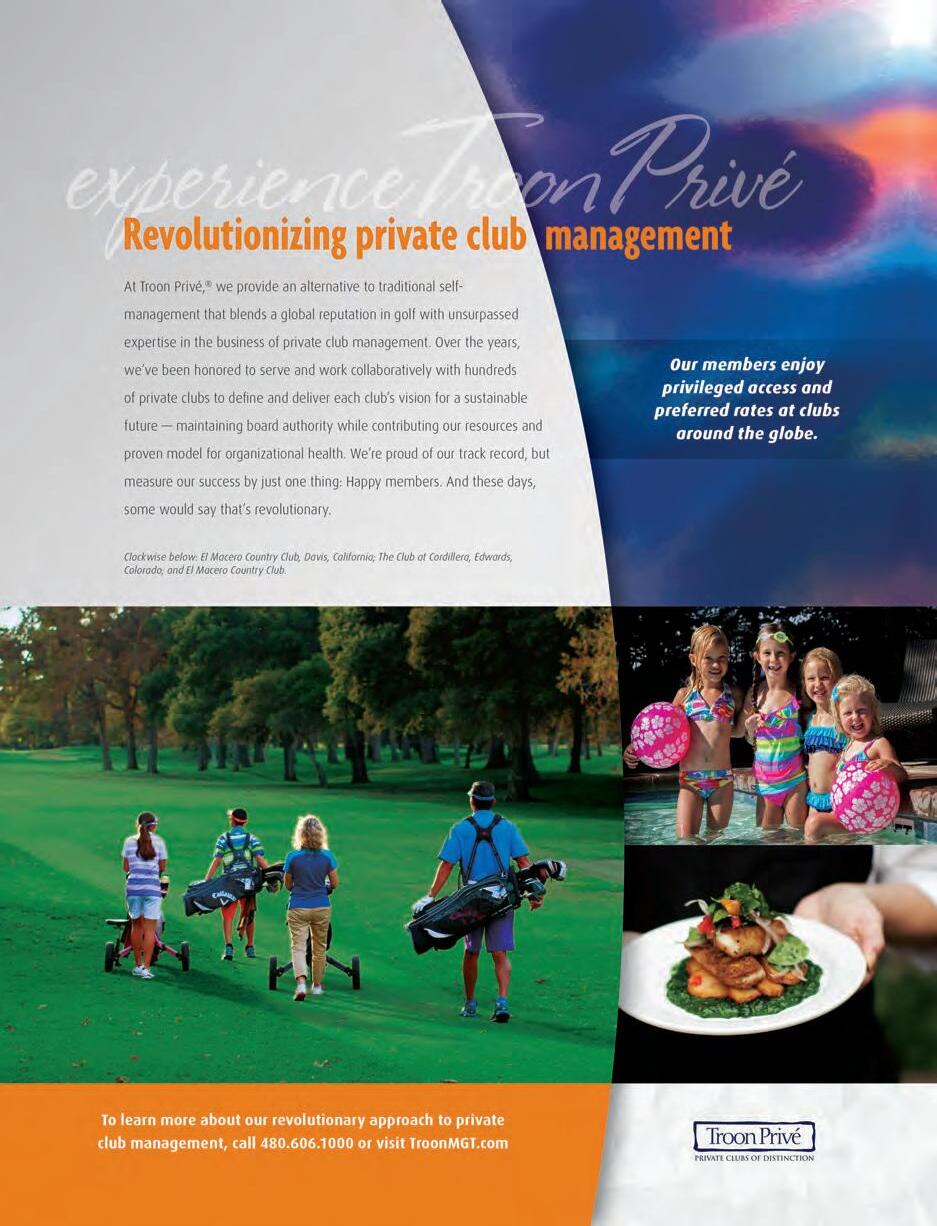
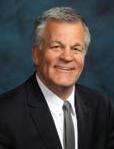
Some months ago I visited a Ritz-Carlton executive chef who had recently converted a recycled freight container into a hydroponic garden.
The unit, located in the back parking lot, grows nutrient-dense, pesticide-free, fresh greens, micro-greens and specialty herbs all-year long.
The concept of growing food hydroponically using artificial light in a controlled environment is not new. What is unique is the automation using multiple sensors to monitor air and water temperature, nutrient balance, lights, fans, pumps, Wi-Fi, access and of course, the hydroponic system.
The Ritz-Carlton story has received over two million views, the chef has become a rock-star and guests are involved in the dialogue, all without spending a single dime on advertising. And everyone knows, earned media is much more effective than advertising and since equity clubs cannot advertise because of their 501(C)7 status, earned media is the best choice when it comes to attracting new members.
The private club industry could learn from this strategy as a way of attracting new members, especially the Gen Xers and Millennials.
So how can an equity club generate free earned media and why does it matter to the sustainability of the club or for that matter, the viability of the private club industry?
First, you need a good story the media would consider “newsworthy.” Submit the news/press release to PR Newswire and it will be distributed to thousands of media outlets.
The story may appear initially in the local newspaper, and with a little luck will get pickedup by hundreds or thousands of digital publications domestically and internationally. Millions of people from a variety of sources are exposed to the article and many readers may become your next social or full-member, new homeowner in the community, a potential employee, service provider or an influential community member.
So what’s your story and is it newsworthy enough to generate free press?
Do you have an employee wellness or farm-totable program? Have you adopted a water conservation program using the latest technology to control water consumption? Are you composting
and are you in compliance with state regulations? Are you harvesting honey from bee-hives?
These stories offer great content for local papers because they are good for the community, the industry and mother earth.
With many in-depth interviews with hundreds of private clubs, we have documented dozens of newsworthy farm-to-table and wellness stories. For example:
• Woodfield Country Club, Boca Raton FL: The herb and vegetable garden harvests over 3,000 pounds of fresh produce, hosts garden parties, features menu items with the Woodfield Garden logo and has incorporated wellness as part of their culture for both members and staff.
• Wycliffe Country Club, Wellington FL: Implemented a Wycliffe branded mobile app to engage the staff in wellness activities. Push notifications are sent to the staff members’ cell phones and provides two-way communications, improved engagement while at the same time reducing the number of employee inquiries.
• Bella Collina Towne & Golf Club, San Clemente CA: For many years they had a showroom garden where they invited the community foodies to stop buy on Saturday mornings to buy fresh local food. The local papers wrote multiple articles that generated dozens of new members and the membership director was there every Saturday morning to discuss membership related questions.
• Spring Island, Okatie SC: Every spring, the club plants a multiple acre garden, where members and staff can pick what they what at no charge. The chef uses the ingredients on the menu and members love to pick fresh, pesticide free locally grown food.
Technology is helping clubs grow local, pesticide-free food, manage employee wellness and most importantly reach prospective members where they live work and play. BR
Rick Ladendorf is the president of Prevo Health Solutions, a wellness solutions provider and Executive Producer of the AMERICA’S HEALTHIEST CLUB© wellness rating program. For more information about hydroponics or mobile apps contact Rick Ladendorf at (949) 933-5470 or rladendorf@prevohealth.com

Isn’t it time to start curing the problem, instead of treating the symptoms?
Don’t get trapped in the recurring cycle of discounting and gimmicks to recruit new members. Instead, address the root of the problem by solving the issues that are preventing membership growth and retention.
Too often clubs address the symptoms, yet in nearly every case, the symptoms return.
Call us or visit our website to sign up for a complimentary consultation and start the path to your membership cure today.



BOB BODMAN
It’s 2004, and the general manager is reading a just completed comprehensive set of the club’s operating standards. She said to me: “Do you know how many documents are referenced in these standards?”
My answer: “No, I never thought about counting them before now, but I will.” Turned out to be 320 separate documents.
When I reported back the count and a complete list, the GM looked at it and asked: “How would anyone know how to manage all of these?”
The obvious answer is “nobody”, however, each department head would theoretically manage their own respective department’s documents…at least in theory.
This little rabbit trail caused me to start thinking about all of those documents. And, really, how can a general manager wrangle all of these documents into a semblance of order, keep track of them, hold people accountable, keep them up to date, accurate and useful to the organization, or, conversely, weed them out of the club if they were not useful.
So I started to look at documents more as items, assets, pieces of equipment, or even boxes of cocktail napkins or bottles of wine.
I like the bottles of wine analogy best. Each one has a purpose, each is different from the other, even when they are similar, each one has value, each is identified with important information and each is perfect for the right application (time and place) to be useful. Using the wine bottle analogy, the subject club had the equivalent of just fewer than 27 cases of documents (a document is a bottle), and some probably more valuable than your average bottle.
Thinking of documents like items that you might inventory, I also started to look at them as items to be catalogued, identified, quantified and qualified…each one with its own dossier of information.
Taken to the extreme, you can even give each one a score in terms of importance to the organization and to its condition. You can also assign an expiration date or a date to assess its condition and value. Some documents, such as permits and licenses, have expiration and renewal dates.
Computer hard drives once provided a partial solutions for storing and access, but most documents were not in digital form at that time. Although
upgraded systems can handle the new capacity demands, the hard drive is not the right solution.
Fast forward to today, and after 20 years of technological advancements, we now have the “cloud” to store things like documents, pictures, files, movies, audio files, etc., and we leave the wine bottle analogy cellared.
Cloud technology has changed so much of how we do things, especially with “apps” that make it possible to run applications in the cloud as well. Programs like DropBox, have allowed individuals and companies to securely store their important files for very little cost. However, they have limits and provide only a partial solution for the daunting problem of managing our 300-pkus club documents.
To manage documents effectively, staff members need to find them quickly and easily, view them, download them, print them, revise them and send them. They also need access from their mobile devices.
Access and control of documents also extends beyond the club staff. Board members and some committee members also need access to certain club documents, such as bylaws, rules, capital reserve study, strategic plan documents, budgets, audit reports, committee reports, etc. They need access during board meetings and at home or office. This is where the cloud-based systems really provide a great solution.
The most effective system for managing club documents is a convenient, secure, club-specific, cloud-based, integrated database system that provides information about each document, who is responsible for it, where it is located, when it was created, when it expires, or needs review or revision. It needs to provide calendar notifications and email alerts, and provide security with permissions.
Club Resources new StandPoint system integrates a powerful reference document manager with online customizable standards of excellence, project management, member survey metrics and digital board meeting modules. BR
To learn more about Club Resources’ StandPoint system, visit www.StandPoint.club contact Bob Bodman, president of Club Resources at (800) 267-6758 or via email: Bob@ClubResources.com.
Interesting discovery during the past few years while we’ve been helping clubs decide what to do about their “old” club management software (accounting, POS, reservations, etc.).
Most often the initial conversation with the general manager or chief financial officer finds them saying something like, “We really need to get off XYZ software and onto one of the newer systems.”
The discussion then heads into a laundry list of dissatisfactions and annoyances with the legacy software, culminating with, “So what should we do?”
Used to be the answer was simple: perform a requirements assessment, create a checklist of key features and functions needed, compare and evaluate three or four newer systems, and make an informed selection.
But times have changed. The feature and performance gap between older and newer systems isn’t what is used to be. And these days many of our clients are choosing to sit pat with what they have and improve it. Here’s what they’re doing.
1. Training, training, training. Very few clubs purchase any user training after their software is initially installed. Five, 10 even 15 years pass and still no training. Often we find that literally no one at the club was around when the software first launched, and thus no member of the current staff has received any formal training.
Our assessments commonly reveal 75 to 100 or more “deficiencies” (as reported by the staff and identified by us) that can actually be resolved through user training. Think of that –75 to 100 or more improvements that can be made to the software simply by getting users up to speed on how the software works.
And wouldn’t you know it, following that training users report that they’re much happier with the software! And maybe not so anxious to turn their lives, and the club’s operations, upside down by installing a whole new club-wide suite of software modules.
Of course this training isn’t just a one-time project. To be effective, all key new hires need to be thoroughly trained during the first week or so on the job, and everyone else should receive remedial training at least every other year. Good idea to put the needed dollars in the budget –and replenish them every year.
2. Getting proactive with vendor support. Almost all clubs have the notion that the software vendor should be proactively involved with their account, tracking issues as they come up, pursuing resolutions in a timely manner, and generally making sure that the club’s users are kept up-to-date and happy.
Unfortunately, that rarely happens. For the most part in the private club industry, software support is reactive. Clubs that wait for or expect the vendor to take charge are routinely disappointed. There are many reasons for this reactive situation (none of them good) but the bottom line is this: If you want your software issues to be addressed properly and timely, you have to take charge and be proactive. Here’s how to do that:
a. Mee t with the key users in each club department and create an issues list of all items of dissatisfaction. (This list should have been started the day the system went live, but that’s water under the bridge now.) Organize the list by department and commit to keeping it current by tracking the status of each item. Add items as they occur.
b. Assign a single person to be responsible for keeping the issues list current and in front of the vendor. Not a committee – not each department tracking their own issues. Just one person who can own this responsibility and stay on the vendor.
c. Provide the issues list to the trainer(s) so they can be sure to address them when they provide the user training (see a. above).
d. Always assume that your vendor’s support will be reactive, that they are not keeping track of your issues, and that if you don’t review your

BY RONALD F. CICHY, PRANEET RHANDHAWA AND MIRAN KIM
In a private club, the members are the ones who participate, receive, and determine if innovations are worth the effort.
Those who own a stake in the private club decide the worthiness of effort, and to think and act like the owner is the number one priority.
The new ways of thinking leading to innovations in private clubs will be met by members who are deeply attached to the legacy, the ways that the club has always done business, the consistent, predictable activities, experiences, and ways of operating.
Private club boards of directors are looking for desirable ways to balance the opportunities for innovations with the deeply rooted legacy ties of some of the members.
In our latest research, members are increasingly using technology to enhance their communication with their club. Members expressed the ease of using technology for making dinner and golf reservations, along with getting club updates through smartphone applications, as an added benefit to their overall membership experience.
Internet-based reservations for golf, tennis, dining are in demand. This results in faster, more reliable reservations, and the ability to track your schedule, as well as others.
Private club members expressed their desire to stay connected and up-to-date about club activities. They reported that receiving weekly emails and Facebook updates keep them in the communication loop, and they do not feel that they are missing out on events.
These members say: “Increase email newsflashes to keep me informed almost immediately of traffic conditions and weather, and such.”
Private club GMs/COOs have reaffirmed that technology is tied intimately to communication. They feel that communication via social media such as Facebook adds a tool for reaching out to their members and encouraging members’ participation in the club.
GMs/COOs believe creating a website that communicates the vision and mission of the club is an effective method for communicating about the club. Some also find
the use of different online software as a way to encourage members to use the club facilities more frequently.
Many clubs have seen an increase in member participation after launching online booking and payment options. This quote from one of our respondents, “The uses of social media, blogs, and mobile services for the website have improved our communication and engagement amongst the membership”, backs that point.
Communication via technology within the club’s facilities, and particularly on the golf course in country clubs, must be addressed. Are there areas (e.g., locker room, dining room, golf course) where the use of cell phones is strictly prohibited?
Is shutting off your phone required? Do some members want to avoid totally being connected via technology at their club so they can enjoy a quiet family dinner, golf with the family, a night out to the pool for the family?
Some of us long for that experience of shutting it off, to be with the people present, and communicate faceto-face. Yet these same members are linked through technology to their family members and business associates. They are also connected with the other owners of their club.
Technology is capable of building emotional connections with members helping these owners feel even more connected to the club. These connections deepen the culture, define the value added by the club, co-create experiences with members and partners (staff, supervisors, managers), and add value by enriching the members’ lives.
As we all better understand members’ needs, wants and expectations, the possibilities for technology to enhance the private club experience become endless. BR
Ronald F Cichy, PhD, O.M. is professor, The School of Hospitality Business, Michigan State University. Praneet Rhandhawa, PhD is assistant professor, department of marketing and entrepreneurship, University of Baltimore and MiRan Kim, PhD is assistant professor, the School of Hospitality Business, Michigan State University.
Every day, in each one of our clubs, we are constantly challenged to evaluate new and emerging trends, technologies and efficiencies to determine the best ideas.
Big Data, which is not an emerging technology unto itself, but an amalgamation of many other technologies, software and instances of interactions, is not the wave of the future or some far off fairy tale.
It is already here, all around us, permeating every facet of our club’s business. These data are ubiquitous, and some of us may be collecting a portion of it, categorizing it, or even using it productively, but it is with little doubt that we are working with a mere fraction of the possibilities.
Let’s take the idea apart:
Data is simply the collection of all interactions and transactions between man and machine and machine and machine.
It becomes Big when there is a lot of it.
The amount of data today that is being recognized is redefining the way our clubs shape their business, design their member spaces and allocate their technology dollars. So much so, new “PEZ” dispensers are being created to handle all of the data that will be created.
We have all heard of gigabytes and in most cases, our clubs have been purchasing terabyte drives to handle all of the current data loads that exist today. Enter the “PEZ” dispensers of the future or the new:
Petabyte, Exobyte, and, of course the Zanobyte - Memory units and subsequent data storage drives to handle the data.
The amount of data that will be available will simply be SO massive that these new units need to be created in order to handle it all.
I only doubt that you will need to pull back Darth Vader’s head to retrieve the data but you will never know.
To help us understand where all this data is coming from in a typical day at our clubs, let’s take a look at four key metrics:
1. Volume – Think about this simple question: How busy is my club?
As we ponder this question, we need to think about what that really means as it truly includes all
foot traffic, POS transactions, golf rounds, emails, reservations, all things social media, member payments, survey responses, inquiries and so on.
2. Velocity – How fast are these interactions happening?
3. Variety – Where are these transactions coming from? POS transactions from F&B, POS from retail, member payments, dining reservations, tee time reservations, event reservations, lesson reservations of all types and their associated payments, iPad transactions, smart phone transactions, mobile kiosks, RFID and social media (Twitter, Facebook, Instagram, etc.), surveys, etc.
With the growing adoption of location-based services through the use of low-energy Bluetooth beacons, we will see this variety and the subsequent flow of data points grow exponentially, based upon the adoption and deployment of these sensors. This overall list of elements will only continue to grow as the technology and our club’s adoptions of it continues.


4. Veracity – How certain are the data? Since “data” is the very foundational building block of all of our future strategies, they must be factually certain – and moreover, our belief in them must be true.
It is a seemingly strange concept, but if we are not completely convinced that the data are completely accurate, then we will always be tempering our decisions based upon the notions that maybe something might be slightly off. Going “all-in” is essential, and that can only be done if we believe in the data. Evaluate these four metrics either loosely in your head or through your club’s business intelligence module and you will quickly know how much data you are missing.
Once you reach for Mr. Vader and begin processing the data, you enter the realm of prediction – and in prediction you will find the true panacea of member satisfaction. BR
Jim Wisniewski, director of sales - Midwest & Mid Atlantic US, Northstar Technologies Inc. For information, contact Jim at jim.wisniewski@globalnorthstar.com or at (888) 240-3501. For more information about Northstar Club Management Software, please visit www.globalnorthstar.com.


Over the past several years, BoardRoom magazine has offered space in this particular issue to companies that provide a wide range of technology solutions to the club industry to tell their story.
For all of those past issues, ClubTec and Clubster did just that...told you our story and provided you with our pitch. This year we have decided to take a different approach to better help you learn about our companies and how we are serving our client clubs. We are going to use our allotted space to let a few clients tell you about us, and how we serve them, in their own words.
“We are so pleased to have partnered with ClubTec and Clubster. We needed to convert from Jonas to a more customizable POS system and club accounting software. ClubTec thoroughly understood our objective, and created a solution that we have used extensively with virtually no bugs. ClubTec continues to be responsive as we further learn all the great features of this system. The new implementations are quick and accurate, and we are grateful for such expertise and fast response. Clubster has allowed us to move away from Constant Contact and create a club communication that meets the needs of our entire membership. The line of communication to our members has never been better. Thank you to all the ClubTec and Clubster staff who’ve helped us reach our goals with their continued support and seamless integration.”
Greg Griffin, general manager, Rolling Hills Country Club, Texas
“For 17 years our club has relied on ClubTec for all our club software needs and they have never let us down. Their accounting, POS system, catering and pro shop programs are rock solid dependable. Our partnership with ClubTec gives us an extra dimension in the service we can offer our members. Whether it’s ClubTec software, Clubster or WebTec, we exploit all their products to enhance our performance in service to our members. We consider ClubTec part of the White Mountain Country Club family.”
Geoffrey Williams, general manager, White Mountain Country Club, Arizona
“We’ve used ClubTec for the past eight years and we couldn’t be happier. Their support is incredible, and they train our staff. The POS and event management systems are very easy to use and our membership loves the Clubster app. Thank you ClubTec and Clubster!”
Chase Walker, general manager, Cottonwood Country Club, Utah
“To us, ClubTec is the most up-to-date software system in the industry. It outperforms any system we tried at our club, hands down. You can find out anything from food cost to deleted tickets at a snap of your finger. Clubster is a great app that we use to let our members know what’s going on at our club on a daily basis; it’s simple and quick. One touch of a button and it sends push or email notifications to our members highlighting various specials we have, upcoming golf tournaments or other happenings going on at the club. It’s a valuable tool for our business.”
Cliff Carter, general manager, Meadowbrook Country Club, Arkansas
We hope you enjoyed reading what some of our valued clients have to say about how ClubTec and Clubster take care of them. Unfortunately, due to space we can only provide a very small fraction of our complete family of clients...hundreds of clubs strong. Please call us anytime to discuss your technology needs and challenges. We are here to help you in any way we can! BR
Donald N. Williams is the CEO of ClubTec and Clubster. For more information, please contact him at (800) 800-5506 or by email at dwilliams@clubtec.com. You can also visit our websites www.clubtec.com and www.clubster.com
The Bald Head Island Club is a beautiful oasis located among the North Carolina Barrier Islands that offers the ultimate island lifestyle.
Pristine beaches stretch for 14 miles, making this a perfect retreat for anyone seeking the finest golf, dining and other activities.
Robert Norton, general manager and Dawn Jackson, director of communications/IT, had a clear mission to capture the essence and luxury that Bald Head Island Club offers its members and their guests. A major step for them was redesigning their website for a more modern feel that also gives the club a greater online presence with the best technology available.
“We wanted a website that was unique to Bald Head Island Club. The website needed to be an extension of our club. Bald Head Island Club is unique and I believe there is no other club like it, so we felt the same about our online presence… it must be UNIQUE. We also made responsive design a requirement of the project and found a partner in Northstar who was able to provide the responsive design. We did our due diligence for sure on this project and the end result I believe illustrates that,” says Norton.
The club identified the following key requirements for their website project:
• Responsive and custom design with creative flexibility.
• Fully integrated product with reservation engines and member management portal.
• Club engaging member app for club activities, events, reservations and notifications.
Jackson led the project and worked closely with the Northstar Connect Design & Implementation Team. She worked diligently to ensure she provided high quality photography and a new lifestyle video to showcase the club’s innovative vision.
“Both the club and Northstar put the effort in to create an unbelievable product for the club,” says Jackson. “Northstar was able to provide us with cutting edge responsive design, an easy-touse website content management system, seamless experience for members for online reserva-
tions and the option to offer a member app. It’s the all-in-one system we wanted and it all works! We no longer have to be concerned about integration issues and we didn’t have to compromise on product. The direction and support provided by NS Team was exceptional.”
BHIC will implement Northstar’s ClubNow member app in 2017 as an expansion to their original online initiative. ClubNow, available at both iTunes at Google Play marketplaces, will create an exciting new platform for the BHIC members while increasing the speed and accuracy of information and communication between
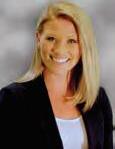

membership and the club. Location Based Services with Beacon Technology along with the other features of the app will form an ultimate technology and communication ecosystem to enhance the overall club experience and membership satisfaction. BR
This article was submitted by Alyson Stevenson, director of sales – Southeast region, Northstar Technologies Inc. For questions, contact Alyson at alyson@globalnorthstar.com or at (703) 244-0620.
For more information about Northstar Club Management Software, please visit www.globalnorthstar.comor email info@globalnorthstar.com
For golf and membership information at BHIC, please visit www.bhiclub.net or call (910) 457-7300.

“I could try to explain to you why choosing the easy and least expensive option for a club website costs the club more than a few dollars, but hearing it directly from a happy client — Elgin Country Club (Chicago) — is a more powerful message,” Ray McDonald, EVP sales, Clubessential.
Elgin’s former website, provided by their accounting/POS vendor, was an inadequate tool for retaining existing members and recruiting new members. Recognizing this problem, Elgin’s board asked Mike Andelman, a member with 30plus years of business technology experience, to lead evaluation, selection and implementation of a best-of-breed website platform.
“Our previous website did not serve the members at all,” recalls Andelman. “Our former website vendor was more focused on its accounting product. Website support was barely an afterthought. They didn’t recognize the value of an effective web presence.”
High on the list of requirements was a website provider offering a modern platform with ongoing support/enhancements, who would be a true partner. After reviewing several options, Elgin determined that Clubessential would deliver the strongest online presence and ROI.
PARTNERS WITH CLUBESSENTIAL TO OPTIMIZE WEBSITE FOR MEMBER CONVERSION AND ENGAGEMENT
Andelman recognized that for existing members, the private side of the new website had to be “all things Elgin,” and the public side had to effectively promote the club to prospective members. His team was aided in accomplishing these goals by partnering with Clubessential’s M3 marketing team. M3 understood which keywords would best optimize the website for search engines — a fundamental requirement to effectively support all aspects of Elgin’s marketing programs.
The new website engages members with fresh content, along with a Clubessential-powered dining reservations engine that makes event registration easy.
“The previous website platform lacked tools for maintaining important information,” says Andelman. “Clubessential’s capabilities have solved all of our problems.”
New General Manager, Douglas Stewart, CCM, was also happy to see Elgin partner with Clubessential: “When hired on as Elgin Country Club’s GM/COO on July 1, I was delighted to see the club had contracted with Clubessential for their website platform. Having worked with Clubessential at my two prior clubs, I have witnessed firsthand the benefits it can provide. I have found this product to be the best in the industry to address the challenges clubs are facing today as it pertains to member recruitment, retention and communication. I believe a club’s website must become the heart and soul of what is needed to define new programs, marketing, and member participation.”
Within two months of Elgin’s April 4, 2016 launch, the website received 210 daily new visitors. The membership information page alone received 945 unique visits in that period and emails sent to members had a 60 percent open rate. “On our old platform it was impossible to measure anything,” says Andelman.
More importantly, Elgin received one new membership inquiry per day post launch. The inquiries automatically flow into the Clubessential CRM, which Elgin implemented in unison with the website. Elgin’s CRM automated many of the marketing activities which helped staff more efficiently recruit and convert 35 prospects into new members within 51 days of the website launch.
The new website also improved event marketing to members, generating 70 percent of the more than 800 reservations for the Mother’s Day brunch, a major improvement from the previous phone-in method.
“You want the members to have a high quality user experience”, says Andelman, “and Clubessential’s tools provide Elgin’s staff with the ability to deliver that kind of experience.” BR


In case you didn’t know, clubsysystems group is a leading provider of innovative club management software, offering products such as accounting, membership management, food & beverage, catering, tee time management, point-of-sale, and various online services.
But what really sets us apart is our customer service; truth be told, our customers love us. And we love them. Not only are we experts in our products, but we’re experts in the services we provide to our (21-year average tenured) clients.
Now I’m sure your thinking that’s great, but that’s what you hear from every other company out there. That’s why we wanted to give you some proof. In a recent club industry survey, CSG received the highest rating in customer support/service, across the board. We can say with confidence that we have been providing comprehensive solutions and exceptional customer service for over 49 years. But how do we do it? How do we provide customer service that sets us apart?
“I really wanted to let you know the great service we have received. Your installation support representative is very knowledgeable, always professional, and shows concern for your ‘problem’ no matter how trivial. She always follows up, calls back when she tells you she will and never makes you feel you should have known the answer. A great asset for your company.”
Adrianne Coloton, Port Charlotte Golf C lub
We always think long term when we get a new client. The moment our relationship begins, clients are given the confidence and assurance that their decision to select clubsystems group as a business partner was the right one. All of our clients can rely on a personal team of support professionals to handle all of their questions and concerns, or just to chat. We never want you to think we don’t want to hear from you.
We have over four decades of experience and expertise with an average tenure of 19 years for our
support staff. The skills and experience of our team enable us to understand the issues that clubs face and provide effective solutions to these challenges. Our statistics prove our success: 64 percent calls received on demand, 93 percent response within two hours, and an average 9.5 of 10.0 client satisfaction rating. Whenever a client talks to a clubsystems’s representative, they can rest assured they will be able to receive the support they need.
At clubsystems group, we believe that training is a process, not a single event. For that reason, clubsystems group offers training that is always available throughout our relationship. Our primary goal is to teach a club’s staff how to become proficient users of clubsystems group software. This will help clubs experience greater productivity, smarter daily operations and faster return on investment. A successful club is a happy club.
AND EFFICIENT
I don’t know about you but I hate it when I email a company and they take a week to respond. Our clients love us because we understand the importance of receiving an answer as soon as possible. You’re a busy person, life is hectic, and you don’t have time to be waiting around for help. That’s why we utilize customerdriven support processes and state-of-the-art technology to ensure that your support service is provided as quickly as possible.
WE ARE EXPERIENCED. WE ARE RELIABLE. WE ARE ACCOUNTABLE.
A successful club operation is more than just the product; although, we have a great one, it’s the team that supports it. At clubsystems group, we believe we have the best team in the industry – and our clients agree!
“I am very happy with the CSG support team! Every time I call I always get a quick response, and everyone is always so helpful,” says Brian Long, general manager, Clove Valley Rod & Gun Club BR
clubsystems group is a leading provider of innovative club management software. For more information please visit www.clubsys.com


My mother-in-law insisted on getting an iPhone. She only uses it to make phone calls. We have tried to show her the other great stuff she can do with it, but she doesn’t seem open to learning about that.
The same kind of struggle applies when clubs introduce new systems. Most people are comfortable doing things the way they always have and either use only a familiar fraction of the new system’s capabilities or resist moving to the new system at all.
But when it comes to F&B software, setting it up properly is also a challenge. Significant amounts of data need to be preloaded, business process flows change, and even the paperwork changes. Inventory, receiving, requisition, transfer and purchase order forms are all different –or perhaps not even available on paper.
As pioneers in this field (founded in 1980), we learned early on that only by properly addressing all aspects of the project – software configuration, database construction, existing system integration, vendor interaction, skills training, transition planning, staff motivation and progress reviews – can we feel confident about success. Simply buying the software licenses or cloud subscriptions without getting the other components handled properly is a recipe for disaster –or at the very least long-term suffering.
Unfortunately, we find that prospective clients are typically more interested in a demo, the feature list and the price than they are about what it takes to make the thing work in the first place. No club would consider installing a POS or accounting system themselves, and the same should be true for comprehensive F&B systems.
I’ve heard endless stories about how clubs who bought recipe and inventory software without implementation took forever to get them going, or never got them going at all. That is typically due to a lack of time and expertise available to implement them. And these systems are far less comprehensive than the FOOD-TRAK System.
In the end, the only way to be sure of success is to have the system implemented by people
who have the experience and skills required. It takes years to develop enough expertise and experience with varieties of clients and staff members to qualify for this task. Our implementers each average over 20 years of experience implementing our system. And we won’t provide our system without proper implementation. We do this because we cannot afford to have our clients fail with our software. Our approach to implementation has garnered us some of the most prestigious and complex clubs in the industry as well as the support of many of the industry’s top club managers.
• We build the database and provide on-line training with the client’s actual data using short, web-based classes for every aspect of the system. We offer over 20 different classes as part of the FOOD-TRAK University training program. This allows the club to have people who need to perform certain tasks and not others attend the relevant classes only.
• We integrate all the connected systems, including POS, accounting, catering and vendor ordering systems.
• We set up and train staff on scanners and mobile technology associated with the system.
• We get everything ready to go and everyone familiar with their duties, and then we arrive on site to manage the cutover.
In this way, we can help transition all the employees into their new roles and into proper utilization of the system. In most cases, we can bring a system online from scratch in 45 days or less, and guarantee initial accuracy. After that, we monitor the reports and provide suggestions for further refinement and action.
In the end, like always it comes down to people. People with a high level of expertise to implement the system and train the people who will be using it. People who understand how to get people on board and enthusiastic about new ways to do things. Without proper implementation – it’s only software. Now if I could just figure out how to get my mother-in-law’s iPhone properly implemented! BR


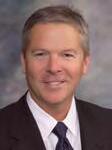







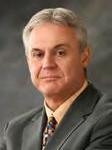




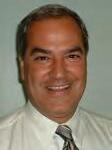





These top executives have taken their clubs to a higher level by implementing a better approach for managing club food and beverage departments. Building on a foundation of best practices, checks and balances, and integrated business flows, they incorporated leading-edge food and beverage automation and reduced labor by tying all their systems together.
The controls, disciplines and reports produced by this approach make it possible to run food and beverage departments at peak efficiency, substantially reducing clerical labor and food costs. Innovation. A better way to do business
Just what you would expect from leaders at this level.
Find out more. Call us at 800-553-2438. Or just ask them!

http://www.foodtrak.com


When clubs are introduced to new technologies, minds always seem to wander to a particular place – the last CMS (club management software) installation experience.
It could be IP phones, an app or even a new website, but people have their guard up. How long is this conversion process going to take? How much training will we need? How will the support be?
The majority have probably been through two conversions at most and each CMS company does things differently. But they all face the same challenge, simplifying the conversion process and making sure the training provided has a lasting impact.
Face to face interaction is the most effective way to provide training. But it comes at a cost. There are many expenses CMS companies are responsible for when providing onsite training and therefore each club is provided with X number of hours upfront and access to an online library of tips and tricks.
Some clubs want to own the process, whereas others want to be led down the path of least resistance, trying to set things up how they’ve always been, with a few tweaks here and there. Few purchase additional training so most go with the minimum and figure out how to just make it work. With such an undertaking, it’s no surprise the learning curve can continue for months into the future.
Whether or not the conversion is considered a smooth one, it has a lasting effect and creates somewhat of a burden for future technology vendors to overcome because many equate this experience with any future technology related services.
So question three: How is a cloud service installed, supported and how much training is involved?
Installation: The vast majority of work involved in the transition to a hosted platform is done behind the scenes, somewhere around 85 percent. The rest happens onsite, scheduled
appropriately to avoid interrupting operations. So the installation process from a user’s standpoint requires little interaction. The timeline can take several weeks and is dependent on collecting a few key pieces of documentation and access to your data.
Training: The learning curve for a hosted environment is small. Users learn they’re no longer tied to a single computer or device. Any documents created or altered within the hosted environment are secure, continuously backed up and readily accessible with connectivity. Logging off at the end of your day and closing out unnecessary internet tabs is important to practice. Not to mention a new desktop icon.
Support: The infrastructure of a hosted environment can be quite complex. Monitoring software allows your provider to oversee the platform at a granular level and react to any perceived threats or issues before they result in gaps in performance, outages and eventually calls to support.
If a club has an issue, and their onsite infrastructure has been set up properly, chances are a solution can be provided remotely without scheduling a visit and onsite hourly billing costs. When doing your due diligence on introducing new technologies to your club, it’s important to clearly understand the process, how support is provided as well as what’s being delivered.
Know what’s required from the club’s standpoint and how following the vendor’s recommendations can increase operational efficiencies and ultimately improve the member experience. The cloud is only as mysterious as you want it to be. BR
Boyd Carr is the director of sales at Fortessa Hosting, Inc., a cloud-based hosting company helping clubs reduce their exposure to IT. Boyd can be reached at bcarr@fortessahosting.com or (949) 284-8808.


One of the things we pride ourselves on here at Jonas Club Software is providing the industry with the most in-depth, unique, and ever evolving line of software solutions available.
From applications such as In-House Payroll Processing, to Hotel Management, Marina Management and even a full suite of Spa and Fitness applications, we’re proud to say that no other company can do what we do. However, without the absolute best people in the industry (and I truly believe that) and clients who are willing to help us achieve great things, we couldn’t do what we do. What follows is just one of many great examples of how our team and clients come together to achieve something great.
In the fall of 2012, while hosting a user group in Fort Lauderdale, a Jonas Club Software employee sat down at a table for lunch. Already seated were four employees from Lost Tree Club, all of which had come to the user group with one very specific intention - to see if Jonas Club Software was ready to take their Spa Management system to the next level.
Lynn Hearn is the director of spa and fitness at Lost Tree Club in North Palm Beach, and is the founding president of the Club Spa & Fitness Association (CSFA), a non-profit association dedicated to establishing best practices for fitness, spa & wellness operations in the private club setting. When Lost Tree signed up for that year's session, they were preparing to open a new Spa & Fitness facility, and were seeking additional software solutions that would support their expanded wellness operation.
“Back in 2008, Rick Bayliss was recruited to take the helm at Lost Tree Club, a nearly 50 year old club at the time, to create an infrastructure for capital and operational improvements and move the club successfully into the future,” explains Hearn. “We had made the decision to transition the whole club under one software system. It was important to us moving forward to have the reports and dashboards to develop a better understanding of the spa and fitness facilities as part of the whole business.”
As one of the first users of the new Spa Management system, Lost Tree was an early adopter, and in doing so soon realized the product still needed to grow to meet their advanced needs. Hearn says, “We knew the system needed to grow in order to support and meet the needs of a sophisticated fitness and spa operation, so we reached out to Jonas regarding improvement opportunities in the program.” It’s what happened next that surprised Hearn and the team from Lost Tree Club. “A lot of companies would go on the defense when questioned about a new product, but the people at Jonas said ‘OK, let’s get it working the way you need it to’, and that was the beginning of a great partnership.”
In the years that have passed, Hearn and the team at Lost Tree have developed a close working relationship with the development team at Jonas Club Software, even travelling to the company headquarters in Toronto to brainstorm ideas for the continued development of Spa and Fitness applications.
“We were so happy that Jonas offered us an open door policy,” says Hearn. “We weren’t sure at first what would come of this, but over time, it has become clear that Jonas is being responsive to the needs of the industry and we’ve seen the product evolve thanks to their willingness to work with us.”
A client partnership like this one, is just one example of how we at Jonas Club Software work every day to ensure we are meeting the needs of our clients. We also take every possible opportunity to meet and interact with our clients face to face at user groups, conferences and industry events. We hope to see you sometime soon, too. BR
Jonas Club Software is the leading provider of Software, Communication and Services solutions to clubs large and small throughout the club industry. Worldwide over 2,200 clubs in more than 17 countries, with memberships ranging from 20 to 20,000, utilize Jonas Club Software to build and enrich member relationships, increase revenues, and decrease costs. For more informations, please visit www.jonasclub.com
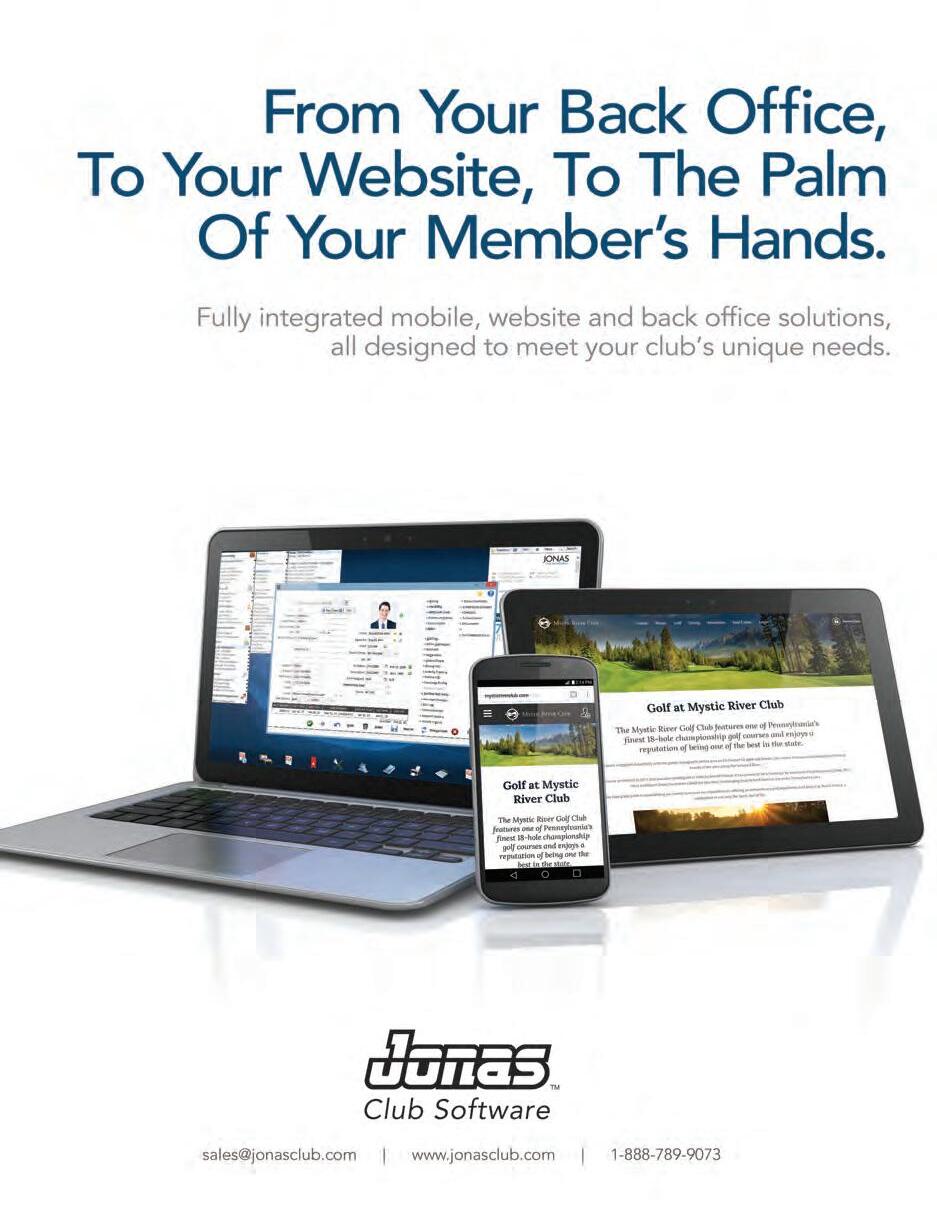

Every project we take on is designed to meet specific client goals and objectives. Whether it’s attracting new members, driving website traffic, increasing facility usage, or improving event participation.
With our depth of industry specific experience and competency, MembersFirst projects are measured by return on investment and increased member engagement. Our team takes the time to understand our client’s challenges and help find intelligent solutions.
A large contributor to our success over the years is the dedication to a process we truly believe in. This process involves everything from pre-sale consultation, to in-depth discovery calls, competitive analysis, and detailed launch plans. Clients who have experienced our process come to understand our unique passion for excellence and the end result is a level of innovation that wouldn’t have been possible without collaboration with our many forward-thinking clients.
“We selected MembersFirst because of their unique application, coupled with their depth of expertise in the private club industry...what most impressed us is they took the time to understand our business objectives and brand attributes, and then made recommendations they knew would perform and deliver for us.”
Dave Shinnebarger, Boca Lago Country Club
In my mind, the most interesting aspect of this consultation process is often when we identify a need our clients weren’t even aware we could address. In some cases, these discoveries even prompt us to create entirely new product offerings. One great example of this process in action is with a recent challenge we solved for Baltusrol Golf Club. As everyone knows, Baltusrol is rich in golf tradition and over the years the club has amassed a large collection of historical photography and memorabilia dating all the way back to their inception in 1895. Unfortunately, the collection was largely unavailable for members and guests to enjoy.
We started conceptualizing an online archive of every piece of history the club wanted site visitors to access. First, we helped identify interesting categories on which to filter (old course, clubhouse, major championships), then gave them the format to label the items with flags and keywords to make searching easy within the archive. The result was an intuitive and robust online collection of the club’s history complete with a journalist’s area to request original versions of the photographs to use in publications.
Another example of discovering something unexpected came from a conversation with Governors Club. At the time, the club was looking for a way to communicate everything taking place that day (rehearsal dinners, committee meetings, etc.) and have it on display for all in the main lobby. They also wanted to leverage this medium to better promote upcoming club events.Through conversations with our team, we collectively arrived at the idea to mount a TV on the wall to display a custom webpage. This webpage integrates content already available on their MembersFirst website in a kiosk/digital sign friendly layout. With this new solution, Governors Club is able to display real-time information and event locations to members and guests as soon as they walk through the front doors of the club, and they don’t have to maintain or enter information into two systems.
These are just two quick examples of how our process and mindset to understand our client’s needs helps us work collectively to identify innovative solutions. We like to think of ourselves as an extension of the club’s team, and with our thorough process and interest in our clients, we’re able to walk in their shoes. MembersFirst has always aimed to be more than just a vendorwe’re 100 percent focused on bringing new expertise and ideas to our clients. BR
MembersFirst is the industry leading, multi-award winning website agency for private clubs. Empowering clubs to create stronger relationships with their members and prospects, MembersFirst delivers unparalleled d esign, implementation, support and marketing services to uncompromising clubs. For more information, please visit www.membersfirst.com
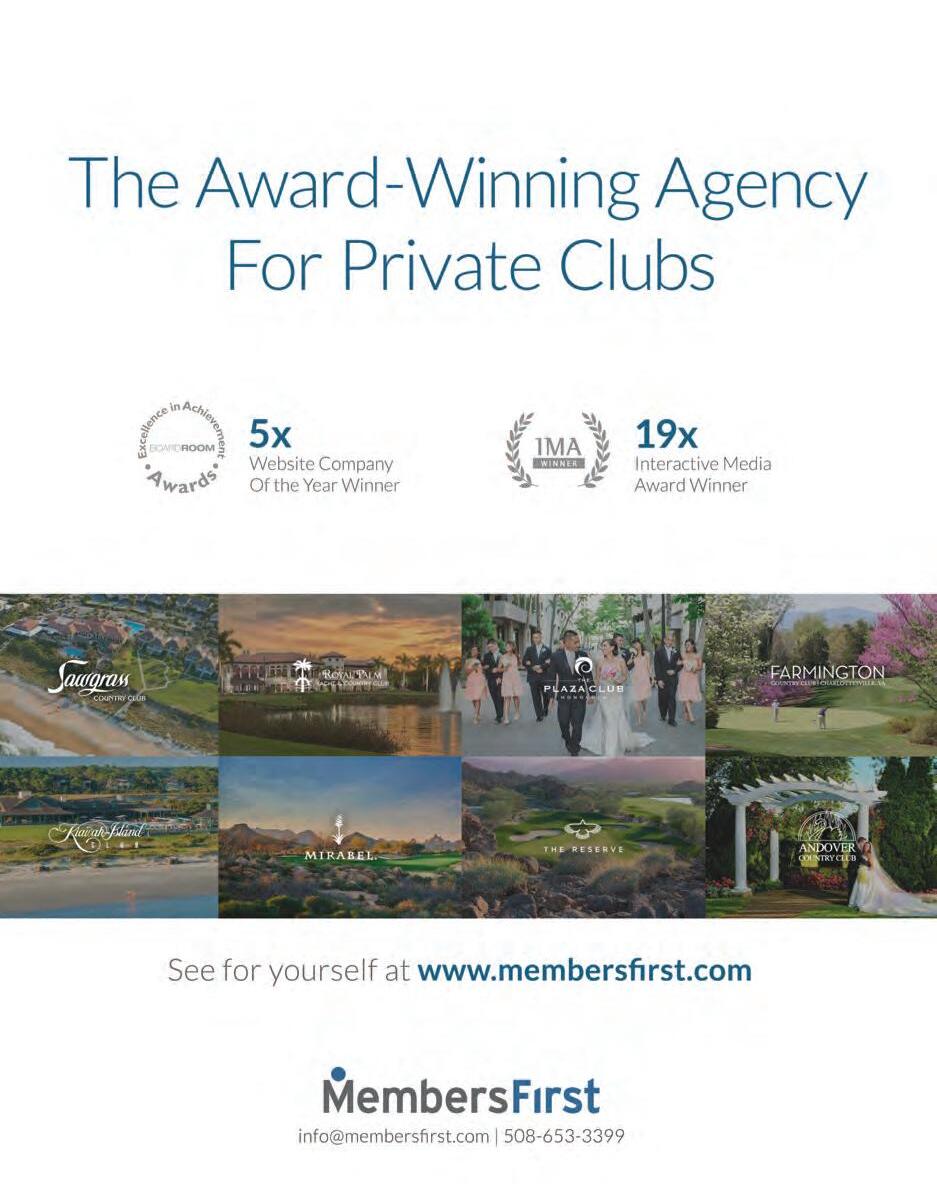

The Shangri-La Country Club is located at the tip of Monkey Island, in Northeast Oklahoma.
It currently features 27 holes of championship golf, a large 240-slip marina, three restaurants and a membership of over 300. But by April 2017, the club is set to transform into a full resort, with a 120-room lodge and conference center, three more dining venues, a luxury spa and a brand new resort pool.
Jon Davidson, Shangri-La Resort’s vice president of operations, decided a change in systems was necessary to meet their goals and objectives, not just as a resort, but to push the boundaries on the private club aspect of the property that has, and will continue to be, a main focus of the business. “Today, our system is inadequate to grow our customer database and profile to meet our goals and objectives.”
While Davidson and the executive team vetted several club and resort management systems while making their final decision, ResortSuite stood out amongst the crowd. “ResortSuite captured our attention because of its powerful integration and guest-centric design, along with very positive user feedback,” says Davidson.
Aside from participating in product demonstrations, the Shangri-La team also took the time to visit a property similar to what the resort will be, to gain a better sense of ResortSuite in action within a full resort environment. “The trip left us even more excited to implement ResortSuite,” Davidson offers. “Watching the cross-property integration in action, and the availability of guest and member information
from anywhere, really helped seal our decision.”
ResortSuite’s fully integrated suite of modules includes Club, SPA (Services Programs Activities), Golf, PMS (Property Management System), F&B, Sales & Catering, Retail, Ski and Concierge. While each module can stand alone as best of breed, the true niche of ResortSuite is in its management of horizontally complex properties such as a private club with golf, classes, lessons, accommodations, dining and more.
One extensible aspect of ResortSuite that the Shangri-La team is looking forward to making available to their members and guests, is the ability to book their entire experience online including reserving rooms and booking tee times at the three, 9-hole golf courses. “We also selected ResortSuite for its tech-focus on the guest/member experience. Members want to be able to book a tee time from their mobile device these days, and we’re excited that we will now have the ability to offer this service.”
Having mobility will not only benefit the members and guests and the new Shangri-La Resort come 2017, but with ResortSuite’s PMS CheckIn App and TabletSide POS App, staff will be able to check a guest into the lodge or marina, as well as take a food or beverage order anywhere on property (even the golf course!) with these staff-facing tablet applications. BR
Frank Pitsikalis is founder and CEO, ResortSuite and can be reached at (416) 259-0715 x 2010 or via email at frankp@resortsuite.com.
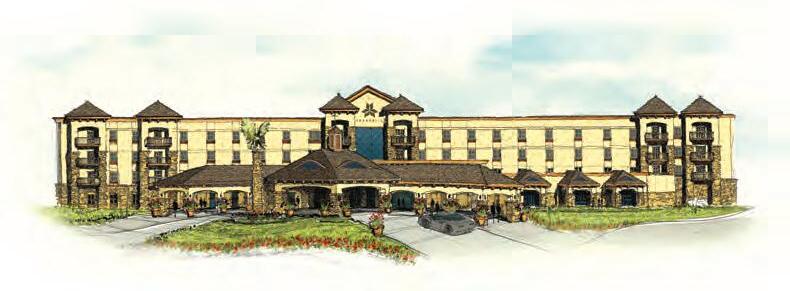



























With over four decades of expertise in the development and sales of club management computer software, Terry Hackett’s Club Software, Inc. is the right choice for clubs or as they like to say, The Single Source Solution.
Club Software, Inc. was the first company to make the investment in time and money to update their software system to cloud technology.
Serving member clubs since 1985, Club Software, Inc. has continuously made the investment of time and money to insure that its software is state-of-the-art. The latest innovation being cloud technology, beginning with POS and Timekeeping modules along with basic back office modules.
“At CSI, we are dedicated to provide easy-touse software that saves money for the club in hardware, training and IT costs. The latest version of our software can be run on the club’s inhouse server, hosted at our own data center, or at a hosting provider of the club’s selection,” says Terry Hackett, of Club Software, Inc. “If you decide to allow CSI to host your server, we will take care of upgrading it every five years for you.” Hackett adds. BR
Terry Hackett is founder and president of Club Software, Inc. based in Atlanta, Georgia.
Contact Terry at terry_hackett@clubsoftwareinc.net or visit www.clubsoftwareinc.net

Williams Island, a.k.a The Florida Riviera, offers an exclusive, private residential community at one of South Florida's most prestigious addresses.
Residents have an amenity-rich lifestyle that encompasses an all-new, twenty-seven thousand square foot European-style spa and fitness center, a marina worthy of those in its sister Riviera's, and exquisite fine dining.
Beginning with their first majestic residential tower, and continuing through its most recent additions, Williams Island has made it their mission to consistently set standards for beauty, grace, and, most of all, quality service as a way of life. To retain these standards, Williams Island’s director of human resources sought new and efficient ways to manage their large labor force, and found integrated technology to simplify their payroll and HR administration, plus meet Employer Mandate compliance with ease.
Williams Island chose ClubPay to outsource their payroll and tax processing based on the sole advantage of integration with their time and attendance system, which meant no
more double entry of new hires or status changes. Then, the Employer Mandate arrived, and HR realized ClubPay offered much more than an easy fix for streamlining their data entry.
“One of the many challenges human resources and payroll representatives faced this year was Affordable Care Act Compliance; without the guidance and hands on approach by ClubPay’s support team, we certainly would not have accomplished this daunting task, nor reached completion for timely reporting compliance,” says Debra Lavoie, PHR, SHRM –CP, director of human resources at Williams Island.
Employers subject to ACA’s shared responsibility were to accurately collect health insurance coverage data in 2015 to meet reporting requirements in the first quarter 2016. ClubPay launched new tools for benefit tracking, and standard reports to easily evaluate average hours worked, and track field items to meet IRS reporting requirements.
Lavoie went on to say. “Everyone we reached out to for assistance provided extraordinary customer service beyond our expectations.” BR
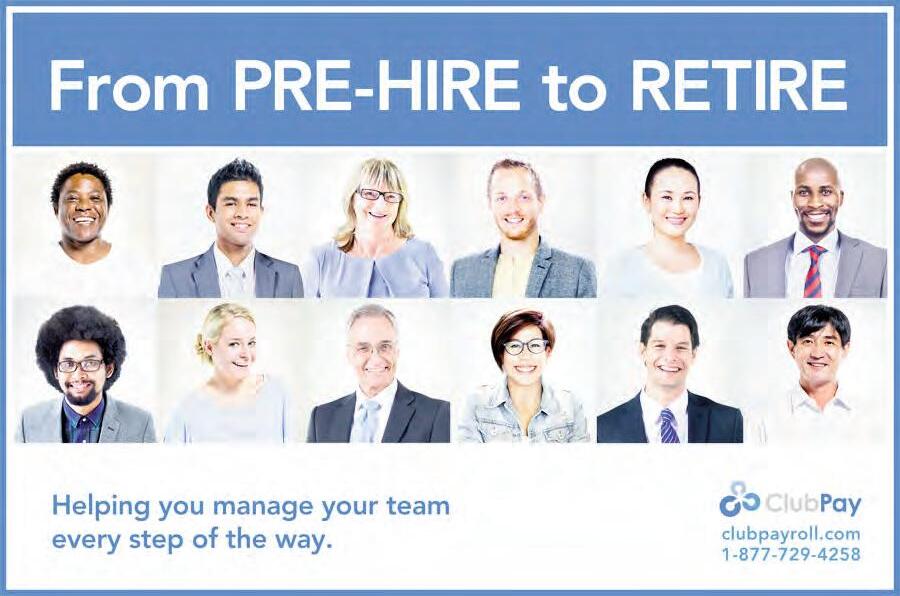

Although the term “social media” didn’t exist prior to the early 1990s, the brisk rate of its integration into daily life has expanded so rapidly that the statistics are staggering to comprehend.
Today, in just one minute, here’s what happens:
• 150,000 messages are sent via Facebook
• 104,000 photos are shared through Snapchat
• 400 hours of video are uploaded to YouTube
• 3.1 million people search on Google (not including Bing or Yahoo)
• 422,000 messages are tweeted
• 205.6 million emails are sent and,
• Instagram sees 55,000 posts.
Used to define the world of facilitated digital content, social media blends both business and personal to promote a cause, product, or experience. Millions of businesses have found it to be effective in attracting prospects and connecting with customers and participation from the private club world is an ever-growing part of the trend.

Clubs that find themselves late to the party can easily integrate digital marketing efforts into their marketing with a few simple steps.
At a minimum, phase one should include a compelling website that is engaging for visitors. It should allow for easy access to information with features such as contact forms, intuitive
navigation, a blog, and a password-protected section for sensitive member content.
The club should also be active on Facebook and Instagram, with use of Twitter if desired. Once at this level, participation can move toward sharing videos on YouTube, posting to LinkedIn, and even working with ratings sites such as TripAdvisor, Yelp and Golf Advisor.
Facebook continues to evolve as rapidly as its algorithms. Every time Facebook is opened, a closely guarded formula scans everything posted by each of the user’s friends, everyone followed, each group belonged to, and every page liked in order to rank the news into the precise order of how likely the user is to find each post worthwhile.
While the process might start with thousands of posts, the final result could get whittled down to less than 100.
With this in mind, following best practices will help to ensure success on Facebook. Facebook wants 80 percent of the content posted to a business page to be about the club, with the other 20 percent being relevant posts about and to your audience.
That 20 percent could be updates on the industry, tournament news, or a discussion on seasonal food trends. A club should continually promote the page while also increasing reach by boosting posts.
Facebook ads are especially effective on a budget as little as $1 per day and creating them is easy – once on your page simply click on Promote in the upper right hand corner, then Go to Ads Manager, and then Create Ad. (The website canva.com is especially useful in developing graphics for digital channels.)
Once your ad is running, Facebook will tell you how it’s doing. Remember to update the ad regularly, and don’t run a single promotion for more than 14 days.
Instagram has gone from a trendy little app to a massive social network of more than 500 million monthly active users, and it’s not showing any signs of slowing down.
Facebook owns Instagram, so ads on this net-
work run conveniently through the Facebook Ads Manager.
Advertising on Twitter is the least expensive option, but comes with a limit of 140 characters, so it’s easy to quickly use up precious space.
The options don’t end here. Super marketers also find a way onto Google+, Snapchat, Pinterest, Periscope, and Vine, to name a few. Help is easy to find for anyone looking for assistance with these channels.
As with all topics, the online world can be a great resource for best uses on hashtags, link shortening, and more.
Video is a tactic that should be in your digital toolbox, as it engages audiences at a significantly greater level than written content. Although there are instances that call for a professional shoot, high quality production and instant uploading to YouTube can be accomplished directly from a cell phone.
The standard email is not dead, but now the delivery of relevant content is more critical than ever. In fact, 64 percent of those in a recent survey said they opened an email just because it had an intriguing subject line.
Every club is unique in its adaptation of technology, but nearly all have embraced the world of social media, as online platforms continue to find their place in the private club world. And that’s a huge change in private club words from 10 years ago.
Regardless of where a club is on the adapter curve, every club should be studying up on social media in order to best capitalize on the way it delivers prospect leads, drives revenues, and connects members. BR
Ricky Potts (also known as #Ricky) is the digital communication manager at Troon and can be reached at (480) 477-0508 or at rpotts@troon.com.
Culinary Software Services is the leader in back-office technology for the foodservice industry.
CorTec and ChefTec software provide state-of-the-art inventory control, recipe and menu costing, purchasing and ordering, sales analysis, production management, event management, and nutritional analysis. Country clubs need back-office software that is sophisticated but easy to use. They require seamless integration with vendors’ ordering systems and POS systems such as Jonas. Clubs must be able to run multiple revenue centers, cost out functions, and manage requisitions and transfers. Thousands of clubs already use CorTec and ChefTec software for streamlining processes and keeping costs under control.
ChefTec Software offers specific features and functions that are essential to the complex operations of today’s dynamic country club enterprise.
• Multiple profit centers in ChefTec allow you to track inventory, costs, sales and more for various revenue centers.
• Costing out complicated banquets and events is fast and easy with ChefTec’s powerful recipe and menu costing features.
• Use ChefTec’s sophisticated Production Management features to keep production schedules tight and precise.
• Interface with POS systems (Jonas, Aloha, etc.).
• Interface with major vendors’ online ordering systems (Sysco, US Foodservice, etc.) for seamless integration of orders and invoices. BR
Call (800) 447-1466 today so we can help you find relief from rising food costs. Save time and cut waste with ChefTec software.

By MIcHael SParkS
St. Andrews Country Club in Boca Raton, Florida uses Signera digital signage to enhance club communications.
“We recently completed a $17.5 million renovation and needed proper signage to reflect our new, modern design,” says Joanna Pratt, marketing and membership coordinator.
“We wanted to get rid of the bulk posters, frames and easels that were costly to constantly replace.”
St. Andrews Country club had previously used another digital signage provider before switching to Signera.
“Our previous provider did not have a user-friendly back end. It was difficult to upload anything without an issue, it was low quality and wasn’t what we were looking for. We needed [our signage] accessible even if we weren’t in the office, especially in case of emergency. Signera can be easily accessed from any computer which is convenient and helps us to be prepared for any situation.”
Craig D. Martin, COO/GM adds, “We selected Signera because of their ease-of-use, content versatility and ability to broadcast via our community channel so all of our mem-
bers are able to view our schedule of events and activities from the comfort of their own homes.”
At Signera, we specialize in the club market by offering the services needed to make digital signage a good fit with integration of popular club software, custom design services, and ease of use.
Members today have become more engaged with the clubs and rely on digital signage to keep informed. Marketing personnel have been able to do more, with less effort, and get greater results by using digital signage. Our clients are using digital signage throughout the club; in clubhouses, pro shops, locker rooms, fitness centers, tennis and racquet facilities, restaurants, and snack bars. Lead your club into a new era of convenience and efficiency with digital signage. BR
Contact Signera at (877) 998-7446 or visit www.signera.net to learn more.

Ten years ago all of the vendors had the best interest of their clients at heart, TAI still does.
For many clubs, the days of entrance fees and assessing members for losses is history. Today’s clubs need the tools and the expertise to run a club to the satisfaction of the membership and still make a profit. In order to accomplish this, technology is integral but technology alone solves nothing.
A basic fundamental of technology is that technology doesn’t run a club, people do. Technology makes good better while causing bad things to get worse. Management sets the policy and staff carries it out, and your technology does as it is told.
Vendors who sell you on the concept that their system will make all your problems disappear, are doing you a disservice. Vendors who are too big, rigid, inflexible and provide poor support need to sell the illusion that the software alone makes the difference. Regretfully when the decision makers are not versed in club operations or technology (board members, club members or consultants) the salesperson has the upper hand and the club is stuck with the results.
TAI values integrity above all else. We will work to determine your needs and determine with you if TAI should be your technology partner. TAI does not limit your choices by restricting your options; TAI integrates to the real world allowing you the flexibility to choose what is best. Critical to your success, TAI’s support is the clear leader in the industry and our business knowledge will become an asset to your success.
All clubs are unique and the one size fits all approach is archaic and
restricts your ability to be successful. TAI values the results more than the sale, and we value your success. Integrity, honesty, expertise, product and service; TAI Club Management is your partner in club technology. BR
Michael Talbot is the president of TAI Club Management Systems and has over thirty-five years of experience as a system designer and solution provider. Mr. Talbot can be reached at (248) 723.9700 or via email at mtalbot@taiconsulting.com

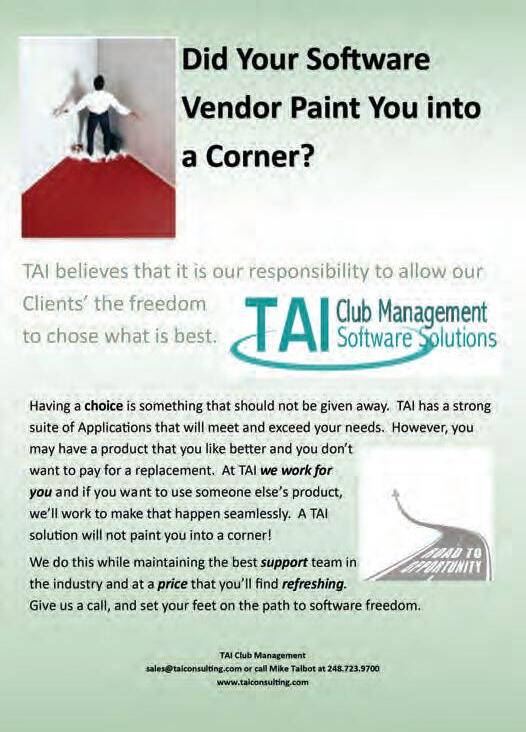

Cyber security issues are in the news all the time now. Businesses that are hacked put at risk their corporate information and assets, their clients’ and employees’ information and assets, and the club’s reputation.
The club’s board of directors, with the fiduciary duty to use the care of an ordinary prudent person in similar circumstances, must ensure it is taking proactive steps to minimize the club’s risk. The board can help protect itself by engaging appropriate advisors and vendors.
Cyber hacking is a serious business now. There is an entire infrastructure in place, where it is known in the industry how much of what type of data will sell at what price.
The club can be compromised in many ways: Hackers can take information to empty the business bank account, take members’ credit card or ACH information, or take information to steal member identity. Same goes for employees.
Hackers can use the club to try to hack its members directly. Some hackers install ransomware that locks the club out of its system and data until it pays a ransom.
“Key logging functionality in malware is another common attack vector, which copies information, such as credit card information and passwords, as it is typed on the keyboard,” said Fred Santarsiere, chief technology officer of CINO Security Solutions, a cyber security consulting firm. In that way, once the club is compromised the hacker can continue to steal information on an ongoing basis.
So, what should the club do? Be educated, be safe, be insured, and be diligent.
The club’s general manager has numerous opportunities to become and stay educated on cyber risks. Industry organizations and vendors provide content at their meetings and conferences and in their written materials. There has been increased regulatory oversight of security and privacy practices in many industries, and clubs can
expect to fall under a number of these as the sheer volume of laws and regulations grows.
As the leader of your business, the general manager must be as aware of developments in this area as they are of changes to applicable employment law. The board likewise must stay informed. The better informed the general manager and board are about potential threats, the better strategic and management decisions they can make.
“From our experience working within the industry, clubs that have taken a more proactive approach to cyber security awareness and education usually have a more secure IT environment,” Santarsiere says. The board’s and club’s potential exposure for failing to understand and protect against cyber risks is not unlike what one would expect if the club failed to understand and implement its other legal obligations, such as the new wage and hour regulations, or failed to protect itself with insurance for fire damage.
In the area of facilities and system vulnerability, the club should shore up its weaknesses. There are simple steps the club can take with little or no expense, such as disassociating the computers used for accounting functions from the club-wide network to protect it from hackers who enter the network in other areas.
The club can ensure that only the most necessary member information is stored on the network. For example, accounting can attach a member number to an ACH number, rather than attaching the member’s identifying information to their ACH information.
Clubs gather member information that should not be stored together digitally including name, address, birthday, social security number, children’s names and birthdates, anniversary, and bank references or information. Consider what information the club should retain and how to protect it. Of greater impact, however, is ensur-
In March, EZLinks Golf, a PGA TOUR affiliated company, acquired private golf club software leader Integrated Business Systems (IBS).
The acquisition joins together over four decades of golf course management expertise and provides private clubs with a powerful new software suite to manage its membership, food and beverage needs, golf operations, accounting integrations, reporting and more.
Both EZLinks and IBS have a long history of innovation. The industry’s first electronic tee sheet, online tee time booking engine, cloud-based handicap system, responsive tee time reservation site, extensive accounting capabilities and integration, are just a few examples of how the combined company has established a sterling reputation among the world’s premier clubs.
“One of the reasons we acquired IBS is because of how well they have served private clubs,” said Gary Cohen, CEO of EZLinks Golf LLC. “Now, with our combined engineering, development, and product teams, and additional invest-
ment in hiring the best talent in these areas, we are able to further improve those solutions and allow club personnel to focus more on serving their members.”
Powering operations at such notable clubs as Baltusrol, Conway Farms, Montclair Country Club, the Glen View Club, and the Yacht and Country Club, EZLinks software brings best-in-class technology and world-class service to the private club operator. The official tee sheet solution of the TPC network of courses, EZLinks Golf continues to bring new innovation to operators with the recent release of a new cloud-based version of its point of sale system.
“Better service is possible with better technology,” says Joe Seminerio, cpontroller at Baltusrol Golf Club. “The combination of EZLinks and Integrated Business Systems is better than better, it is the best solution for private clubs. Switching is easier than you think.” BR
See how EZLinks can simplify your operations.
Visit www.ezlinksgolf.com or www.goibs.com to find out more.


When we were youngsters, the notion of children as members was in the realm of comedian Rodney Dangerfield. They got no respect. Now, kids are –or should be – on every club’s radar screen.
Today’s family is an inclusive family with parents empowering and encouraging their kids to be involved in decisions across the board. If clubs have not yet realized the potential of this market trend, business sure has.
Companies spend more than $1.2 Trillion (That’s with a T!) annually marketing to children because they represent a dynamic retail market, influencing an estimated $500 billion in total retail spending. Marketing to children has evolved from the initial days of “secret decoder rings” and Cracker Jack toys.
Today, kids are considered to be customers in their own right. Ask Disney. Ask Noggin.com. Ask McDonald’s or True Jeans. They represent an important demographic to marketers because they have their own money, they influence what their parents do, what they join, where they eat, and what they buy. Plus, they are the adult consumers of the future.
Trends such as smaller family size, multi-generational families, dual incomes and postponing having children until later in life mean that parents (and grandparents alike) have more disposable income and are willing to spend more for and on their kids. Add to this the role guilt can play because parents are time-stressed and you have a potential gold mine for your club. Sound familiar?
YouGov research found that children are “active decision makers in family economies” across a lot of decisions, including club activities. This sure happened in our family. When our daughters were in their “tween” years, we belonged to a very nice club that had a challenging golf course, beautiful swimming pool, awesome tennis courts, and top notch dining. Our girls played golf, swam, and hit were pretty good on the tennis courts too.
But they didn’t do any of these at our club. Nope. They wanted to be at the city park’s facilities with their friends – whose parents happened to be club members too. So guess what? We all ended up getting a membership there for them too.
Research has found that young children can hold as much persuasive power as teens. From a young age, children’s preferences influence where the family goes and what the family does 87 percent of the time. And this is true across geographic markets too. Interestingly, in the U.S. about 71 percent of parents say they ask for their kids’ input, but this jumps to 94 percent internationally.
Parents view kids’ input as a way to ensure that their children get more out of the family’s leisure time experiences. And, let’s face it, it is also a way to reduce the nagging quotient too.
Before thinking about how your club can capitalize on this Kid$ trend, It’s helpful to understand two things about them and their influence. First, children begin their lifelong relationship with brands at a very young age.
As unlikely as it may seem, babies begin to recognize brands by six months of age. They can form mental images of brand logos and mascots. Hence the power of icons such as Mickey Mouse, Ronald McDonald, and even the Nike swoosh. When they are two or three years old, brand loyalty begins to kick in and toddlers will begin asking to do a specific thing or to go to a specific place. This is when the so-called “pester-power” begins rearing its ugly head.
Think about the last time you walked down the cereal aisle at your favorite grocery store with a child in tow. In kindergarten, they begin making their own purchase decisions, and are virtually in total control before they enter middle school.
What is both powerful and scary at the same time is the fact that, in many categories, more than 25 percent of brand preferences carry over from childhood to adulthood. Adult allegiance is rooted by childhood memories, associations, and nostalgia.
This is a lesson Coca-Cola learned the hard way with its venture into New Coke. How well has your club learned this lesson?
Second, it’s helpful to understand just how kids do influence family decisions. Nickelodeon found that there are basically five approaches to decision-making in families that involve kids’ input. Of course, a family can use a different approach at different points in time, as well as
depending on the type of decision being made and the ages of the children. But, in essence, the five are described as:
• Board of directors – Parents make the final decisions, but only after seeking their children’s input (56 percent)
• Family meeting – Parents and children discuss and come to a decision together (44 percent)
• Parent screen – Parents provide options and let the children decide (20 percent)
• Because I said so – As with earlier generations, parents decide on their own and the children have to just accept it (13 percent)
• Kids cut loose – Children decide on their own (9 percent)
So given these duel facts, let’s take a brief look at what this might mean for your club.
Kids of all ages have money to spend in pro shops, if –and it is a very big if — there are “cool” things to buy in there. Those in the marketing world know that it’s important to plant the seeds of brand recognition in children at an early age in the hopes that the seeds grow into purchase and loyalty.
They also know that, even if the child doesn’t directly buy the product and may not for many years, the marketing of the brand experience must begin in childhood. A case in point is Christmas/Chanukah ornaments.
Buying an annual tree ornament for each child has become a hot trend for kids, parents and grandparents. Think of the possibilities for having ornaments made that have the club’s logo, the year, and space to have the child’s name engraved, and given to each child at the annual holiday party. The same idea can be used for families. A different design, of course, because no kid wants what their parents have.
When it comes to eating at the club, it takes more than a children’s table, a kid’s menu with crayons, and allowing denim in the casual dining room to capitalize on the “pester power” of kids. The National Restaurant Association recognizes this and points out that taking advantage of the kids’ market is not only about tailoring menu items for their tastes, but more importantly, it is about customer service.
from Legal Committee | 58
ing the club’s software is updated and patched in a timely manner, that appropriate firewalls are in place, and that the systems are tested by an appropriate professional. And, clubs should be sure to budget for cyber related expenses, updating software and retaining consultants as needed.
Employee training is also crucial. Employees can make your system vulnerable by plugging an infected device into their computer to charge or by clicking on the wrong link.
“Employees who have not been properly trained can be the easiest attack vector into an environment,” Santarsiere asserts, “and there are simple steps the club can take to vastly increase its level of protection against potential threats.”
Kids – especially teens – are incredibly sensitive to how welcome they feel in restaurants. Creating an environment that’s welcoming to these age groups is critical in marketing to these young people.
Every parent and marketer knows that a child begging to buy something or to do something is the most powerful persuasive tactic there is. That’s why kids’ marketing is jokingly called “pester power.”
Thus, a key for your club marketing is the proverbial word-or-mouth (WOM) advertising, which in today’s parlance may mean Snapchat (72 percent use), Facebook (68 percent), Instagram (66 percent), ad infinitum. The challenge for your club, then, is to provide some things that kids, especially teens, find “cool” enough to channel friends via their social media sites.
Many kid brands are using “buzz or street marketing,” in which you find the coolest kids and have them sign up for your activity or wear your club’s product in order to create a buzz that can – and will – spread like wild fire.
This type viral marketing connects with savvy and elusive kids by using trendsetters to help position your club as the “cool” place to go.
Finally, take a lesson from such notable magazines as Time, Sports Illustrated and People. Each has launched kid and teen editions. What about your club launching a kid or teen edition of your newsletter or e-newsletter that boasts information about club programs, products and services just for them?
Remember, they have their own money, they have pester power, and they are your future members.
Your bottom line will thank you! BR
Bonnie J. Knutson Ph.D. is a people watcher. A professor in The School of Hospitality Business, Broad College of Business, Michigan State University, Dr. Knutson is a member of the Country Club of Lansing and the Michigan Athletic Club. She can be reached via e-mail: drbonnie@msu.edu
Club policies are important here: Who has access to what information, and what limits are placed on employees? Many unrelated policies may come into play, such as document retention policies and employee access and training policies.
Part II will look at why it’s important to consider cyber issues as part of your club’s annual employee training and review of its policies. BR
Robyn Nordin Stowell is a partner in the law firm of Sherman & Howard L.L.C. in Scottsdale, Arizona. Robyn may be reached at (480) 624-2736 or by email at rstowell@shermanhoward.com.
Fred Santarsiere may be reached at (516) 932-0317 or by email at fsanta@cinoltd.com

By ToBy IngleTon
It was one of those eye-opening moments.
In fall 2014, Lester George, ASGCA, based in Richmond, Virginia, was working at Vestavia Country Club in Birmingham, Alabama, when one of his subcontractors reached into his van and took out a drone.
“I’m like ‘he’s not going to launch that thing is he?’” recalls George. “But he did, and flew it up to about 400 feet to show us what it could do. And I realized how useful it would be to see the golf course from whatever perspective I wanted.”
Vestavia has a lot of rock on the property, and footage from a camera attached to the drone showed the grass as a lighter color where the rock was closer to the surface. “I could see it from the ground as well, but not in its totality,” explains George. “It showed me where I was going to have to either expose the rock, or cover it to give grass the right conditions to grow in.

“It was almost an immediate ‘a-ha’ moment for me, I went out and bought one right away.”
Throughout the history of golf, new innovations have affected both the way we play the game, and the way golf courses are designed, and in recent years, the unmanned aircraft system (UAS, or ‘drone’), has emerged as a technology with numerous commercial applications.
Indeed, the Japanese firm Rakuten has even applied the parcel delivery concept to golf, and is now testing a new service that allows items such as snacks and balls to be delivered from the clubhouse to golfers out on the course.
Jim Cervone, ASGCA, of Cervone Golf Design, Pittsburgh, Pennsylvania, quickly saw the potential benefits of using drones in golf design.
“It dawned on me that this would be a wonderful addition to the toolbox. When you get that drone out for the first time, you’re like a kid. You just want to fly it around and have some fun. But that’s actually an important aspect of it because you need to be familiar with it and be able to maneuver it properly,” says Cervone.
Another golf course architect and drone operator, Mike Benkusky, ASGCA, of Michael J. Benkusky, Inc. – golf course architecture in Lake In The Hills, Ill, honed his skills using a basic model, the type that has become popular as a kids’ toy in recent years.
“Before going out and buying an expensive one, go and buy one for under $100 to learn how to fly it. If you can fly a little one, you’ll find the bigger ones a lot easier.”
The surge in popularity of drones has seen all kinds of possibilities emerge, and increasing demand on airspace. In the United States, there are safety guidelines for drone use for hobby and recreational purposes, including flying below 400 feet, keeping the aircraft within visual line of sight at all times and not flying near people.
If the drone is being flown for commercial use, you must have authorization from the Federal Aviation Authority. This can be achieved through a Section 333 Exemption for operations in low-risk, controlled environments, or a Special Airworthiness Certificate.
Once authorization has been granted and the art of piloting a drone mastered, there are countless applications, limited only by the operators’ imagination. Like George, Benkusky has found that the immediate benefit relates to getting that aerial perspective of a course that would have previously only been available with expensive helicopter footage.
“If a club is considering removing trees, you can show everyone exactly the effect that shade has on the green,” says Benkusky. “With another project we used drone photography to show the full extent of bunkering around a green, and consider how we could remove sand without affecting the design integrity of the hole.”
Drones certainly give a bird’s eye view. “I can look at drainage,” says George, “I can look at shade patterns, conditions where the turf is suffering for one reason or another.” (To view drone videos of Vestavia CC taken by Chad Cosby of Chandler Landscapes, Inc., visit: www.youtube.com/watch?v=t11utX9hNvs.)
One of the most obvious early applications has been to improve visualizations of design proposals. Visualization using photos or artwork is a common technique employed by golf course architects to help get their design ideas across to clients.
“If you start explaining ideas with just a plan, clients don’t necessarily get the idea of, for example, how deep a bunker is in relation to a green,” says Benkusky. “I think video takes it a step further where you can show the entire golf hole pretty easily and even put it out on YouTube so the club can share it with their entire membership. It’s a selling point, showing people what is going to happen and getting them excited about the project.”
Benkusky had seen some impressive animation work for another project and wondered if he could emulate it with video for a project he was working on at St Charles Country Club in St Charles, Illinois.
“I decided to experiment with a couple of holes last fall,” he explains. “I was just playing around with it, but it ended up looking great.” Benkusky took drone video footage and then overlaid it with proposed alterations and annotation.
George agrees. “Clients love presentation video –whether it’s architectural or the club just wants flyovers to be on their website.
“But we’re just at the tip of the iceberg.” One of the main applications is getting information faster because drones have the capability of gathering information in hours rather than weeks.”
Specifically, by using a drone in combination with photogrammetry software, architects can get accurate and detailed topographical information for a site in a fraction of the time it would take to do a traditional land survey. Vestavia recently conducted an entire survey of the property. “They went out with a drone and programmed it to fly back and forth,” says George. “It went up for 45 minutes, came down and they replaced the battery and flew it again. It’s as good a topo as I’ve ever had and it took them two hours instead of two weeks.”
“To be able to go out with the drone and within minutes set up a small flight plan and get the sort of base material I need is invaluable,” says Cervone. “It’s an expensive proposition to get someone out to do topo for you – and not to mention you are then on their time. I can go out on my own and turn something around in the same day.”
A number of software applications are available for download to a smartphone or tablet, which connect with the drone and enable the user to set up an automated flight plan and capture the images required to produce a topographic map.

Combining a drone and camera with photogrammetry software enables architects to quickly and easily produce detailed topographic maps with contour lines, which can then provide the basis for design decisions and grading plans.
VIDEO VISUALIZATION
With some stop-frame work and annotation, video footage of entire holes can be manipulated to show proposed changes.
see videos of st Charles Country Club www.youtube.com/watch?v=1c0wuWZjXtu and www.youtube.com/watch?v=mp2eenQWfpI
“Once you get the hang of setting up a flight plan, which is simple to do, you hit a button, that drone will take off, fly what you set up on that app, come back and land at your feet,” says Cervone. “The aerial images are taken by the camera and stitched together into an overall larger aerial, and through photogrammetry the software that I’m using creates the topographic information.”
At Vernango Valley Golf Course in Venango, Pennsylvania, close to where Cervone grew up, the club didn’t have a topographic map. Cervone has used the drone numerous times to quickly and easily get the information he needs.
In future, Cervone plans to spend more time investigating 3D modeling capabilities. “With this new technology now we can actually take a 3D model that everyone understands and show that to them so they can get a better picture in their minds of what the eventual design will look like. That’s what I’m after.”
If the enthusiasm with which ‘early adopter’ golf architects have for drones is anything to go by, it seems that the technology is here to stay.
No question, the possible uses are boundless. BR

As a clubhouse designer, I always enjoy sharing our substantive new approaches to clubhouse enhancements that improve the overall member experience, create a new or enhanced revenue opportunity and streamline operational efficiencies.
Over the past several years, many of the club inquiries that we have received have revolved around creating new casual dining venues with a social bar and lounge component.
Rather than discussing the ubiquitous décor, color and furniture trends for casual dining and social bar venues, I will cut to the chase and give you our tried and true touch points to jump start your planning process.
5 KEY OFFERINGS THAT MAKE CASUAL DINING VENUES AND SOCIAL BARS POPULAR
1. Drop by the club and have a drink
2. Eat at the bar
3. Drop by to watch a sporting event
4. Pre/Post-dinner drinks and socialization
5. Enhanced décor and all day menu offerings

4 ESSENTIAL TOUCH POINTS THAT WILL KEEP MEMBERS COMING BACK TO THE CLUB
1. Create spaces that appeal to the broad dynamic of your membership demographic
2. Create spaces that are focused on comfort, enticing members to “linger longer”
3. Create spaces that have a fun energy
4. Create spaces that offer varied dining and social experiences in one venue
3 ESSENTIAL STEPS TO ENSURE YOUR NEW CASUAL DINING VENUE AND SOCIAL BAR BECOMES THE WELCOMED GATHERING PLACE YOU ENVISIONED
1. Only consider design solutions that will make the club special or unique by clarifying and confirming the club’s personality and story.
2. Only create spatial changes that will maximize use and return on investment.
3. Only introduce design and furnishing solutions that match the clubhouse’s unique features, current/future needs and membership demographic.
The single most important takeaway that I can give you, no matter what club improvement you may be considering, is to identify your core identity as a club and how you want to be distinguishable from other clubs. Doing so will ensure each and every clubhouse enhancement will keep you ahead of the competition and relevant to the needs and expectations of today’s ever changing membership demographic. BR
C2 Limited Design Associates is an award winning interior design and clubhouse styling firm with studios in Historic Fairfield, Connecticut and Williamsburg, Virginia. In 2015, C 2 Limited Design Associates was named BoardRoom Magazine’s Interior Design Firm of the Year for the third consecutive year. About the author: Craig J. Sm ith, ASID can be contacted via email csmith@c2limited.com or via telephone at (203) 259-2555 ext. 312.


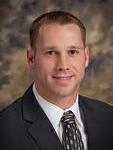
People ask me all the time, what keeps you up at night? And I say Spicy Mexican food, weapons of mass destruction, and cyber attacks.
-Dutch Ruppersberger
Ask any security expert and they will tell you that it’s not a matter of “if”, but “when” your organization will suffer a cyberattack. And while you might think a country club isn’t a huge target for hackers, the reality is that no organization is safe anymore, particularly smaller entities.
Verizon Data Breach Incident Report (DBIR) recently reported that more than 75 percent of all security breaches occur at organizations with 100 or fewer employees. This is in large part because of a couple of key factors:
• The nature and sophistication of hacks are evolving. Gone are the days when hackers target one organization, do reconnaissance and specifically target and hack that organization. With the emergence of viruses like ransomware and crypto ware, attackers can blast literally hundreds of targets at once versus focusing on one organization at a time.
• The shift to PII - Over the last year or so hackers have shifted their focus away from stealing credit card data and toward obtaining personal identifiable information (PII)*. This is because credit cards are flooded on the black market right now and can be easily changed. Plus, financial institutions are pretty good about catching compromised cards so they aren’t good for very long. PII however, is like your DNA; it’s very difficult to change. And once a hacker has it, they can either sell it on the black market or use it to open other credit cards or on-line accounts.
*PII is cla ssified as any information that is personal in nature, social security number, date of birth, previous employers and addresses, or driver’s license numbers.
• Easy targets – smaller organizations typically have less money to spend on network defense and security awareness training, making them easy targets for hackers.
When you step back and think about it, a country club is actually a pretty good target. Clubs typically track a decent amount of PII on both their members and employees, and given most clubs don’t have a robust IT security program it makes them prime targets for hackers.
Now that we are beginning to accept that cyber risk is a real threat, let’s talk about what your club can do to protect its members and employees.
Here are five effective ways to start securing your network.
1. Vulnerability scans – vulnerability scans are a relatively cheap and effective way to scan your networks internet facing devices to see what vulnerabilities hackers may be able to exploit. This can be a valuable tool in both assessing your cyber risk as well as prioritizing what patches need to be implemented.
2. Centralize and control your patch management – centralizing patch management is an efficient way to manage your devices and applications connected to the network. This helps make sure all devices follow the same security structure and minimizes the risk of an attack but creating a security baseline for all devices.
3. Restrict access –The most common link in almost all breaches is human error - An employee accidentally clinks on a malicious link or downloads a file that contains a virus. This can be prohibited by restricting user administrative settings so employees can’t download files to their computer.
4. Security awareness training – the human element is most common cause of security breaches. Having a security awareness training program is an important, and often overlooked, part of securing your network. Teaching employees about phishing scams and social engineering is critical in today’s technology driv-

en world. Consider training employees quarterly (at a minimum annually) on security awareness protocols.
5. Cyber risk assessments –understanding what information is likely to be stolen and how it flows through your network is a critical part of understanding how to cost effectively secure it. A cyber risk
assessment involves a multi-step process of identifying key data, documenting where it is stored and flows on your network, and assessing controls in place to determine what additional controls may need to be implemented to better secure your network. A cyber risk assessment is another valuable tool in prioritizing and budgeting cyber initiatives.
Remember this, the worst possible decision you can make for your club is to do nothing. More than 60 percent of small organizations go out of business within six months of a data breach. While it is unlikely that a club would go out of business so quickly, the credibility it can lose with your members and employees can be even more damaging. That’s because breaches can be costly – both financially and operationally. BR
Kevin F. Reilly, an attorney and CPA, has been involved in the hospitality area and clubs in particular, for more than 25 years. He is a member of the firm of PBMares, LLP. Kevin Reilly is located in the Fairfax, VA office. He may be reached at (703) 3858809 or by email at kreilly@pbmares.com. Harvey Johnson is a CPA and is a member of the Risk Management Association and been involved in cyber security for more than 10 years. He is a partner in the Norfolk office of PBMares,LLP and is located in the Norfolk, VA office. He may be reached at (757)627-4644 or by email at hjohnson@pbmares.com.

SPecIal TO BOarDrOOM
John Komes is the Founder and Proprietor of Flora Springs Vineyards & Winery in Napa Valley.
Owned and operated by John and his family since 1978, Flora Springs is known for a portfolio of estate-grown wines that includes its flagship Cabernet Sauvignon, Trilogy, its proprietary Sauvignon Blanc, Soliloquy, as well as critically-acclaimed Chardonnays and Merlots. Since 1994 John has also been the driving force behind Flora Springs’ Single Vineyard Cabernet Sauvignons, wines from the family’s estate vineyards that showcase the finest appellations of Napa Valley.
John has worked with BoardRoom magazine’s Distinguished Clubs of the World and been featured in BoardRoom magazine many times over his career, and believes that fine wine plays an important role in enhancing the member experience at private clubs. We asked him to define this role and explain how the wine and private club industries can work together.
What role does wine play in the private club member experience?
It can be crucial. People have a lot of choices when it comes to dining out. There’s been an explosion in fine restaurants nationwide, and well-thought out wine lists are a big part of that. To be competitive, private clubs need to offer commensurate experiences, or better yet, experiences that go beyond what restaurants can offer.
Such as?
Offering private winemaker dinners is an excellent way to engage and reward club members. Flora Springs has done dozens of these over the years, and the response from club members is always enthusiastic. We did one earlier this year at Palos Verde Country Club, and we have one coming up at the Shady Canyon Country Club in Orange County in November. It’s the second one we’ve done with Raphael Tuch, the sommelier/wine director there.
What makes a winemaker dinner special?
It’s the personal touch, I think, and a little bit of showmanship. Richard Tiedemann, our director of Winery Relations, does a lot of these now that I don’t travel as much, and he makes the dinners fun and interactive. He’ll
bring soils from our vineyards, or ripe grape clusters if the timing is right. He’s from a Napa wine growing family, so he knows how to make wine come alive.
We also work with the sommeliers and GMs to bring in Flora Springs wines that their club members can’t find elsewhere, such as our limited production Single Vineyard Cabernets that are usually only available to our own wine club members. At Shady Canyon, for instance, we’ll pour our Rennie Reserve and Wild Boar Cabernets, which are virtually sold out elsewhere.
What’s next for you?
I’m still involved in the day-to-day operations at Flora Springs, but my son, Nat, and I are also working on a boutique wine project called Jon Nathaniel Wines. It’s a “return to our roots” venture that allows Nat and I to get creative and make wines from our own vineyards at the very highest level. It’s a lot of fun. BR
To schedule a winemaker dinner with Flora Springs, contact Richard Tiedemann at RTiedemann@florasprings.com.
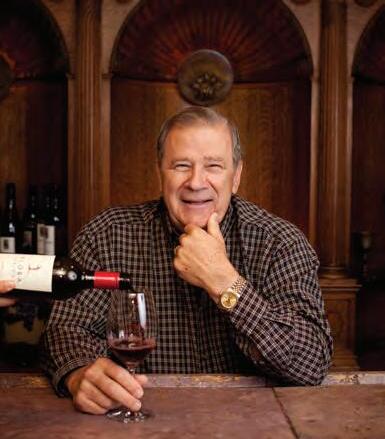


Several years ago, Country Club of Charleston enlisted the services of clubhouse interior designer Harris Interiors when Ron Gillette, the general manager, called with a challenge: member dining in the clubhouse.
Like so many clubs, the existing dining rooms were uninspired and unapproachable by families. With a renovation of three dining rooms and the addition of an outdoor dining terrace, Harris Interiors was able to answer Gillette’s immediate dilemma and respond to the current trends of casual, family-friendly clubhouse dining.
With the success of the clubhouse dining renovation, the club had the momentum to explore a master plan that would serve as a roadmap for the board and long range planning committee. For the master plan, Harris Interiors recommended a partnership with Chapman Coyle Chapman Architects. The two firms, specializing in clubhouse design, have a long history of collaboration, and have completed over 25 club projects together.
The design team hosted member and staff interviews and an on-site, three-day design charrette. A town hall meeting to present the master plan helped the members understand potential phasing, project scope, schedule and financing.
It was with the master plan that the design team identified the club’s immediate and future needs. This winter, construction will begin on a new wellness center. The complex will feature a

new resort-style pool, enlarged pool deck and pool locker rooms. A new state-of-the-art facility will house fitness classrooms, treatment rooms, adult and youth locker rooms, child minding, teen room, an outdoor bar and terrace, and a new golf shop. Most importantly, the team has studied the Charleston architectural vernacular in an effort to deliver a project the members can identify with and claim as their own.
What began as a relationship and successful clubhouse renovation with Harris Interiors evolved into a master plan and, ultimately, a project that will greatly enhance the member experience at Country Club of Charleston. BR
Harris Interiors is a full-service clubhouse interior design firm based in Atlanta, Georgia. Please visit our website for additional information, or contact Kelley Harris, Principal Interior Designer, kelley@hintatlanta.com.



Every business continuously faces decisions regarding investing in new assets and facilities.
As such, investment decisions are examined to assure a given investment will generate an appropriate return. An appropriate return increases a business’s value while poor or nonexistent investments decrease the value of a business and can even cause it to fail.
Payback, return on investment (ROI), and internal rate of return (IRR) are the most typical measures used to weigh the return against the investment for individual projects. Ultimately, all of the decisions made on individual projects tally up to a return for the overall business. That overall measure is termed return on equity (ROE).

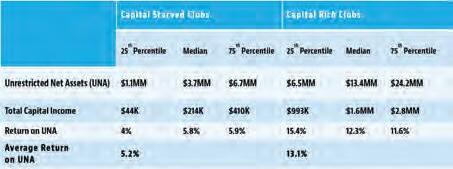
ROE is the annual return (profit) a business makes on the sum total invested in the business that year. In a not-for-profit, memberowned club, we have to address both equity and profit differently.
The equivalent of equity in a not-for-profit is termed unrestricted net assets, but what measure is in place of profit to calculate return? While certain clubs do generate meaningful operating surpluses (approximately 30 percent) most are break-even or have an operating deficit (70 percent).
Extensive analysis and consideration have led to the realization the return or “profit” in a member-owned club is the amount of money available at year end to make capital investments, reduce debt and/or increase reserves –we’ll call that net available capital (NAC).
NAC includes all capital income (initiation fee income, capital dues and assessments) adjusted for the operating result. An operating surplus increases NAC while an operating deficit decreases NAC.
The NAC chart shows the distribution of NAC to operating revenue ratio for all clubs in the Club Benchmarking database. Healthy ongoing maintenance and investment in a club’s facilities and assets requires NAC to be at least 12 to 15 percent of operating revenue every year.
As the chart to the left shows, the lower quartile of clubs falls well below that threshold (<5 percent). Those clubs are capital starved. The upper quartile clubs are well above the threshold (>17 percent). Those clubs are capital rich.
The table at the bottom dissects the quartiles of capital starved and capital rich clubs.
A few critical observations emerge. First, the unrestricted net assets line in the chart shows capital rich clubs have significantly more invested in their clubs than do capital starved clubs. Secondly, even with significantly more invested, the relative amount of capital income flowing to capital rich clubs produces a 2.5 times greater return (13 percent) than capital starved clubs (5 percent).
In the end, clubs reap the rewards of investment through increased capital income, which should be the focus of every board. Increased
capital income comes through higher initiation fees, more members joining and happier members more willing to reinvest in the club through capital dues or assessments.
Members and prospective members seeing results from the right investments are more willing to invest to make things even better.
Boards are often focused on operating ledger issues like making money in food and beverage or scrutinizing the payroll. Strategic boards will shy from that and concern themselves with investments and return on investment.
Given that the money invested in the club is the member’s money, the board has a responsibility to ensure an adequate return.
To our knowledge, this is the first research on this topic in the club industry. In Part II, we’ll address the implications for investment decisions, explain how to do the calculations for your own club and use data to prove that member experience and higher returns are actually intertwined. BR
Ray Cronin, co-founder & CEO of Club Benchmarking and president of Thorny Lea Golf Club in Brockton, MA.
extensive analysis and consideration have led to the realization the return or “profit” in a member-owned club is the amount of money available at year end to make capital investments, reduce debt and/or increase reserves – we’ll call that net available capital (nAC). nAC includes all capital income (initiation fee income, capital dues and assessments) adjusted for the operatingresult. An operating surplus i ncreases nAC while an operating deficit decreasesnAC.


Rogers McCagg is a full service architectural, master planning and interior design firm specializing in private clubs.
Formerly known as James G Rogers Architects, the name change recognizes long time Principal Chris McCagg becoming an owning partner, in addition to more fully describing the services offered by our firm.
Collaboration is at the heart of our creative culture and underpins the longstanding relationships we have had with more than 60 golf and country clubs in the Northeast and beyond. We see ourselves as partners with our clients, working together to hone the vision of a successful project and define a path to completion. Successful outcomes result from the collaborative blending of our broad professional knowledge with each client’s depth of understanding of its own unique set of challenges and goals.
The volunteer governance structure of clubs is especially well suited to this collaborative project approach. Governors and committee members operate in an environment of mutual respect and shared commitment to the well-being of their club.
This commitment is essential to our combined efforts in defining member needs, assessing choices available to meet them and selecting a final path for presentation and approval by fellow members. Our commitment to collaboration and development of a partnership with clients defines master planning and individual building projects as well as interior design assignments.
Rogers McCagg principals together share a combined 60 years experience working with clubs to help them shape a vision of their future and make it a reality. Each project is led by a principal supported by experienced, dedicated staff

who share additional broad experience completing club projects ranging from master plans to clubhouse renovations and additions, and specialized facilities for golf, swimming, squash and fitness. We value our rich history of working with clubs and look forward to an exciting future. BR
James G. Rogers III, FAIA and Christopher M. McCagg, AIA are partners at Rogers McCagg Architects |Planners |Interior Designers and can be reached at (203) 354 5210. To learn more please visit our website www.rm-arch.com



In my experience, there are board members and then there are board members.
Some serve their clubs out of obligation but never truly engage in a way they might recognize from their own professional lives. Others do throw themselves into the process – and these are the ones you might see outside the conference room banging their heads against a wall.
Why the head-banging? Balancing the profit motive with non-profit 501(C)(3) standing is more difficult today than ever before, thanks to overbuilt markets, increased competition for members, and lingering effects of our recent recession, which truly did change the way many Americans (particularly young ones) view the private club experience.
If you and your club are struggling with this balancing act, ask yourself two key questions: What are the revenue centers at your club? Where does that revenue land?
If revenues generated by the tennis professional, for example, are not shared across all the departments in your club, you are fighting an uphill battle to achieve sound financial standing. Why? Because it’s likely that other department heads are similarly “siloed” in terms of revenue sharing and overall incentivization.
Here’s another common example: If I’m a director of golf, and all the revenues/profits generated by my golf operation are not shared with food and beverage, or the course maintenance operation, or the events department, that director of golf has no incentive to benefit the club’s overall financial standing.
In fact, he might just argue that, next year, he needs another $500,000 in outside services in order to cater best to members who play golf.
Most private equity clubs still operate according to this silo method. Each department is an island unto itself. Some create revenue, some don’t. Some create profit, some don’t. Sometimes the fiscal year comes to an end and the club finishes in the black. Sometimes not.
The huge variables inherent to operations on this model make it very difficult to plan for a club’s future. It’s a big reason so many private equity clubs are today carrying so much debt.
But I’ve come bearing good news: You can fix this.
The first step is to establish a club-wide budget and business plan that organizes (then incentivizes) department heads in a more productive, collective manner.
Your director of golf may not like it, but revenues/profits from the golf shop must be redirected to the club’s general fund, not his 401k. An F&B manager can report to the club board or they can report to the general manager. It doesn’t matter.
What’s imperative is this: F&B profits (and costs) stemming from the performance of their department must be shared with/by the entire club.
Once these silos are removed (and only then), boards can implement a productive, collective incentive structure for all various department heads.
What does that mean exactly?
Here’s what it means: Incentivize your entire management team based on reasonable, achievable advances in the overall financial health of your club. If these objectives are met, department heads can and should be rewarded according to their contributions to the met objective. If the objective is not met, department heads receive no reward.
We typically use a big-sum baseline EBITDA (earnings before interest, taxes/depreciation/ amortization) as a starting point. If the club is at zero EBITDA, meaning it’s breaking even, we would incentivize department heads to get the club’s overall EBITDA to $100,000.
Then we establish a bonus pool of, say, $25,000, to be equitably split among the GM and department heads – if that EBITDA of $100,000 is achieved. Here you can see that, if
department heads recognize the personal benefit of overall club performance, they have incentive to perform – for their own benefit and the club’s.
Bonuses can be paid out according to a variety of formulas. For the sake of discussion, let’s suppose that each department head gets five grand if the annual EBITDA threshold is met, while the GM gets 10 grand — because it’s their leadership over the course of a fiscal year that drives this revenue-production bus.
However, there is another, more important level of objectivity that must be applied to bonus dispersion. If an EBIDTA of $100,000 has been achieved, but the F&B department did not contribute to that success, perhaps the person heading that department will get something less than $5,000 in bonus.
Perhaps, if the performance is so poor, they will get nothing at all. These understandings must, of course, be established ahead of time.
The course maintenance aspect is a separate piece of this puzzle, because even under the best of circumstances, the superintendent’s department does not necessarily create revenue.
We have been party to situations where a superintendent is bonused for simply level-funding his budget – and fur-
ther bonused by finding key budget reductions (the elimination of spray applications or other economies).
In some way, shape or form, boards must find a way to fairly judge and reward the superintendent’s contribution to a positive EBITDA.
I know what you’re thinking: My director of golf is going to walk if he’s no longer able to keep the profits from his golf shop operation. Well, my advice to you would be, “Let him walk.” Then find yourself another director of golf, one who recognizes the value in having all department heads rowing in the same direction, to benefit the club as a whole.
I’m not saying a transition to this model is easy. It’s part of the reason clubs turn to third-party managers – to do this heavy lifting. But it can be done. Only when department heads are removed from their silos (sometimes kicking and screaming) can they can be incentivized in this more constructive, collective fashion. BR
Tom Everett leads the third-party management business at Lincoln, Neb.-based Landscapes Unlimited (www.landscapes unlimited.com). A PGA Professional, Everett has more 25 years’ experience managing municipal, daily fee, semi-private and private club facilities.


Quite a few private clubs today are continuing to play catch-up from the dark days of the great recession when so many capital projects were wisely put in abeyance.
However, even with the extensive work that may be required at some facilities, most clubs are still reluctant to tackle comprehensive clubhouse renovations and additions in a single, grand step. So how are clubs addressing their overdue projects? An excellent example is Ansley Golf Club, where the membership decided to undertake a comprehensive clubhouse makeover one step at a time.
Ansley is a thriving club located in the booming Midtown area of Atlanta, GA. It’s nestled in a beautiful neighborhood of early 1900s era homes, just minutes from one of Atlanta’s major dining, cultural and business hubs. In addition to fitness facilities and 9 holes of in-town golf, the club has very active swimming and tennis programs. Due to its urban location, it also enjoys substantial lunch traffic and business functions throughout the day.
While originally a quiet neighborhood country club, the city

has grown up around it. Now Ansley finds itself in the enviable position of catering to active young families who enjoy having their club in close proximity to their homes and businesses. When the club decided to embark on a renovation and expansion program, these younger members voiced a desire for interior spaces that reflected their upbeat, in-town status with a lighter design style that is more contemporary or transitional than the traditional country club look.
To develop the plans and interior design scheme, the club enlisted the help of Chapman Coyle Chapman Architects and noted interior designer Susan Bozeman.
Following an overall facility master plan developed by the club’s design team, the board of directors embarked on a carefully orchestrated series of changes and upgrades over a sevenyear period with five distinct phases to reach their ultimate goal. Beginning in 2010 while the great recession was in full swing, the first phases were relatively modest in cost. The final, largest phase, including a substantial clubhouse addition, is scheduled for completion in 2017. This final phase will address the club’s need for improved socializing areas, casual dining and fitness upgrades. When finished, the work will have encompassed all member areas of the clubhouse as well as a new pool pavilion and expanded outdoor dining.
In the dining areas renovated so far, sales are up 78 percent, while sales at the new pool pavilion are up 40 percent... and it will all have been completed one step at a time. BR
Bozeman Club & Corporate Interiors is an Atlanta-based interior design firm specializing in private clubs and corporate design. Susan Bozeman may be reached via email at susanb@sbbdesigns.com or you may contact Jeff Barrett, senior VP of club and corporate design at jeffb@sbbdesigns.com. To learn more, please visit www.bozemancc.design or call (404) 237-7745.


By Heather Arias de Cordoba, Associate Editor, BoardRoom magazine
BoardRoom magazine annually recognizes the world’s top private club presidents, captains and chairs as Private Club Presidents of the Year, for their outstanding work, their understanding of the industry, and role and responsibilities of the club’s board of directors. In this continuing series, BoardRoom introduces three of the top 22 presidents for 2015.
Private club board presidents play a huge role in professional operations of their clubs as a volunteer working diligently with their board of directors and general managers, striving for well informed, but not emotional decisions.
This recognition by BoardRoom magazine has attracted board president nominations from clubs and other nominators around the world.
These outstanding presidents exemplify the focus on the leadership responsibilities, the accountability and the management of the board providing a healthy respect for the club’s macro management. They are cognizant of the importance of working, effectively and efficiently, with their volunteer boards and the dedication required from everyone with whom they work.
Key elements of a “good” board include commitment, competence, diversity, collective decision making, openness, transparency, effective communication with the management and the membership, fiscal responsibility, development and establishment of the clubs’ mission, vision and policy direction, especially through establishment of a strategic plan.
A successful board president draws upon the expertise of other board members, the club’s institutional memor y and stewardship of the club’s resources. As well the board president provides new board members and future board presidents with information they need to perform effectively as board members.
Congratulations to these outstanding private club board presidents.
Three club president profiles on page 82 and 83
Sponsored by

Who is your choice as the top private club board president?
many people and companies associated with the private club industry are given due recognition for their accomplishments, and now Boardroom magazine is focusing on selection and recognition of the Private CluB Board President of the Year.
Boardroom magazine, through a nomination and selection process, will honor 20 board president finalists worldwide and one prestigious distinguished President of the Year award.
The top 20 private club board president finalists will be selected by a Boardroomcommittee comprised of industry experts and sponsors, who can make an expert judgment, who have an understanding of the industry, the structure of the board of directors, and the role and responsibilities of a club’s board of directors. A third party accounting firm will audit results.
A special section published in Boardroom magazinewill be devoted to the announcement of the toP Private CluB Presidentsand the distinguished President of the Year.

ENTRY AND DEADLINE visit www.boardroommagazine.com to download the criteria and application form. entries must be submitted no later than Friday, november 17, 2016. For further information contact John Fornaro (949) 376-8889 ext. 2 or johnf@apcd.com
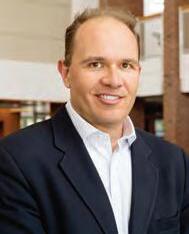

new members… and happy members have marked Greg miarecki’s tenure as Commodore of the Chicago yacht Club.
And his vision and leadership, his bold and innovative approach to leading the club, while working closely with management have contributed to the club’s financial performance and member satisfaction.
“His energy is contagious, and he clearly leads by example, ” said Dwight Jenson, Chicago yacht Club’s general manager.
“For example, management strongly recommended renovating the club’s primary bar area, arguing that the renovation would drive increased member satisfaction.
“Greg, working closely with management, led the project though the complex approval and construction process. As well, Greg championed management’s efforts to restructure the club’s food and beverage operation, which (along with the bar renovation) has generated a strong increase in revenue and in member satisfaction.”
under miarecki’s tenure, a large number of new members with outstanding credentials have joined the club, and with an improved member experience, management has received many compliments from happy members.
“Because of Greg’s innovative efforts, we have better food and beverage service, better communications, better and more diverse on-the-water activities, better facilities and better events and activities. The members are responding by coming down to the club more often. On the management side, we’re calling this the new normal,” says Jenson.
Rosemary Winters, a club member feels improved communications “make all the events come alive,” stating that members no longer have to search for what is going on, because the club always let’s them know.
While miarecki’s leadership style is highly inclusive, he is willing to make difficult decisions. He trusts the other members of his executive board (the Flag) decisions without micromanaging their efforts. He is an advocate for open communication and dialogue with the Flag and the club’s board of directors, but most importantly, he involves management in these discussions, often referring to the general manager as the sixth flag officer.
As a highly accomplished sailor, miarecki is quick to use sailing analogies: “On the boat, you win or lose as a team. We’ve been winning because we have a terrific team from bow to stern –including our board, management, employees, volunteers and members. They make the Chicago yacht Club what it is.”
All good reasons why Greg miarecki is one of Boardroom’s outstanding presidents for 2015.
A member of the club since 1988, miarecki is a lifelong sailor with an accomplished record as a racing sailor. notably, he and his father are the first skippers in six decades to have won overall honors in the club’s signature Race to mackinac. He is an attorney, and currently an assistant dean at the university of Illinois College of law. His wife, Chris Albanis chairs the Women’s Committee at the club, and under her leadership, they’ve taken a big step forward with over 40 events designed especially for women


The Detroit Athletic Club, a BoardRoom magazine Distinguished Emerald Club of the World, celebrated the 100th anniversary of its clubhouse opening in 2015, and that marked an historic and eventful year for president Anthony magdowski, one of BoardRoom’s top presidents for 2015.
And as the club fulfilled all of its goals for vision 2015, the club has embarked on vision 2020 to carry the club into the future.
The club expanded and improved facilities within the clubhouse, adding a new rooftop, and dramatically altered entryway as well as an improved pavilion. The new madison Café and pro shop also contributed greatly to the club’s experience for its centennial.
The rooftop required another six months of painstaking work to be completed in time for the club’s first-ever two-day Back to
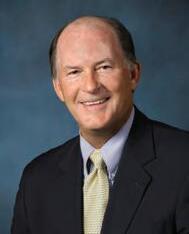
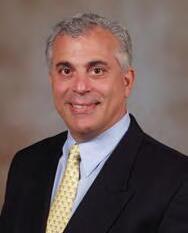
president peter miller had a plan and knew how to get there, and it’s made a world of difference for The Club at Ibis, a BoardRoom magazine Distinguished Emerald Club of the World
“Our ultimate goal every day is to enhance The Ibis Experience™ for our existing and future members, and our new Clubhouse and sports village will provide an exceptional, multifaceted resort experience for families and friends.”
When miller became board president in 2012, he was integrally involved in the club’s $37 million capital improvement project. He provided direction on this three-year, multi-phase project involving the long-range planning committee, finance committee, club management, the members, multiple contractors, interior designers, banks, and architects.
peter miller had a vision, created the roadmap, and the member vote passed with a 79.6 percent approval. ultimately, the project was completed on time and on budget.
He was also a member of the first member-owned board, established in 2011, shortly after the club takeover from the developer. As chair of the membership and marketing committee, he established a clear identity for the Ibis brand. It greatly
influenced the branding and programming of the Ibis Bodymind Connection, which leverages the club’s new facilities in concert with attracting younger members by enhancing and promoting a healthy lifestyle.
“peter miller has a unique ability to listen, digest, and create a plan that pulls everyone together to accomplish a common goal,” said the club’s general manager stephen J. loGiudice.
“He listens and respects peoples’ opinions. He has incredible vision, and is able to ‘map out’ the path and timeline of any project by continually asking, ‘where are we going?’ and ‘how are we going to get there?’”
president miller has certainly provided a high level of confidence and support from the board to the management team and allows management to bring input and ideas to the table always and provide oversight into the many important facets of Club operation. It is clearly a team effort.
some time ago, mr. miller created the club’s Key strategic Questions Initiative, a roadmap for future boards to use as a guide. This initiative covers membership and marketing strategies, the club’s value proposition, future equity pricing, and 10year strategic investment plan for products and services, as well as future capital improvements.
In recognition of his efforts, the club has created the peter A. miller leadership Award. It will be presented annually to the manager who most represents the attributes peter miller has exemplified during his years on the club’s board.
miller, who enjoyed a 26-year career with Jp morgan Chase, and his wife Ruth, joined Ibis in 2002. They have four grown children and six grandchildren.
“The future of The Club at Ibis has been improved immensely because of president miller’s efforts. The members, and the staff alike, are indebted to him for his contributions,” expressed loGiudice BR
the Club night weekend in september. The new seventh floor rooftop terrace wraps around the building, and the stadium Club restaurant and the last Word lounge offer stunning views, fun food and new avenues that definitely “cap” our DAC’s historic clubhouse in a distinctive way.
This unique project was also honored last year by the urban land Institute for the quality of the redevelopment.
The club’s Centennial Celebration also marked a highlight of the year under president magdowski as more than 2,000 members and guests celebrated the 100th anniversary of the clubhouse and the completion of DAC Foundation’s massive four-sculpture project.
“And that was a wonderful shout heard around the clubhouse in August when we reached our 3,000 membership cap in our
resident category,” president magdowski explained. And today, the club’s membership wait list remains strong.
During a multi-day retreat for board members, department heads and other DAC staff, the club began refining the next strategic vision 2020 plan with development of seven strategic goals. One of the major components is the idea of ensuring the DAC maintains and expands its role as “the third place”, where members develop a connect to the club that puts it on par of importance with their homes and offices.
And it’s these accomplishments for the Detroit Athletic Club, under the guidance of executive manager Ted Gillary, that single out Anthony magdowski as one of BoardRoom’s top presidents for 2015 . BR

By HeATHeR ARIAs De CORDOBA
How many times has your club’s board of directors gone searching for talent and come up empty?
Well, the Bel-Air Bay Club, a BoardRoom magazine Distinguished Emerald Club of the World, might just have some answers.
What if there was a way to match your members with open committee seats? Or better yet, identify and refer skilled members to committee chairs with the objective of helping your club members grow into high-caliber leaders who will be able to help with the club’s governance long-term? The Bel-Air Bay Club is doing just that with its leadership development committee (LDC).
Bill Howard, Bel-Air’s general manager says in the past the club didn’t feel like it was cultivating the talent of the general membership.
“Our board had become insular and we were retreading with some of our board members. The idea was to get quality people onto club governance committees, giving them the committee experience and developing a process to encourage and grow quality leaders who then take on major leadership roles within the governance model,” expresses Howard.
Before putting the LDC idea into action, Howard discussed the viability of such an idea with Sharon Browning, a past club president, strategic planning consultant and executive leadership coach with non-profits.
“What a great BHAG (Big Hairy Audacious Goal)!” exclaims Browning. “There were (and are) a lot of members out there with talent and leadership skills who want to get involved but don’t know how and we don’t know how to find them either. A strong bench of leaders is essential for long-term success. The LDC is a real win-win opportunity and we have technology to help us.”
It took about one year to implement the LDC from that initial conversation with Browning. The club developed purpose and mission statements, a path to follow and criteria for nominated members were established.
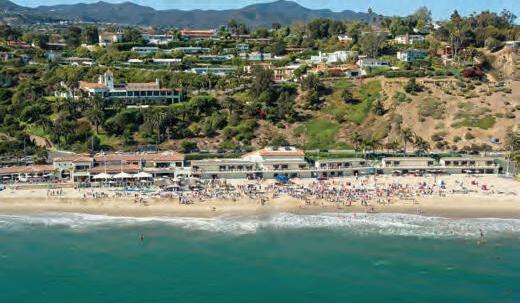
“A member must belong to the club for a minimum of three years, visit the club at least 50 times per year or spend $3,000 annually on food and beverage; and express an interest in serving on a club committee. If the member doesn’t match the criteria, they don’t qualify,” Howard explains.
“The end result is that we get a list of people who have the potential to be just right for a committee,” explains Samantha La Due, Bel-Air Bay Club’s director of communications. “The LDC reviews the list and narrows it down to a handful of good candidates, whom they’ll refer to the committee chair. The committee chair takes it from there and decides whether or not to ask any of these recommended persons to join that particular committee.”
Along with the baseline criteria and an initial list of names, the LDC representatives will ask the committee chair whether any additional requirements such as demographics or skillset are needed and these will be added into the database as well. The LDC doesn’t tell the committee chair who should participate. The LDC’s role is to make suggestions of people whom they believe can function on a particular committee.
Mark Tabit, the club’s president is a product of this process. The LDC initially engaged him four years ago to be part of the building and grounds committee and because of his leadership skills he moved on to a board position and finally to the president’s position. “He’s an extremely successful president,” Howard adds, “and he’s having a lot of fun!”

‘Your home away from home’– that’s how many members view their private club.
Now the New York Athletic Club, a BoardRoom magazine Distinguished Emerald Club of the World, has taken this meaning to a whole new level.
How about arriving at your favorite hotel to find your room decked out with all your favorite creature comforts? Items such as your favorite magazine or newspaper, your preferred brand of bottled water, your choice of cable TV channels, even your favorite type of pillow, all available in your room when you arrive?
“Excellence is something which is expected throughout the club,” states NYAC General Manager Roger Simon, “it is our goal to continually set a higher standard and improve member engagement”
By using surveys to help create unforgettable member experiences for club members and their guests, the New York Athletic Club does just that.
“Th e B4 Check-In survey is a tool we use prior to guest arrival,” explains Daniel Perez, the New York Athletic Club’s assistant general manager. “This survey assists us in making sure we provide the requested amenities and concierge services.
“The need to exceed our members’ expectations is predicated on personalization. In an option driven New York City market with more than 117,593 guest rooms and another 16,800 in the pipeline, it’s imperative that the New York Athletic Club makes sure its members and guests recognize the value of the facilities and the services that the staff provides,” Perez continues.
The survey program was relatively easy to fire up. Club staff members compiled a database of the most requested amenities and services from reservations and membership profiles, and converted them into reports. These reports were formatted for email and used by guest services when taking room reservations.
“Upon check-out, an email is generated and sent directly to my office,” Perez explains. “This is a follow-up survey to measure the club’s ability to accommodate requests and experience, and it also allows for guests to offer constructive suggestions. I read each one and send the comments to the respective departments; I, or a member of my team, address all emails in a very timely fashion. It’s the most personal interaction a member or guest can expect, aside from a face-to-face meeting.”


By HeATHeR ARIAs De CORDOBA
The feedback is vitally important. The membership response is evident in all the surveys we receive. “The feeling of going to your home away from home is very well received,” says Anthony Orlando, a New York Athletic Club board member.
Perez continues: “We truly believe that by allowing members to be active in creating their own experience we are absolutely effecting a positive member experience. The NYAC has a logo, the winged foot, and a motto, coined by one of our most celebrated Olympic athletes, the late Al Oerter. He said, ‘Great things are expected of you when you wear the winged foot.’ We want the legacy of the New York Athletic Club to be one of tradition, excellence and service. Our intention is to set a very high standard, and then to exceed that. The challenge is always to exceed expectations.”
Judging by the responses the club receives, the challenge is being exceeded. BR
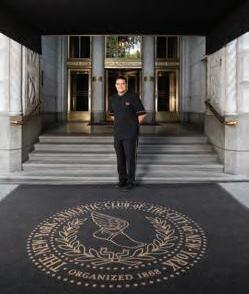

CMAA is working hard to address IT challenges. Most recently, CMAA launched its event app for the World Conference on Club Management and Club Business Expo.
Tell us about the app: The app that CMAA delivered at its most recent World Conference on Club Management and Club Business Expo enriched the experience of attendees and streamlined some of the important activities that are central to CMAA events. Importantly, one solution replaced several, thereby improving the attendee experience, including recording attendance, access to session materials, learning about speakers, networking between attendees, and providing feedback to CMAA.
Particularly important at larger events like the World Conference, in app communications provide greater networking opportunities. This allows people to connect from within the app at which time they have the opportunity to schedule meetups or other interactions. Similarly, CMAA has the option to communicate to attendees during the event about important reminders and updates.
Conference attendees have the ability to rate every speaker, session, and even the complete conference. Attendees can even communicate directly to CMAA staff members as well. This is important because it provides an avenue not only by which we can improve the next event, but opens the lines of communication and helps facilitate immediate response.
What had been used in the past? CMAA had actually made its foray into the app world several years earlier, but our recent solution marked an important achievement because we were able to address a host of requirements within one offering. Our biggest advance though was in the way in which we are tracking session attendance and awarding certification credits. In the past, this was a manual process, largely paper based.
How does the app work? CMAA’s event app is a native app built with a “mobile first” approach. We’re leveraging a platform that has been very successful in the association space. Our current provider was chosen based on cost and how well it addressed our needs. Available in various app stores, users are able to download the app to have access to all of its functionality. It’s really very user friendly, judging by the positive feedback we’ve received.
Additionally, if you don’t have a mobile device, all of the most critical app content is available through a web interface.
What other technology changes are on the horizon for CMAA? Much of what we do is meant ultimately to help the staff more efficiently and effectively serve the association’s constituents.
We are in the midst of a significant change to our association management software – something that the entire staff uses almost daily. Because of the nature of systems today and the deep integration that can exist between them, this change will have a notable impact on how the association does business. Once implemented, the new software will touch everything from backend financial systems to our forward facing presence on the web.
As senior director of IT, what is your favorite app? As a staff, we’ve committed to working together across departmental lines to make sure we’re addressing all the needs of the staff and membership.
Over the last year I’ve been looking at different platforms that help productivity from a team perspective. To be really useful, in my mind, they must have an app component. So though they aren’t “just apps,” I’ve been impressed with what I’ve seen in Slack and am optimistic about Asana.
I also like Airtable, which is like a portable database contained within an app.
When not at work, I can’t live without the Kindle app –I’ve read far more books on my phone over the last few years than I would have otherwise.
Apps give you a tool to carry around that you might not previously have had access to, unless you were sitting at a desk. With the advent of HTML5, responsive design and the ubiquity and speed of mobile access, the line between app, web and cloud services is becoming fairly blurry.
Ultimately that should only help as the device becomes somewhat less important and content is more universally accessible. BR














This has been an interesting year…so many clubs with projects at many different levels of completion.
And it’s amazing that the same issues resurface from club to club and project to project. It may be important to reflect on a few of these problems as this refection may be valuable to those of you in the same situation.
Remember what Winston Churchill said, “To improve is to change, to be perfect is to change often.”
What format should strategic and master planning take? A lot of people are using the concept of circular planning where the process goes through several steps until it is back reinforcing the original step. Maybe instead of circular we should take a spherical perspective. Let’s assume that you have a perfect ball with a hole in it shooting out light. As you move the ball in all directions the light points out in every direction. It will hit on positive ideas and ones that do not work well. However, you will be able to cover everything in all directions of your thought process.
Now flatten the circle into a pancake. The light will shine either up or down. Or as Doctor Phil says, “No matter how flat the pancake there is always two sides.” In essence you will either have a plan or not.
What is the senior mentality on strategic or capital planning? Now, I must confess, having been a member of my club for 36 years, I qualify a senior club member. That being said there are often too many senior club members who have a philosophy like “leave it alone, don’t change anything, everything is all right and, oh by the way, don’t charge me any more money.” Ever hear that before?
So the only way to insure that their philosophy wins is not to have a plan at all. If you have a plan, something is likely to change. Without a plan, the thinking is that no change will occur. The problem is most prevalent when you
attempt to provide a master plan for capital replacement. Recently a member at a client club sent a letter to the membership about their concerns over completing a facility master plan. What was their concern? If you have a plan something might actually happen and if it happens the members will have to pay for the improvements.
Every club should plan for the future, including facility improvements and capital investment strategies. It’s paramount that master planning is appropriately phased so that the project is logical, provides increased value and satisfaction to the membership, and is affordable within the marketplace.
We all have to remember that every club will have the ‘do nothing’ members to deal with. You need to prepare for that group and be able to address those issues.
Is the club paying the right price for consulting services? Remember, although you don’t want to overpay for master planning, the real cost is in the architectural fees. In a recent project we prequalified four architectural firms to interview. Prequalified means that any of the firms we interviewed had the background and reputation to complete the work. The master planning fees ran from $20,000 to $50,000. The future architectural fees ran from six percent to 9.5 percent. On $3 million of work those fees ranged from $180,000 to $285,000. That is a $105,000 difference. I think that difference is worth doing your homework
The reason we go through this exercise is that you never want to change horses in mid-stream. Once an architect is chosen you want to know your financial exposure to future fees. Whoever designs the project should complete it. If you hand off designs from one firm to another they will just change, as the new firm will want to make changes, sometimes major changes. You pay for design twice.
Why do so many clubs pay for the architect and interior design firm for the same work? This scenario happened on a recent project. This is an important and little addressed issue. A majority of clubs pay twice for a portion of the design work. Come on, that can’t be true! How this could happen. The contract between the architect and the club is on a form called AIA B 101. This is a standard contract written by the American Institute of Architects. Article 6 is called the Cost of Work. This is the total cost to construct all aspects of the project designed by the architect or specified by the owner.
When your project has a full service interior design company on the team it’s not uncommon for the interior designer to specify and design all the millwork. They also specify the carpet, tile, decorative lighting, building hardware and much more. These items are all attached to the building and are not included in FF&A (furniture, fixtures and accessories) that the interior designer will also provide.
The club will have two contracts with the interior design firm. The first is to design the project (including those items fixed to the building and all the FF&A). The second contract is to procure all the furniture and install it at the appropriate time. The problem arises because most architects consider all items attached to the building subject to their fees. Let’s look at the following example:
The budget for attached material was $450,000. The interior design firm may have charged you an 8-10 percent design
fee ($36,000 to $45,000). We also noticed that the architectural fee included that $450,000 of carpet, tile, millwork and hardware. $450,000 X 7 percent architectural fee or $31,500.
A top club architect not associated with the project said this issue is a really gray area in the industry. We argued that the cost of work is based on things designed by the architect. Yet, these items were designed by the interior designer. The architect made the argument that they had to supervise the installation of these items through the contractor and subcontractors. We agreed to compromise at a 3.5 percent fee (50 percent of the original) thereby saving the club $15,750. This saving would never have happened if you don’t address the issues.
There are several resources to help you become more educated in the areas of master planning, construction and renovation. CMAA has a resource called the Facilities and Amenities Series Vol. I. & II. There are many articles on roles of the parties and contract documents that can be of assistance. You can also visit clubwiseconsulting.com/ Publications/Articles.
If you are going to war, you might as well be fully armed. BR
Jerry N. McCoy, MCM, is the president of Clubwise, LLC, a consulting firm specializing in strategic planning, master planning, operational audits and governance issues. Clubwise was the 2013 Consulting Company of the Year by BoardRoom Magazine. He can be reached at www.clubwiseconsulting.com or CMAAMCM@msn.com
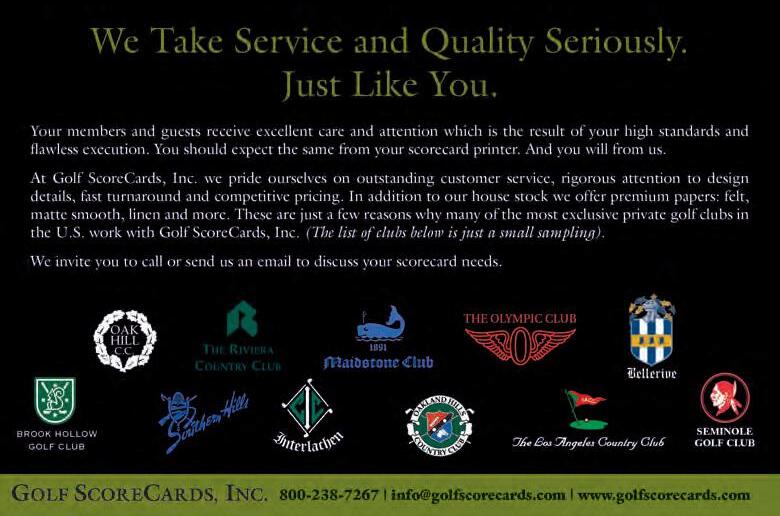


In recent years, the golf industry has been working together in an unprecedented manner to focus on initiatives and subjects critical to the current and future health of the game.
Several examples of this collaboration occurred at the U.S. Open earlier this year. Mike Davis, executive director and CEO of the USGA hosted a gathering of golf industry leaders for discussions on diversity and on developing a broad set of metrics to report on the health of the game.
The diversity discussions centered on efforts underway for more than a year by the LPGA, PGA of America, PGA TOUR, USGA and the WGF to stimulate greater ethnic, gender and age diversity within those organizations at staff, executive leadership and board governance levels.
The objective is to develop a broad cross-section of organizations from throughout the golf industry who are committed to making intentional efforts to enable greater diversity throughout their own organizations.

The discussion about creating a broad set of metrics to define the health of the golf industry focused on specific metrics to be included in this new definition of golf’s health.
The golf industry wants to move away from a very narrow definition of golf’s health focused exclusively on participation in the traditional game, to a broader definition that includes the traditional game, alternative forms of golf and fan interest in the game.
Leaders of the top organizations and initiatives in junior golf also met during the U.S. Open to discuss whether or not a formal junior golf pathway, to create a standardized process by which juniors could progress in golf based upon their mastery of the game, is a goal worth pursuing.
A working group will explore the concept of a junior golf pathway and to make a recommendation to the larger group as to whether or not a junior golf pathway is appropriate for the United States golf industry.
Several other significant matters including women and golf, Millennials, alternative golf experiences and caddies have been addressed previously in much the same manner.
The cooperation of the golf industry in not limited to these areas. The industry is also collectively promoting key initiatives and programs, including Drive, Chip and Putt, Get Golf Ready, LPGA*USGA Girls Golf, PGA Junior League Golf and The First Tee.
The golf industry realizes that it must both focus its resources in areas of the greatest potential return, and of importance to its long term health and vitality. Look for this level of cooperation to become even more focused and pronounced in the future. BR
Steve Mona is the chief executive officer of the World Golf Foundation. He may be reached at (904) 9404000 or via email: smona@worldgolffoundation.org.
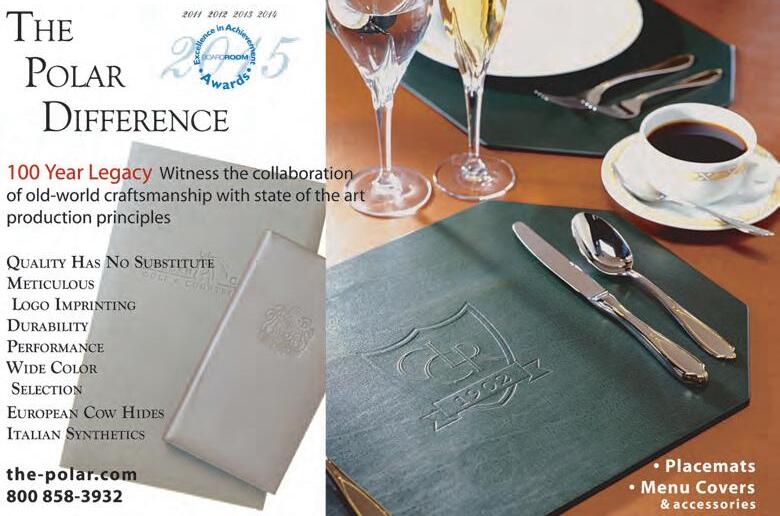
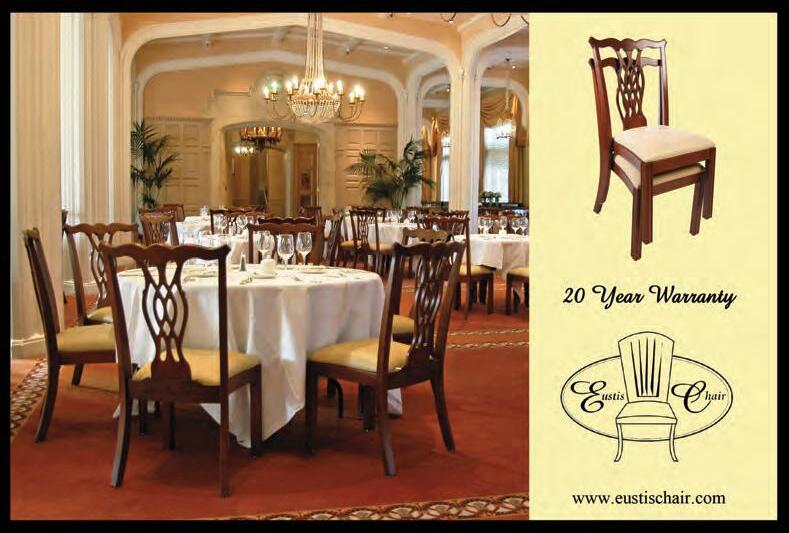
BY HEATHER ARIAS DE CORDOBA
Always leading the way with innovative and creative ideas, Ocean Reef Club, a BoardRoom magazine Distinguished Emerald Club of the World in Key Largo, FL, can now add food truck to its inventory list.
“The concept of the food truck came about as the club experienced a season of unprecedented increase in the number of meals served during the 2014-15 holiday season,” explains Michael Leemhuis, president of Ocean Reef Club. “It seemed the number of member families had grown and so had the size of the family. We now have third and even fourth generations of families spending their holidays here at the club.”
So, an alternative “pop up” restaurant was needed to accommodate the members and their families for lunch and in the evenings when the available outlets didn’t suit their needs.
“Buccaneer Island, the hub of outdoor recreation at Ocean Reef has a beach grill with one small kitchen, and needed to be able to accommodate more lunchtime diners,” explains Leemhuis. “The food truck is a great new addition! It has a changing menu, depending upon occasion and location, and serves up everything from lobster rolls to hot dogs to fish tacos and burgers. Our members are even able to rent it for private parties and events.”
In addition to its year-round stationary location every Friday, Saturday and Sunday, the Ocean Reef Club food truck goes to the club’s street fair events and to the beach on holiday weekends. During peak periods, the food truck also travels to var-
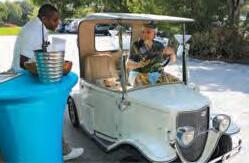
ious locations around the club offering quick and easy dinner options to the club’s members.
“We developed a system through the Ocean Reef Club app where members can track the food truck and find out where it is and what it’s serving,” says Leemhuis. “Last year during the club’s peak holidays of December 26 to January 2, the food truck served more than 1,100 meals.” BR

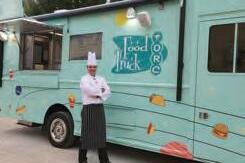

BY HEATHER ARIAS DE CORDOBA
Sometimes it’s the communication that does the trick!
When Woodfield Country Club embarked upon its $26.5 million LRP (Long Range Plan) renovation, Eben Molloy, the club’s general manager crafted a detailed renovation communication plan and schedule to send out information and keep members engaged.
Woodfield has 1,270 memberships, which translates to about 3,000 people living within its 20 communities, so Molloy employed a multi-faceted approach to successfully communicate to this diverse population.
The first step? Creating a LRP Update logo
“Branding the LRP with a dedicated logo on all emails, signage and any LRP related documents provides a consistent look and feel to our communications,” says Molloy. “We brand all of our communications throughout various areas of the club. Our members lead a busy lifestyle and want to quickly identify the information they want to read first.”
With an average age of 49, Woodfield members prefer targeted emails over any other form of communication. Therefore, a consistent LRP email campaign is key. LRP emails constantly keep members informed of closing and opening dates, relocation information (as many amenities were relocated to other areas on campus), hours of operation, contact information, as well as changes to services and offerings.
Molloy also places priority on giving members a direct line to voice their comments and questions. He established an email address specifically for members to ask anything related to the renovation. Answers were sent back to members within 48 hours.
Woodfield’s communications plan also included:
Meetings: Town Hall meetings were held periodically, with presentations about the renovation shared with members. These meetings provided important renovation updates and allowed for interactive Q&A sessions.




Website: A page on the membersonly website housed all renovation information, including reciprocals, construction progress and amenity updates. The page also archived all LRP PowerPoint presentations for members who could not attend the Town Hall meetings.
Information sheets: Detailed information sheets were created for each venue affected by the renovation. As newly renovated spaces began to reopen, grand opening information sheets followed, giving members an overview of the physical layout, as well as new features and offerings in that area.
Signs: Informational signs were placed around the club with details about relocated and closed amenities.
“Consistent interactive communication allows members to feel involved in the renovation process,” says Molloy. “They have been highly complementary of this process and its transparency, which helps them feel at ease adjusting their planning.” BR


BY HEATHER ARIAS DE CORDOBA
Sailfish Point is a little piece of paradise to its residents and members.
The 532-acre sea island member-owned community in Stuart, FL, is home to a Signature Jack Nicklaus golf course, stunning views, awesome oceanfront properties, a 77-slip yacht club and marina, fishing and water activities, tennis, fitness, spa, personal privacy and security. So it’s not hard to image residents of this community frequently have company.
The concierge often receives recurring requests from residents for child and baby items such as bikes, car seats, cribs and high chairs the members can rent when they have company staying for a visit.
“There are not many children that live full time at Sailfish Point,” explains Edward J. (E. J.) Ewing, Jr., general manager at Sailfish Point, “so many of the members don’t have the necessary equipment when the grandchildren come to visit. The concierge saw this as an opportunity to enrich service to the membership and created a member-sharing list.”And that’s what happened.
“An email was sent to the community explaining the idea of members sharing their items with other members,” explains Kallie Langberg, director of member-




ship and communications at Sailfish Point. “We asked members who wanted to participate to let the concierge know of each item they were willing to share with another member. We maintain the list and keep it updated.
“When a member calls looking for an item they are given the contact information of the member who owns the item they need and they make direct contact. The agreement to share and the dates the items will be used are between the members themselves and do not involve the club. We simply maintain the list and communicate share options to members.”
Langberg adds that the program has been quite a success for Sailfish Point, especially around the holidays when many families and grandchildren are visiting. The share list allows guests of the members to have the necessities they need without having to cart extra luggage with them. It also means that the members don’t need to keep equipment in their homes that may only be used once or twice a year.
“They are very happy to be able to borrow an item for a few days instead of having to purchase one on their own,” says Langberg. “It saves them time and money, but it also introduces them to other members with grandchildren of the same age.”
Members of Sailfish Point like the ease of the program as well as the money saving aspect, and feel this has been a great addition to the full concierge service Sailfish Point offers. BR



While ‘word of mouth’ referral marketing is still considered king, private clubs that also incorporate and invest in digital strategies are experiencing a significant growth of new member prospects and club interest.
If you could go back in time and buy Apple stock in 1980, you would be filthy rich today.
We are always looking for those golden opportunities that if seen and acted upon, will catapult you or your organization towards success. For the private club industry, that moment is happening now.
Undoubtedly, tradition has played an enormous and positive role in the success of private clubs in the past and that continues today. However, it can be argued that many private clubs have taken a too traditional approach to their marketing strategies.
Clubs often site “tradition”, “prestige” and “exclusivity” as their defense for having a minimal, almost non-existent online presence and strategic membership marketing strategy.
Fundamentally, word-of-mouth marketing is actively designed, influenced and encouraged by the organization to create an environment that rewards consumers to engage and creates brand advocates. This strategy will always be the most effective methodology for introducing prospective new members to a private club.
However, considering the landslide of communications and social interactions that are now taking place online, private clubs, in general, are failing to influence and engage in digital, strategic marketing initiatives. And it’s in this strange phenomenon that an enormous opportunity resides.
Social media and search marketing may have been deemed unnecessary and even inappropriate years ago, but fast-forward to 2016 and our society is now classified as “hyper-connected.”
Here is the good news, actually the GREAT news: Clubs who combine their traditional methods with digital strategies can quickly and cost effectively capitalize on the enormous digital space and funnel the online opportunities directly into their inbox.
These efforts go well beyond an invitation from a member to a prospect. When combined, word-ofmouth marketing with an emphasis on social media and search marketing is a subtle, yet powerful force
of nature that dramatically influences decisions. It can be intensely personal and can inspire your prospective consumers to learn more about your brand. Referral marketing, when paired with social media and other digital strategies, is remarkably effective when it’s done right. Creative Golf Marketing has recognized this unique opportunity for significant member growth and club interest and is leading the charge by employing these methods with many clients.
In the very near future a club’s ability and understanding of a strong online presence and strategic engagement will be crucial to a club’s ability to survive and thrive. With 100 percent certainty, you can be sure that your website and Facebook page are being viewed by new member prospects. Making sure your Facebook page is optimized and using the best practices to present and appeal to new members is of upmost importance.
Your club is constantly competing for searches and social media real estate with other private clubs and industries fighting for your prospective member’s discretionary time and spending.
According to the Nielsen Global Trust in Advertising Survey, 92 percent of people trust recommendations from friends. The top three trusted sources are recommendations from friends, online consumer opinions and editorials.
Private clubs must be providing relevant content, which will create an engaging community that’s proud to share their stories online with their friends, family and social audience. By using social media, private clubs can leverage their digital channels with more traditional strategies to connect their brand, course and amenities to hundreds of qualified prospects.
Regardless of the medium and format, private clubs that accept the merging of tradition and technology within their marketing strategies will always be in a stronger position. BR
Since 1990, Creative Golf Marketing has successfully performed membership marketing services and consultations for over 1,300 private clubs, including golf, country, tennis, yacht and city clubs in the United States and Canada. For 14 years, The BoardRoom magazine has recognized Creative Golf Marketing as the “Membership Marketing Firm of the Year.”
It takes 20 years to build a reputation and five minutes to ruin it. If you think about that you’ll do things differently. – Warren Buffet
How important is self-image? It really says quite a bit about who we are and how we are perceived.
Presenting club products and services in a realistic way will draw prospects to either your website or physical location. However, image failure will have an impact on business if statements made or images providing promises are not supported by reality.
Equally important is the ability to show you care about a potential member as an individual and not as profit. The club industry is unique in its salesmanship which is solely based on selling a lifestyle. It’s a lot different than selling the features of a new car.
Printed club collaterals and an online presence with real images are essential in keeping in front of the competition. Brochures, mailers, pamphlets, club videos, photographs and copy should mirror what your club actually represents. Putting a photo of a group of young children on the cover of a brochure is not the best idea if your club demographics don’t support that image. It might seem logical if the goal is to attract younger members with children, but if it’s not the reality it may end up sabotaging your efforts in the end.
A prospect browsing through any club collateral or the website must be able to imagine seeing themselves in that moment or place. There’s a lot of truth to a picture is worth a thousand words. And, what we seek is a call to action with a phone call or site visit. The rest is up to you and allowing the unique features of your club to sell itself.
Your club collateral project should be well thought out and planned with a proper budget and time-line. It should imitate the brand in copy, color scheme and photography throughout each print or online piece. Working with an ad agency, public relations firm or a professional
video production company will greatly enhance your chances of getting it right the first time! Do-overs will cost you time and money!
Seek out the opinions of others at your club who share your vision. Having a second set of eyes will always help you see what you may have missed. If you work with a board or club committee make sure to include them in your plans and get their buy-in.
Existing members are the ultimate ambassadors and referral source so don’t be afraid to share your ideas with them. Get the word out about what you’re doing so they share your vision with their friends.
Make sure you have created pieces that will have a long shelf life. You don’t want to create new ones every year but ideally, every five years. Club videos, for example, can be updated by editing in new content without creating an entire piece. If your golf course is newly redesigned, you can easily shoot the course again and have the video company replace that part from the new shoot.
Your print pieces should be generic so that they don’t become outdated. In other words, you shouldn’t use pricing, dates, times or write copy which changes often unless it’s a single sheet in a pocket you can easily switch out.
This is where your public relations company or ad agency will become extremely helpful. Also, size does matter . . . makes sure your pieces are the right size to keep the postage cost to a minimum if you need to send a piece to a potential member in the mail.
A first impression can only be made once. Make an everlasting one with club collaterals that really speak to your club and appeal to potential members. BR
Rosie Slocum, MCMP is director of membership, BallenIsles Country club, Palm Beach Gardens, www.ballenisles.org www.facebook.com/ballenislescountryclub https://twitter.com/ballenislescc



Consider the words of Helen Keller: “Alone we can do so little; together we can do so much.”
Leadership and a team mentality are key fundamentals of successful organizations. In the club world, it often seems that the busier things get, the more department-focused our managers become and they’re less focused on the club as a whole.
When departmental “blinders” are donned, performance may show some improvement but the interdepartmental communication and cohesiveness of the club may suffer and, ultimately, negatively impact the overall member experience.
We see a lot of clubs every year and based on our observations believe two simple tools can help clubs improve their overall club-wide team performance: a cross-departmental exposure program and leadership training for department heads in all departments (not just the front-of-the-house).
We often see conflicts in food and beverage between the “back of the house” and the “front of the house.” In golf we see disconnects between golf course maintenance and golf shop operations. These are just two common examples with varying degrees of impact on the “teamwork” that is essential to providing the member experience that we all seek.
Why is it that our teams aren’t all holding hands and singing “kum ba yah?” It’s often as basic as one department thinking that another department has it “easy” and making another department’s life difficult for no good reason. It seems as if, despite having regular staff meetings and sitting with and sharing issues, our teams still don’t come together. There has to be a way to improve this … and there is.
The creation of a formal cross-departmental exposure program will go a long way in helping managers and perhaps their junior managers “walk a mile” in another department’s shoes. Every manager should rotate through each department and learn about the other managers’ and departments’ issues.
This could be something as in-depth as CMAA’s Manager in Development program or something as simple as spending 24 hours in each department shadowing a peer and then
writing a brief report. It is a simple yet effective tool to promote communication, empathy, synergy and ultimately empowerment.
Be sure to extend leadership training opportunities to your executive chefs, sous chefs, golf course maintenance managers, etc., and encourage them to participate.
KK&W has created The Culinary Leadership Summit, planned for March 4th and 5th 2017, which may be followed later in the year by a summit focused on leadership topics for golf course maintenance managers.
The Culinary Leadership Summit, located in Atlanta, will provide private club culinarians with leadership training including topics such as recruiting and engaging staff; turning millennials into leaders, communicating with membership, boards, committees and the front of the house; and being the kind of leader others want to follow. The participants will also get to experience two fantastic F&B-focused clubs as well: Capital City Club and Piedmont Driving Club.
No, this isn’t a shameless promotion. Net proceeds will go to support a local charity that assists restaurant workers facing hardships. KK&W is known for leadership training that’s being extended to private club culinarians.
As Henry Ford said: “Coming together is a beginning. Keeping together is progress. Working together is success.” BR
Lisa Carroll is a search executive and consultant with Kopplin Kuebler & Wallace, a consulting firm. She specializes in executive chef searches. The company has offices in Scottsdale, Jupiter, Atlanta, Denver, Cleveland, and Naples. Lisa can be contacted at (561) 596-1123 and at lisa@kkandw.com. For more information about The Culinary Leadership Summit, download www.kkandw.com/culinaryleadership.pdf or email Lisa.
Armen Suny is a search and consulting executive with Kopplin Kuebler & Wallace. He conducts searches for general managers, golf course superintendents, golf professionals, assistant general managers and clubhouse managers. Armen can be contacted at (303) 570-2730 and at armen@kkandw.com.



There’s a humorous commercial running on TV.
While I can’t remember the product or service (funny how often that happens with commercials isn’t it? Perhaps that’s a subject for another time), it features a couple walking into a room where the young man proudly introduces his new fiancé, Denise, to two of his buddies.
His friends are sitting at a table with their noses buried deep in their smartphones, so his big announcement is at first met with silence until, finally, one of them says without looking up, “Hello, Dennis.” In the meantime, the announcer says in the background something about, “when social media becomes anti-social…”.
This vignette accurately presents the core challenge private clubs face when setting their policies and practices around issues of technology and electronic devices. While there is no doubt tech presents club leaders with an array of opportunities to improve member service and connection, it isn’t without a level of tension and trepidation.
When does it aid your mission and when does it intrude on your role as a social club? While people clearly join a club because they are avid golfers, boaters, tennis players and the like, they chose ultimately to become a member because they like other people and want to interact with them.
On the one hand, loosening your policies on tech can grease the wheels for interactions and connections, while on the other, it is doubtful you want people sitting around the club texting and Facebooking away at the expense of interacting with the members right around them.
Clubs need responsive policies regarding the use of electronic devices in order to effectively toe the line between being viewed as Luddites and offering a relevant and tech savvy experience. Your approach should ultimately include practices and policies that fit your overall club type and strategy.
Jeff McFadden and his team at the Union League of Philadelphia are heavily focused on Millennials. As such, they’ve adopted very
proactive policies on tech and social media. It includes things like beacon devices that can let members “check-in” when they arrive at the club, be personally welcomed by the staff and find their friends throughout the club.
With multiple locations, a few thousand members and a “generation next” target market, this makes perfect sense. These policies might not fit so well at clubs with more traditional approaches, like The Country Club in Brookline, Massachusetts or Somerset Hills Golf Club in Bernardsville, New Jersey, to name a couple. While these clubs doubtlessly want their members to connect, they deem other methods more appropriate. And that’s ok.
Whether it is technology, a membership plan or a capital improvement program, it’s important that your approach mesh with your club’s culture and vision. Be certain to involve members in the process, including survey input as well as on-going guidance from a steering committee.
This is how you translate broad national trends like the desire for connectivity and quick communication to effective strategies and tactics. Too often, clubs want to adopt policies or add amenities that appear to work somewhere else. That’s not necessarily a bad thing, but it isn’t always the best.
There is a difference between a “me too” approach and development of an individualized strategy. Don’t forget that our ultimate mission is to create an environment where people in the real world talk with each other and build lifelong friendships and associations.
There are clearly many ways technology and electronic devices can aid this mission and there are also instances where they could get in the way. Think it through and get the right answer for your situation. BR
Frank Vain is president of McMahon Group, a consulting and planning firm service to private clubs. He can be reached at fvain@mcmahongroup.com
“Hello. I’m from OSHA and I am here to help you.”
If you own or operate a private club, chances are very good you’ve heard these dreaded words before. Next to, “Hello. I’m from the Internal Revenue Service,” there are few greetings more inclined to make your knees weak. But it doesn’t have to be that bad.
Almost all Occupational Health and Safety inspections begin with a review of your injury and illness records, safety manual, OSHArequired programs, OSHA-implied programs, safety procedures, and training records. Here are some additional areas you should concentrate on to make things go smoothly:
• Make sure you have a proper safety/ IIPP program in place: Most successful injury and illness prevention programs are based on a common set of key elements. These include: management leadership, worker participation, hazard identification, hazard prevention and control, education and training, and program evaluation and improvement. Does your club meet these criteria?
• Electrical power panels: Missing covers and free access to exposed energized electrical parts are very common safety hazards in works involving electricity. Replacing missing covers in electrical panels and boxes, and covering the openings that have unrestricted access to exposed energized electrical parts save workers from the danger of shock and electrocution. And don’t have someone who is color-blind do the wiring, OSHA looks for grounded conductors to be white or grey and equipment grounding conductors be differentiated from other conductors via green wire or green with yellow strips.
• Tools and equipment: Make sure none of the cords are frayed and interior wiring is not exposed. Also, make sure the plastic piece where the prongs are is not damaged.
• Fire extinguishers: There are three major points here, particularly to an OSHA inspector. Visibility is key. Is it clearly marked by signage, even in a relatively smoky room, exactly where fire extinguishers are located? Are the extinguishers in close proximity to where they may possibly be needed in an emergency? Have they
been recently inspected and noted by an inspector with initials and date?
• Labeling of containers: You should never have to guess what’s in a bottle or plastic container. Make sure every container is labeled clearly and precisely as to its content. It’s also not a bad idea to date each label (for expiration purposes) and have the person filling out the information initial it.
• Storage and handling of cylinders: Gas cylinders should be properly secured at all times to prevent tipping, falling or rolling with straps or chains connected to fixed surface. The cylinders should be stored in a cool, dry, well-ventilated, fire-resistant area, and when empty make sure the valve is closed, the regulator removed and that the valve protector cap is secured in place.
When the inspection is completed, the CO will review any apparent violations and discuss possible methods for correcting the violations within a reasonable time period. The citations will include:
• A description of the violation
• The proposed penalty if any
• The date by which the hazard must be corrected.
Employers have 15 working days upon receipt to file an intention to contest OSHA citations. Common causes to dispute citations include:
• The citation is false
• The citation’s dollar penalty is excessive
• You disagree with the citation’s contention that the danger was real, serious, and that an accident was likely to occur.
There is no way to avoid an OSHA audit, much like there is no way you won’t eventually hit your thumb with a hammer when hanging a picture. But you can lessen the pain by being well-prepared. BR
Toni Shibayama is a broker/risk consultant for S&K Insurance in Southern California. She has more than 15 years experience in risk management, job safety, Workers’ Compensation, wellness and HR consulting. She can be reached at toni@sk-insurance.com and by phone at (213) 627.5204.


Imagine you’re sitting at a table strewn with pieces of a puzzle. How do you identify which pieces will snap together to create the image you envision?
And how different is that from building a board of directors that provides successful leadership in the private club industry? Not very.
While there’s no checklist-fits-all for key leaders, they share important qualities. They are confident, strategic thinkers who convey a clear vision. They motivate others to be their best selves, unleashing success for all. So how can you be prepared to identify the next generation of leaders in your field?
Consider three critical steps:
1. Develop a leadership strategy. Start with a self-assessment by your board. Do you have defined criteria for evaluating your pluses and minuses? Are your practices effective? What’s working and what isn’t? How do you choose your members? It’s too important to be a popularity contest.
Do members have a firm sense of where the organization is going? If not, consider an annual board orientation. Most importantly, are you creating a culture that will make your club unique? If so, such skilled, visionary leadership will inspire members to care deeply about the organization’s purpose and genuinely support the mission.
2. Identify your priorities for realizing success. What elements do you need in order to reach your goals? Is it specific competencies, increased knowledge? Top people? Do members understand their roles and responsibilities? Relationships are critical, especially the board’s relationship with the general manager. Remember: You can have the very best people in any field, but if they can’t work together, all bets are off.
Attitudes are important. Respect for the views of others and collegiality are fundamental. Add
collaboration, competence and communication for a winning combination. Encourage a feeling of partnership with fellow members and the general manager. Support open discussion.
Responsibility is key. Board members need to take responsibility not only for making decisions but for making sure those decisions are fulfilled. They should try to envision the ramifications of decisions for tomorrow as well as today. That’s especially important when making financial decisions.
3. Provide innovative leadership opportunities. Do you have a process for identifying talent and capturing expertise? Use committees. They’re an excellent training ground for future club leadership. Encourage members to chair projects and events and see how they do. Leaders are rarely born, yet little or no serious training has been available to club members in the past.
Foster an enjoyable as well as productive environment. You’re choosing leaders to offer solutions to problems and make smart decisions. That’s best done in a pleasant, positive setting. Being a board member shouldn’t mean being bored. Nor does anyone want their time wasted. Be prepared to nurture and appreciate. A little gratitude goes a long way.
So what’s the takeaway from these recommendations? It’s that building a good board of directors in the private club industry is like fitting puzzle pieces together to create an attractive big picture.
It’s understanding that a balanced, qualified and engaged board is one of a club’s strongest assets and key to choosing key people. BR
Rita B. Craig, president of Top Tier Leadership, is a leadership consultant, trainer and keynote speaker. She can be reached at (561) 775-3396. www. TopTierLeadership.com


Fast-paced and rapidly changing, the foodservice industry demands total involvement from its designers, suppliers and consultants.
With more than three decades of experience, DEI is ideally positioned to provide cutting-edge technology, knowledge and industry expertise.
These qualities enable DEI to help commercial and institutional foodservice businesses remain competitive, profitable and innovative in the 21st century marketplace.
Situated on the southeast Florida coast, in Hollywood, Florida, DEI is ideally located to serve companies in the United States as well as South and
Country clubs have become a big part of our business. With over 30 country club projects successfully completed to date, DEI works closely with general managers, executive chefs and food and beverage directors to assure that the project we design meets all of their requirements, as well as those of the club members.
Central America, Mexico and the Caribbean.
Count on DEI to offer only the best in design, equipment and service. From inception through completion, DEI partners with suppliers and manufacturers that are among the finest in their fields. This commitment to quality, in every phase of the process, provides long-term cost effective solutions for foodservice operation worldwide.
The owners of DEI assure high customer satisfaction by overseeing factory involvement, integrated training, standards, service and quality installation on every project.
DEI invites you to experience total package excellence for all your foodservice needs. BR

There are many reasons a club manager might lose their job.
Board changes including improper succession, ownership changes, lack of a strategic plan, poor optics, and the famous “we have decided to go in another direction.” It might even be because a manager didn’t have a realistic view of their performance. A communication strategy is a best place to start and a great plan to ensure that termination doesn’t happen to you. One-on-one dialogue with as many club members as possible, engaging them first in conversation is a great practice. You will learn a lot and demonstrate how much you want their input and perspective. If you practice management by wandering around, seek your employees’ input first, rather than just looking for an employee doing something wrong. To achieve visibility and endearment practice, become a club historian and share what you have learned. By becoming a good teacher, trainer and coach, members see that you help people grow; do not become complacent, work at becoming part of the fabric of the club. Members should not be able to visualize the club without you.
Always maintain an executive presence but do not be afraid to roll your sleeves up from time to time. Scoop ice cream at a family night buffet. It won’t kill you and you might have a great time doing it. Members and staff love to see that stuff! Your staff should be following you because they want to, not because they have to. Club directors can see the respect that you have earned and they will value you for it. Do not boast; let your staff and other members sing your praises. Every time you use “I” to start a sentence you have effectively lowered your status. If transition does occur, reject isolating yourself and engage more. There is nothing to be embarrassed about. Learn what you could have done differently, rid yourself of any anger and do not blame the club. Use all of the CMAA and other resources and let search firms know what your plans and career dreams are. Hire someone to create a digital presence for you and reach out to all of your contacts. Continue to attend educational opportunities and networking events.
Never stop believing that you are the perfect fit for someone’s club. BR



When Stephen Pieretti the general manager of the Nassau Club, located in the heart of the Princeton campus, contacted JBD and JGA he was facing a goal of creating more relevant space for intimate dining appeal to younger members.
“Successful clubs are in the lifestyle business and being the best is critical in establishing member pride in their club” says Pieretti.
Judd Brown Designs and Jefferson Group Architecture were engaged to develop a preliminary design concept for the main member dining room and the adjacent library. Both spaces were underutilized and reflected décor of generations past. When shown the initial design solutions some members were hesitant to embrace the plan as it didn’t embody the strictest traditions of the Nassau Club. Despite some reluctance the project was approved due in large part to a “business plan” financing approach rather than a member assessment. With present interest rates and a clear explanation of the effect increased dining revenue would have on a system heavily reliant on the high fixed costs of a private club food and beverage operation, Pieretti
was able to gain membership support. Helping the members understand that an empty dining room required the same labor and overhead as a full dining room, he built a plan of success on his confidence that if renovated properly, a new dining room/bar would appeal to all generations again making the club relevant and increasing utilization.
Less than a year later the numbers tell the story. The same space F&B revenues have increased by 25 percent enabling the operation to actually turn a modest profit. The best part of the equation is the 60 new members that have joined since project completion. The club has calculated an increase of 4,000 member experiences. Engaged members are happy members and happy members refer their friends. It doesn’t get any better than this. BR




With over 90 locations nation-wide, KECamps is proud to be impacting their partner clubs and their members alike!
“My child loves the activities. She was able to try tennis and golf without signing up for a full week of lessons. Now we know she loves both!”
Karen R., Parent
Holly Hills Country Club
“Our junior programs are huge with golf involving 300 kids, swim 275 and tennis 200. It is a challenge to get kids involved in programs outside of those but KECamps succeeded.”
Shelly A., membership director
Forest Hills Country Club
“KECamps is a no brainer! We invested far less resources and couldn’t be happier with the results.”
Lindsay A., entertainment director
Evansville Country Club
“My son went to KECamps last summer and had such a blast that we had to manage a countdown system for this summer. He looks forward to camp more than Christmas it seems. This summer was just as exciting for him as last summer.”
Laura L., Parent
Sugar Creek Country Club
“The support KECamps offered was perfect. I never needed to ask for anything - they were always a step ahead!”
Mandy D., Event, marketing & activities coordinator, Riverside Country Club
“Every member of your staff made the children feel welcome and excited to see them. We felt at ease sending the children, knowing they were with responsible, enthusiastic and caring adults.”
Angela D., Parent, The Landings Club
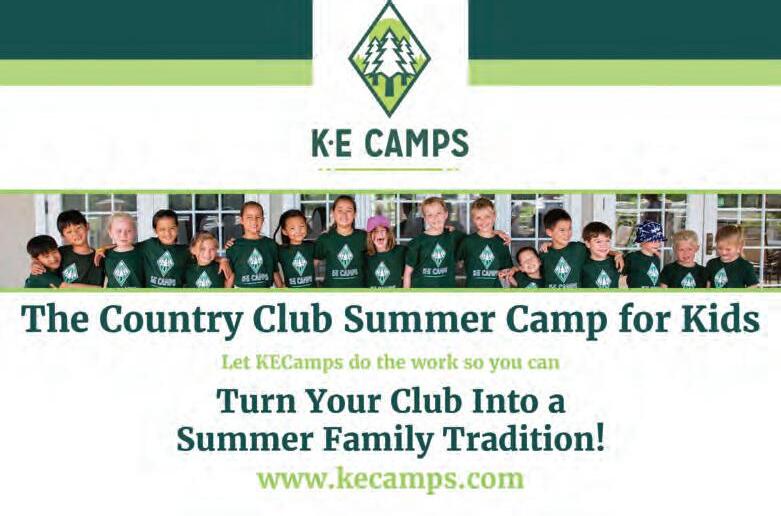
So I asked the room full of managers, “How many of you perform annual performance evaluations at your clubs?” and not surprisingly all but two raised their hands. And so I followed up, “And how many of you look forward to the process?” and no one moves!
But wait, managers love to measure success don’t they? And our employees ARE our most valuable assets aren’t they? And yet, we hate the process that improves service, engagement and retention.
Clubs continue to push the old process with an “even if it kills us” attitude, longing for a different outcome. Perhaps it’s time to try a different approach?
Paisano Performance Partners offers Performance++ staff development software. Clubs using Performance++ are committed to maximizing the benefits of performance evaluation and avoiding the pitfalls of an annual, paper-based process.
So how is Performance++ different? The software is:
• Easy to use
• Club Specific so you measure what you manage
• Goal Oriented for targeted results
• Internet Based ensuring convenient, relevant, timely feedback
Performance++ evaluations are goal driven. As a result, annual reviews are giving way to goal setting and frequent feedback where managers and employees talk regularly about their goals and objectives. Individual and team performance is managed in real time, from a central location, one mouse click away.
Feedback drives performance! If your club is doing annual reviews and hope to achieve better results perhaps it’s time to try Performance++.
Performance++ is a performance review system targeted at your most valuable assets, your frontline employees, where real success happens. Clubs that have adopted Performance++ understand that timely feedback improves employee engagement and heightens member satisfaction!
For Testimonials and more information regarding Performance++ and how clubs are changing the performance management dynamic go to www.paisanoperformance.com/performance-testimonials.html BR




Tennis has often been an isolated entity among the many amenities at most clubs.
With more members looking for a variety of ways to get fit, tennis is a fun, vigorous way to improve your overall health, including your mental and physical fitness. And with the continued growth of the health and fitness industry, it’s time for tennis and fitness to work on their marriage.
The International Health, Racquet & Sportsclub Association (IHRSA) and the Physical Activity Council (PAC) conducted a study just last year that shows more than 63 million Americans utilized a health club in 2014, up 2.3 percent from 2013 when 62.1 million consumers indicated using a health club.
Total U.S. health club memberships exceeded 54 million. The IHRSA study also showed that 54.1 million Americans belonged to at least one of the more than 34,000 health clubs nationwide. Since 2008, membership has grown by 18.6 percent, while the total number of consumers has increased by 19.2 percent over the same time.
Incorporating
strengthening programs as a part of the tennis programming at your club or facility can also help to prevent injury. Stronger players also see improvement. When they’re not injured, they’re able to play more often. When your members are spending more time at your club playing tennis or exercising, they also become engaged with the other amenities your facility offers.
This rise in health club membership shows that Americans are looking to improve their health and wellness, and that’s where your club or facility should be looking to increase your fitness offerings.
One of the core pillars of our strategic plan at USPTA is to work more closely with our allied organizations such as the Club Spa and Fitness
Association (CSFA) and Club Managers Association of America (CMAA) to strengthen our respective industries.
CSFA recently hosted a panel discussion at the Blackhawk Country Club in Richmond, Texas, titled “The Growth of Fitness and Spa Facilities in Private Clubs: Developing Relationships, Enriching Lives and Increasing Member Value.” I had the opportunity to speak at this event about how tennis professionals can collaborate with fitness directors to keep members injury-free, play more tennis and be prepared to play better on court.
Fitness directors and tennis professionals should work together closely to tailor programs based on different ages and abilities. Have the fitness director create individual workout or strengthening programs to improve endurance and performance.
For example, a custom fitness program should be created for ladies leagues to make sure they are stretching properly before and after playing. The fitness director can work alongside the tennis professional to create a specific workout routine for players to improve their performance on the court – another reason for them to keep returning to your club.
Incorporating strengthening programs as a part of the tennis programming at your club or facility can also help to prevent injury. Stronger players also see improvement. When they’re not injured, they’re able to play more often. When your members are spending more time at your club playing tennis or exercising, they also become engaged with the other amenities your facility offers.
Having fitness and wellness incorporated into tennis programming will help prolong activity at the club. When your members are healthy and injury-free, they’re booking more time on the court and spending more time (and dollars) at your club. BR
John Embree is CEO at the United States Professional Tennis Association and can be reached via email: john.embree@uspta.org or (713) 978-7782, ext. 117
You’re ready to move the Feast
IT’S TIME TO BE PREPARED FOR THOSE SPECIAL EVENTS THAT REQUIRE COOKING AND DINING IN THE GREAT OUTDOORS.
With a gentle breeze blowing and the aroma from the grill attracting a hungry crowd, any type of food - beef, chicken, fish or vegetables – seems to taste better when prepared and eaten outdoors. Enjoyed with a carefully selected wine or an ice cold drinkwhat could be better?
Outdoor cooking has never been easier, or smarter, than with the Slimfold Grill. When the assignment is dining alfresco, the elegant Slimfold Grill provides a great presentation for any out-door event. Twin independent grills on The Slimfold 6 offer a combined 1,134 square inches of cooking area. A one-piece design, with no extra parts to wear out or leave behind, and a quality construction gives the grill the enhanced durability demanded by chefs and club managers alike.
- Do it in Style!
Folding down to seven and a half inches and weighing less than 100 lbs they are easy to transport, a snap to set up and have a quick, no-hassle clean-up. The re-circulating heat design of the Slimfold Grill’s firebox makes this grill unlike any you’ve ever used.
First, the heat is kept inside the grill, cooking evenly and efficiently with-out throwing heat and flames back toward the chef. Another benefit is increased fuel efficiency. You’ll get over 12 hours of high temperature cooking from twin 20 lbs propane tanks, so you save on gas and it’s kinder to the environment too! BR
Cinders have been manufacturing foodservice equipment since 1984 serving professionals throughout the UK and northern Europe. In fact, wherever you have a mass of people out-doors you’ll probably find the Slimfold Grills. For more information visit www.foldinggrills.com

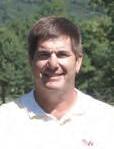
In today’s ever competitive club environment an important consideration of many clubs remains renovations, enhancements and upgrades to the club’s facilities.
In the 1980s and 90s the golf industry in general and club industry in particular operated on the basis of, “If you build it they will come.”
Now, as the environment has become more and more competitive and many clubs are either closing or selling to for-profit operators this has become a question: If you build it, WILL they come?
In recent years, it has become clear that clubs that undertake reinvestment programs, enhance their facilities and price their memberships attractively are turning positive. Clubs that elected to forego improvements in favor of a singular focus on price find themselves at the bottom of the food chain.
Some are simply closing their doors or opening to the public. Others have chosen to recapitalize by selling to a professional (for-profit) operator who promises to invest in capital improvements with no threat of assessment.
Regardless of who ends up owning the club, the question has to be asked objectively whether the suggested or proposed improvements make economic sense. There are several ways to measure this.
The not-for profit club may only be concerned with the cost of the improvements, how to pay for them and what level of assessment would be accepted by the membership.
If the club is seeking to add new members, the question might be asked differently, simply calculating how many new members it takes for the project to be a break-even proposition.
The for-profit club typically evaluates these proposals on the basis of return on investment (ROI), which can be measured by club usage, membership development and the ability to increase dues and cash flow over time.
Many clubs, including those currently thriving, as well as the struggling clubs, need a plan for the future. Pilots are trained to “stay ahead of the airplane” and club leaders, managers and owners need to do the same.
Planning in a realistic and objective manner includes not only the club’s “wish list”, but also consideration of the existing facilities, location and membership profile (present and future). A club that is thriving, and wants to continue to thrive needs to understand where it’s going and change (however difficult) will always be a part of that.
A club in distress often has more difficult decisions. These clubs can’t afford what other clubs might, may have more problems and often need to consider the option least desirable to some of selling the club or alternatively leasing the club or retaining the services of professional management.
Before any decision for the future is made, it’s a good idea for any club to do two things:
1. Establish a mission (figure out what you want to be when you grow up)
2. Analyze all the elements:
a. Membership (present and future)
b. Competitive market
c. Physical facilities
d. Operations
e. Financial
The hardest part can often be establishing a mission. For instance, does a club cater to families, businessmen or some other group? Some will invariably decide that more (or less) rules are needed, that food needs to be a focus or that the only thing that matters is the condition of the golf course. These priorities are different for every club and not always easy to establish. Understanding the dynamics of the market as well as the strengths and weaknesses of the club and its facilities is critical.
A useful study format that would allow leadership to make sound decisions includes each of these and possibly a survey of the membership, though membership surveys can sometimes be deceiving.
Once club leadership is informed, sound decision-making can occur. So before embarking on a costly project, be ready to conclusively answer the question: If you build it WILL they come? BR
Larry Hirsh, CRE, MAI, SGA, FRICS is the president of Golf Property Analysts (www.golfprop.com), a leading golf and club property consulting, appraisal and brokerage firm based in Philadelphia. He blogs on variety of club and appraisal issues at http://blog.golfprop.com
I am often asked to provide an outside, independent perspective of clubs regarding non-member revenue.
In earlier BoardRoom articles, I shared my observations and opinions about “non-member revenue” from a business perspective” and from a tax Perspective. Now for the third question: What’s good from a member perspective?
Many club boards, club management and club consultants believe private member owned clubs cannot survive without generating a significant number of gross receipts from general public usage of their club, i.e., the non-member. Most clubs put on these non-member events without giving thought to the effect it will have on the club’s current and prospective membership.
While club employees are preparing for, and hosting a non-member function, they cannot be directly serving a member as well. No matter how talented your employees are at multi-tasking, they must be very diligent and focused on the job at hand in order to pull off amazing events at the club.
Do your dues paying members care that they are being slighted or overlooked while the club staff is concentrating on a non-dues paying nonmember’s function?
Member displacement: When a non-member event finds itself on the club’s calendar, it is very hard, if not impossible, to cancel the contract to be replaced by a member function. Thus, nonmember usage can take priority over a member’s desire to use their own club. It becomes a game of who calls first. Who is able to plan their function the furthest ahead?
Is it fair to displace dues paying members use of their own club by non-dues paying non-members of the general public?
Non-members wear and tear on amenities: I do not believe non-members are any more abusive of club amenities than members. However, I am aware that the more usage of any club
amenity, the quicker it will become worn and tired looking. When the club must replace those amenities that have been consumed for both member and non-member functions, who does the club look to for the funds? Can you send non-members a bill for their portion of the cost to replace club amenities?
Is your club accelerating the aging look of your amenities with non-member usage? Is your club billing and setting back funds from non-member usage of your club amenities to assist in paying for future renovations and replacements?
Members believe non-member usage keeps their dues low: There is this perception that extending the usage of a private member owned club to non-members and persons of the general public keeps members annual dues lower than they would otherwise be. From the club controllers I have talked to, this may not be the case.
Has your club calculated how much non-member revenue is adding to the available cash of the club?
Clubs tell me they are in the people pleasing business. The question to ponder is whether your club has unintentionally put members and non-members on equal footing, even though one pays an initiation fee and annual dues while the other does not.
Is non-member revenue good for a club from a business, tax and member perspective? I believe not. Finally, I have this burning question I just cannot get off of my mind. If I can use your private member owned club for my company Christmas party, for my daughter’s wedding, for my annual business conference and for my favorite charity golf outing as a non-member, why would I become a member and start paying annual dues? BR
Mitchell L. Stump, CPA was recently identified by Golf, Inc. as one of 10 most recommended consultants in the golf industry. Mitch is the author of club Tax Book, celebrating its 20th anniversary of publication. He addresses non-member revenue with private club subscribers almost daily. www.clubtax.com



Whenever and wherever I get the chance, I proudly tell people that superintendents manage the largest and most important asset of any golf facility: the golf course.
And golf course management professionals have deservedly earned a loud and unified voice for advocacy within the golf industry.
But it takes all of us in the golf business to make a difference.
Whether we are talking about a superintendent’s role in preparation for a major championship, helping golf courses recover from tragic heavy flooding, or lifting up our environmental champions, we are golf.
The phrase is a simple one, but one that has propelled the golf industry toward greater recognition among Washington, D.C., legislators who lumped golf in with the “sin industries” that didn’t qualify for disaster relief to help rebuild in the aftermath of Hurricane Katrina in 2005. Golf was right there with liquor stores, massage parlors and tattoo shops.
Since that time, the golf industry has made great strides. Leading organizations in golf have come together under the We Are Golf umbrella, and are telling the positive story of golf.
We have worked to change the golf’s perception among legislators by hammering home some of the core economic benefits of the industry – an annual economic impact of $69 billion, $4 billion in charitable contributions, and two million jobs.
We have made strides to change the negative perception of golf, and today we can show continued environmental stewardship and conservation through science-based measures.
Many now view golf course management professionals as experts, including our allied groups that make up We Are Golf. In addition to GCSAA, that includes the Club Managers Association of America, the National Golf Course Owners Association, the PGA Tour, the PGA of America, the USGA and the U.S. Golf Manufactures Association. All of these groups strive to support each other and promote the game’s successes.
Together, we are pressing forward to address superintendent issues with labor, increased regulatory pressures, and managing water use, to name just a few. We must stay together, unify our voices and continue to meet challenges. Mother Nature, too, gives us continual challenges. Most recently, people’s lives were torn apart by flooding in Texas and West Virginia.
The golf industry is united in support of those hardest hit by these tragic events, and I recently visited some of the devastated golf courses in the Houston area, and have heard from members in Greenbrier County just how bad things have been in West Virginia.
Greenbrier County was hit with 10 inches of rain in a 24-hour period, leaving lives and property devastated, and golf courses ruined.
“The water just kept rising and rising, and before we knew it, we were going into survival mode,” explained GCSAA member Josh Pope, the superintendent at the Old White Course at The Greenbrier Resort.
“It all seemed to happen in the blink of an eye. A lot of our employees lost everything they had. We’ve all been affected here. It is devastating to everybody.” To add insult to injury, a PGA Tour event scheduled for the Old White course in June was cancelled.
GCSAA is there for its members and we will continue to advocate on their behalf so that our communities continue to view superintendents as experts at managing golf courses. Regulators should trust that we use best management practices, because we can demonstrate it. As a whole, the golf industry has come a long way since being confronted with misperceptions in the aftermath of Hurricane Katrina 10 years ago. We have also benefitted from the unified work among golf organizations.
Together, We Are Golf. I look forward to seeing how far we can progress together in the next 10 years. BR
Rhett Evans is CEO of the Golf Course Superintendents Association of America.
Why USGA greens start to stress between the second and third year of their existence and what we can do about it is probably the most important thing that we as a group (general managers, superintendents, club pros, boards of directors, green committee members and golfers) need to understand.
It’s very difficult to educate everyone who is on the board of directors or the greens committee because of the transitional nature of boards and committees – there’s generally turnover every year.
It is also very difficult to educate our golfers who, when they belong to the club just want to get away for a few hours and enjoy their camaraderie and the game with their friends.
But we, the general managers, golf course superintendents and club pros need to know how golf greens age and what is needed to keep the greens in good condition so that our members can enjoy the game and the facilities.
The number one cause of green stress/failure is because of a buildup of organic matter in the top one to two inches of the root zone. Let’s assume that we have roots to a depth of five inches.
For many years, people in the industry wrongly assumed that the root produced organic matter the entire length of its shaft when in fact 95 percent of the organic matter is produced in the upper one to two inches of the root shaft.
To properly understand this organic buildup, I like to compare the organic production to that of our skin producing oil. This production is constant as long as the plant is not dormant.
It’s important to understand that a root zone consists of two main components. Solids and pores. Pores are the spaces between the solids.
There are two types of pores. The larger pores hold oxygen as the pull of gravity is strong enough to pull water out of these spaces leaving them to hold oxygen. The smaller pores hold water/moisture so tightly that the pull of gravity is not strong enough to remove the water from these small spaces.
Roots cannot live in solids or water, which means they can only live in the larger air pores. The organic material produced by the roots is thus deposited in the air pore/cavity.
As the organic accumulates in the air pores, it reduces the size of the open air pore thus reducing the amount of oxygen available to the plant.
Plants breath through their roots (taking in oxygen and producing CO2).
Once the amount of space in the air pores is reduced to a level where there is not enough oxygen for the plant to breath properly, the plant starts to stress, resulting in weak turf and the plant becomes susceptible to disease.

the number one cause of green stress/failure is because of a buildup of organic matter in the top one to two inches of the root zone... For many years, people in the industry wrongly assumed that the root produced organic matter the entire length of its shaft when in fact 95 percent of the organic matter is produced in the upper one to two inches of the root shaft.
On new greens, start monitoring physical properties after the first year of play. For established greens, have a physical properties test done to establish a benchmark as soon as possible, because this benchmark will tell you what needs to be done in regards to agricultural practices to keep the physical properties in balance. And that’s mainly oxygen BR
Dave Doherty is CEO and founder of the International Sports Turf Research Center, Inc. (ISTRC) and holds three patents regarding the testing of sand and soil-based greens. He can be reached at (913) 706-6635 or via email: daveistrc@hotmail.com www.davedohertyistrc.com

Advances in technology are happening quicker in the last five years than in the previous 40 years.
Each and every year we can expect new technology that will make our golf courses more efficient and also better managed.
It would take at least two full days to view all the latest in equipment, software, seeds, fertilizer, etc. So here are a few new items that show some great promise.
Moisture sensing: Less than a decade ago there were many superintendents who would cut a small wedge out of their greens to evaluate the moisture levels. However, now there are several companies that offer the latest technology in measuring soil moisture, temperatures, salinity and pH.
More importantly is the ability to gather this information quickly and put it in a format for the golf course superintendent to make a variety of decisions to best manage their greens.

Carmen Magro, vice president of business development for Stevens Water Monitoring Services, travels the world assisting golf course superintendents and golf facilities on methodology to monitor these factors. Carmen feels strongly about putting values to trends and variable measurements while correlating those with specific turfgrass responses.
When a superintendent sees a variety of symptoms on their greens it definitely could
have been prevented by the measurement of trends with the technology available to us today. Through the use of portable measuring devices, it’s very routine to measure and track things throughout the growing season. POGO is one such system, that along with Spectrum TDR 300, that is commonly used on most golf courses.
Drones: For those that think drones are predominantly used for military purposes…here’s another thought.
They’re now being used, at a reasonable cost, for golf courses. In recent months I have watched drones being used at a variety of golf courses where the superintendents have purchased their own units. It may take a few flights to get the hang of it but several friends have mastered it without having to have a pilot’s license.
So what do these drones do? If you have ever considered a flyover of your golf course it can be done with a drone costing about $1,000 and an iPad for steering. Add a Go Pro camera and you have all you need to get started. Perhaps the more difficult part is learning the editing to add script and music. Highly likely that younger interns and assistants will know how to do this!
Bob Vaughey, CGCS, the director of agronomy at Rolling Hills Country Club in Southern California, is well versed in all the latest technology and happily shares his knowledge in this area with his fellow superintendents.
Bob’s latest evaluation is looking at thermal mapping. This can be used for monitoring irrigation efficiency to better manage irrigation applications. Also, as golf course construction is underway, Bob is able to capture all of the work done on the property and memorialize it. Knowing communication is key it allows Bob to keep his membership fully informed of the progress being made.
Golf course management platform: OnGolf, a cloud-based golf course management platform, monitors and reports essential operational and agronomic inputs that lead to economic efficiencies while improving playing conditions’ consistency.
This platform brings all the course data into one place for golf course superintendents to manage it. This system incorporates a variety of
data collection mechanisms including all the capabilities of moisture sensing from companies like Spectrum Technologies and POGO.
Walt Norley, founder and CEO of OnGolf says, “one of our missions at OnGolf is to make golf course management less expensive and more efficient at every level while improving playing conditions.”
A system like this not only benefits the golf course superintendents but it also allows for data tracking for management and multiple course operators. Walt indicated that technology in its many forms is finally arriving in the integration of smart phones, iPads and digital transmission from pumping stations and such.
Several users of OnGolf have told me that the return on investment is short and that within a year they have seen up to six figure savings. The integration of all course software and hardware into one place provides actionable analytics that lead to performance improvements and cost reductions.
Some think that technology is moving at such a fast pace that waiting until next year is the best decision. To the contrary, the technology will only get better with time. Utilize systems and technology that make the job easier and have the potential to make your operations more economical.
As the cost of operations continue to rise along with the costs of labor it will be crucial for golf course operators to create and maximize efficiencies. It’s up to those in management and governance to encourage the people in operations to seek out such technology. The future is now! BR
Bruce R. Williams, CGCS is international marketing manager for Grigg Bros./Brandt and a past president of GCSAA. He can be reached at: brucewms1@hotmail.com
The recent wildfires in California were devastating to homeowners and business owners alike. In speaking with our customers, we got a different perspective on the impact and how insurance plays a vital role during these catastrophic events.
The lessons learned from the wildfires are many. Below are just a few of the most important thoughts for your club.
• Update your Statement of Values to review your building and business personal property limits at today’s replacement cost.
• Review your limits for Building Ordinance or Law Coverage for any code or demolition expense.
• Are your limits for member’s property adequate? Including the storage of golf bags that are in your care custody or control?
• One coverage item that is extremely valuable and that can be overlooked or misunderstood is Business Income and Extra Expense. Many clubs may underestimate the limits needed.
• One of the key points to review and understand is the definition of Business Income. This includes not only loss of income but coverage for continuing expenses including payroll and extra expense to keep your business in operation.
• Finally, take the time to complete a Business Income worksheet to help determine the limits needed.
Our focus at EPIC Golf Insurance Services is to provide a proactive approach to the proper coverage and limits your club needs and help prepare you for the unforeseen events that may occur. BR

“that’s
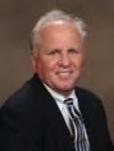
The art of growing grass has changed dramatically over the past decade and we can no longer resist or ignore some of the technological advancements available to golf course superintendents.
These cutting edge tools no longer focus entirely on the science of turf grass, but equally in the areas of communication, organization, financial management and many others. The golf course superintendent does not have to embrace every new product or idea that hits the market, but they should always identify the most important ones for their club or golf course. There is no doubt spending my entire career in this industry I’ve seen an explosion of technology that has helped build sustainability in the industry and more importantly to individual golf courses. Here are some of these advancements I have experienced in the field.
Computerized irrigation systems that work with weather input to set water schedules and collect data to manage water usage and ultimately the related costs. Related technology is:
Rain Bird’s integrated sensor systems (ISS) gives you an accurate snapshot of soil moisture conditions to optimize turf health. The intelligent monitoring analyzes soil moisture and calculates water budget recommendations for any golf course. There is a course we operate in Arizona that has trended towards 10-20 percent water costs savings and is ultimately producing sustainability back to the environment.
Weather stations/weather websites that report evapotranspiration, solar radiation, growing degree-days, rainfall, etc. These help make decisions not just on water usage but also herbicide and growth regulator applications.
Globalpositioning systems (GPS) technology in my opinion has been a game changer for golf course superintendents and those who resist some of these tools will miss a great opportunity to improve their quality and efficiency. Here’s a few that I have observed or worked with in the field:
Sun Seeker app gives the ability to see the sun’s path on any day and time, not just the current day…a 3D live view to see the actual sun’s path of the trees you are looking at pruning or removing to improve turf.
Nu Tec Soils is the unique information technology for nutrient management plans. The software builds the customized maps for balancing soils and ultimately improving plant uptake and efficiency. This technology extends into spray equipment with automated steering for your sprayer and GPS management of your spray boom and nozzles. For instance, spraying only diseased areas or where the weeds are located. The initial investment is high, but I worked with a club that reduced their fertilizer and chemical budget by $150,000 or more after investing in this technology.
Pogo Turf Pro Systems has a unique integrated sensor that measures moisture, salinity and turf canopy temperature. The readings, collected for greens, tees or fairways, can be transferred immediately to a cell phone or tablet. The device becomes a data acquisitions system that begins to assist in making decisions on water, nutrient management and thresholds for disease. It also can be used to map your course and gather readings by the areas mapped.
GPS Mapping from numerous companies provide accurate square footage and acreage of all your golf course features. The superintendents can archive electronic as-builts for irrigation, drainage and renovation. These software programs can assist in building accurate cost per acre for chemical treatments of greens, green banks, fairways and other areas of turf. This same information can now provide the cost per acre for labor maintenance of your course, not based on an 18-hole golf course, but total acreage of your golf course to determine accurate staffing levels.
We have heard the adage many times, “It is not about growing grass anymore it is about managing people and budgets” and that has been so true with the challenges of hiring, training and the retention of good people.
Our superintendents continue to be challenged to work with smaller staffs, operating budgets and at the same time improve course quality. This is why these management tools that are coming to the industry should be looked at seriously to improve quality and efficiency, without adding additional resources. Some we have started to implement at courses include:
Fairway IQ is a data analytics system that provides an operator air traffic control view of everything moving on the golf course, to support staff effectiveness and respond to member and guests during their golf round. The ability to track equipment and manpower that correlates to tee sheets can be powerful for any superintendent.
Digital job boards that are a fantastic organizational tool for the superintendent have moved beyond the white dry eraser boards. The digital board will capture the past and eventually provide historical data to track where you are spending your labor and the cost associated with these areas of the course. This undoubtedly will allow you to consider equipment to reduce work hours so this labor can be shifted to other areas of the golf course.
We haven’t even scratched the surface of technology that is being introduced to our industry. To understand what is most important to each superintendent should be based on where improvement is needed in turf quality, playability and operationally. This is all predicated on your resources to invest in this technology and making the right decision on what is most important.
This brings me to my most important point with “cutting edge technology” and how this information can provide clarity for making the right decision. Ultimately, you still have to have a great decision-maker leading your golf course so you can analyze and process this information to make the right decision.
What I’m saying is all the technology that is changing our industry can’t be optimized without a great decision-maker. Hmmmm…is there technology for this? BR
Dean Wochaski is president/agronomist with Golf Maintenance Solutions. He can be contacted at office (757) 427-1712 or cell (757) 685-5556 or at: www.golfmsolutions.com
Hilda W. Allen (HWA), an industry leader in golf course, leisure, and resort real estate transactions in the mid-Atlantic and Southeastern regions of the United States, is optimistic about investment opportunities for both buyers and sellers. It’s time to “invest in the future of golf,” says Allen.
She is the first woman to ever be inducted into the Georgia Auctioneers Association’s Hall of Fame and has held The BoardRoom Magazine’s “Excellence in Achievement” award for four consecutive years now.
Having sold golf course related properties totaling more than one billion dollars, Allen is confident that the industry’s future outlook is one of a sound investment.
According to Laira Martin, in Golf Inc. Magazine’s January/February 2016 issue, Hilda W. Allen is “The busiest woman in golf.” This is evidenced by the numerous closings HWA effectuated in 2015 and the first half of 2016. A couple of those closings include Bear Creek Golf Club in Hilton Head Island, SC designed by the famed architect Rees Jones, as well as a Jack Nicklaus Signature 18-hole course in Dahlonega, GA located in the Achasta community.
Busiest woman or not, Hilda W. Allen is a part of every transaction and with her team of seven professionals plus her numerous affiliates, they are not limited to any particular region of the country. BR


What is a perk? A perk (as a noun) is defined as extra money, privileges, fringe benefits, etc. pertaining to a job or assignment.
A perk for me as a Grand Valley State University faculty member is the ability to exercise for free at the university’s $6 million recreation center, or reduced pricing to exercise through a corporate membership at a local YMCA.
A perk for a country club or private golf club employee is often a free meal if the employee is working an eight-hour shift. Another perk is typically the ability to play on the golf course on Mondays (or a Tuesday if Monday is a national holiday), if/when there are no scheduled events.
Of course, employees must wear proper golf attire according to the club’s policy, etc. while on the course, and typically cannot bring guests. Or, if they can bring guests, the guest(s) must be approved by the employee’s department head or club manager.
Oftentimes, too, employees must obtain permission from the general manager or club pro before taking a guest on the course. And frequently, golf-playing employees are not allowed to use golf cars; in other words, they must walk and carry their clubs.
These – or slight variations on the above –are the policies at clubs ranging from Wellesley Country Club (Wellesley, Massachusetts), to Birmingham County Club (Birmingham, Michigan), to Atlanta Country Club (Marietta, Georgia).
Plain and simple, employee handbooks make it clear that there are differences between the rights and privileges of employees and members. Members are, well, members, while club employees are expected to – and be responsible for – providing service at the highest level to members and their guests.
For the ability to play golf at a private club, members pay hefty initiation fees, monthly dues,
supplemental dues, and fund capital improvement projects, with annual dues ranging from $4,000 to upwards of $15,000. They have monthly food minimums. Members pay extra for club storage and cart rental. There may be additional annual charges if they choose to play in a golf league or participate in tournaments or other special events.
Should these same benefits be extended to club employees? It’s an interesting question.
On one hand, an employee might be a member’s guest for a round of golf. If a single gentleman strikes up a relationship with a cute server in the dining room (who also happened to play golf), what prevents them from playing 18 holes together – if he (the member) is charged guest and golf car fees for her (nonmember employee)?
After all, they’re going on a date – just as if they were going to the movies. So, this would probably be condoned/allowed.
One “positive” might be that while playing a round of golf with a member, the employee would have an opportunity to observe first-hand the condition of the course, how members are treated by club staff, etc., which could be shared with club leadership.
But, when do non-member employees perks stray too far? Should a non-member employee be allowed to play in golf leagues, tournaments or other special events? In other words, those activities and events that are otherwise only open to full golf members?
(More recently, many clubs have gravitated to tiered memberships to boost membership, for example, by offering limited membership –essentially a social membership with an option to buy a limited number of pre-paid rounds of golf, often with restricted play dates. And, these limited members are restricted from playing in leagues and other special events.)
So if eligibility to play in golf leagues, tournaments and other special events extends to non-
member employees, to which ones does it apply?
The general manager?
Club controller?
Marketing and communications director?
Golf superintendent?
Or those who slave away in the kitchen (e.g., executive chef? sous chef? line cook?)?
Further, if these perks extend to employees, do they also apply to the employee’s family… spouse, significant other, or children?
It’s a can of worms.
One issue to be addressed: If members’ spouses and children are not permitted to work at the club (another common policy at private clubs), why would the reverse be acceptable?
That is, why should an employee have the same rights and privileges as a member?
Moreover, how would the limited member (referred to above) feel about watching club employees participating in league play during prime golf season when their sixround play-pack is restricted to use either before Memorial Day or after Labor Day?
As one long-time country club member observed, “It’s great for all the people who aren’t members. If they can play golf at a private club for free, because they’re exempt from dues, dining minimums and the special assessments, I’m the one who’s paying all the dues and operational costs so they can play for free!”
Nancy Levenburg, Ph.D., is a professor in the Seidman College of Business at Grand Valley State University in Grand Rapids, Michigan. She is the President of Edgewater Consulting, and is a member of Spring Lake Country Club in Spring Lake, Michigan. For more information, contact Nancy at: levenbun@gvsu.edu or (616) 331-7475.



The students gather. There’s a buzz in the room –subdued. It’s the first day of the eye opener certification class.
The students are eager to learn, primed to absorb, ambitious, wanting the perks and the privileges of a certified eye opener – the badge, the bucks, the glory.
The door opens. Heads turn. The instructor enters and gives everyone The Look. The Seekers of Certification gulp, tremble and go silent.
“Welcome, newbies, to this, the first day of eye opener class. Listen up, write lots and ask questions.”
The Seekers of Certification listen, all ears.
The Eye Opener takes a gulp of high octane double strength caffeine from his certified eye opener mug, puts his cup down with a clunk and continues.
Eye Openers know that it’s not what you’re looking at; it’s what you see. We, The certified give sight to the blind. Our motto: Point your finger and I’ll tell you the story!!! Not just what you’re looking at, but its history, the why behind its choosing, the who who decided and the how it came to be. The eye opener is a story teller who weaves facts, myths and philosophy into the explanation of the stuff the blind are pointing at.
The Seekers of Certification look at each other, mouths open, hearts pounding.
“Eye Openers see the wonderfulness of where you are, what you’re seeing and what you’re doing. They see the universe in a plate of eggs.
The Blind see steaming yellow mush – Eye Openers see the cook who scrambled the eggs, the truck that delivered the eggs, the farmer who gathered the eggs and the chicken that laid the eggs. Eye openers see the journey from place to plate and are buzzed by the knowing and the telling.” EGGS?
Eye Openers want to stimulate The Blind to wonder why and to ask questions. Why was THAT lamp chosen? Who chose it? What committee oversaw the selection? Why use a 40-watt bulb and not a 60 watt? Where’d the money come from to pay the designer and to buy the lamp?
LAMPS??? The “Seekers of Certification” rub their chins and squirm.
Q and A – The Eye Opener takes another gulp of his double strength certified eye opener caffeine, gives each of the attendees the look, and continues.
“The key to your Eye Opener certification is curiosity – to look closely, to focus, to ponder and to ask questions. I need to see that each of you Seekers of Certification have the passion for asking. So ask, and be judged by ME, a level seven Certified Eye Opener!!!”
The Seekers of Certification stare. Silent. They gulp. Sweat. Fidget. Look at the floor.
Lucy Locker Room raises her hand. “Why are we, who are already supervisors, required to take this class in eye opening???”
The Eye Opener grunts. “Each of you has position and potential but few of you know the why, when and how of the stuff you’re looking at. certification class will open your eyes and give you the buzz for the familiar and the routine. And that knowing will inspire you to give sight to The Blind!”
Joe The Pro raises his hand. “Give me an example of Every Day Eye Openers – people “who see” but haven’t been certified.”
The Eye Opener takes another gulp of high octane certified eye opener caffeine then jumps on the question. Eye Openers are everywhere, in every department. An Eye Opening caddy explains, with enthusiasm, the contour of the land, the history of the course, the placement of the pin.
“An Eye Opening waiter talks about the wine, where it’s from, why it’s on the list and what foods it pairs with. Great employees are natural Eye Openers because they’ve asked the questions, listened to the stories and trained their eyes to See the stories bubbling beneath the surface. Supervisors who are certified Eye Openers are responsible for bringing Everyday Eye Openers to a higher level of insight, understanding and enthusiasm.”
Shirley Sous Chef raises her hand. “What’s in it for ME once I’m certified?”
Certified Eye Openers are worth more and get paid more. Eye Openers get more love from
members and staff because members and staff appreciate seeing the wonders in what they’re looking at and celebrate those who help them see those wonders. And more importantly, Eye Openers see their own lives – filled with the ordinary and the routine, as a very big deal. Certified Eye Openers find more joy in their club, their clubhouse, their members, their staff, their friends and their loved ones.
Pat from the parking lot raises his hand. “Why does an already popular club like ours need Eye-Openers?”
The Eye Opener drains his mug of high octane eye opener caffeine. “People join, stay and spend at clubs that deliver memorable moments. Eye Openers help members see the memorable in the everyday, enlarging and enriching their visit. So they stay. And they pay.”
Rita from resales raises her hand. “What’s needed to do Eye Opener right???”
Eye Openers reach out and engage people; ask tons of questions, are great listeners, take lots of notes, know how to do research, are great story-tellers, have big happy, and are relentlessly positive about everyone and everything. Matt in maintenance pipes up. “Eye Opening sounds a lot like reverse engineering a machine, disassembling it, examining the pieces and figuring out how it works. Right or wrong?”
The Eye Opener glows!!! Right on. Reverse engineers tear things apart and dig deep into the who, the why, the how and the where of the finished product. Right on!!!
Max from maintenance raises his hand, tentatively. “What tests will I have to take to get certified???”
The Eye Opener looks in his mug…almost empty! “To get certified, you’ll take a fact based written test, a 50 photo what’s this picture mean test and a walk around the club-
from Distinguished Ideas |84
“The leadership development committee searched me out. I was flattered!” Tabit explains. “The LDC members felt I had leadership skills, so I was assigned to the building and grounds committee. I’m in the finance industry, and don’t know the difference between a nail and a hammer, but I do know how to find people who have the right skills, communicate with them and get the job done. For me, the process was great.
“The LDC is not about the present,” Tabit continues, “it’s about the future. It’s about envisioning the future of your club, and creating a talent pool of leaders from which to choose.
“Today, all our board members have gone through the LDC. The process is working. LDC works. Our
house storytelling test. The toughie is the walk around. We’ll walk the club, I’ll point my finger and you’ll tell the story. Getting the facts straight, delivering the message with The Buzz and telling the story with wit and enthusiasm will be judged. Not easy but a genuine HOOT!!!”
The Eye Opener takes a last big gulp from his mug of high octane eye opener caffeine. People need Eye Openers to keep them buzzed about the usual and the familiar, to erase the ho hum from the day-to-day, to energize their sense of wonder.
Eye Openers help those who are blind to see in ways they’d never have seen without an Eye Opener’s guiding hand. Eye Openers are like painters who illuminate the glories of a ho hum sunset or the writer who transforms another round of golf into a magical journey through the countryside. By sharing what they’ve seen and helping those who are blind to see in new and special ways, certified Eye Openers create relationships that enlarge and enrich their own lives. Eye Openers live happier lives, and they help those they touch to live bigger, richer, happier lives than they’d otherwise lead.
“So…do your homework, prepare for class, ask questions, open your eyes and…enjoy the journey!!!” BR
Gregg Patterson served the Beach Club of Santa Monica as its general manager for 33 years before retiring earlier this year. He’s also one recipient of Boardroom magazine’s Award of Dedication for 2015 for his timeless, energetic and dedicated service to the private club industry. Patterson is president of Tribal Magic and can be reached via email: GJPAir@aol.com
members are hearing the message loud and clear and are stepping into those leadership roles, because at the end of the day, that is what a healthy club needs – leadership, ” Tabit adds.
“I’m really proud of this method and the work that has been done to set it up and make it a success,” says Howard. “What we get is a system that balances a data driven process for identifying people without bias along with the important personal knowledge and human aspects of people, giving us a really informed and solid list of potential committee participants.”
Yes, this process gives the Bel-Air Bay Club a view down the road of the ‘big picture’, and just what the club’s members can expect from discerning committee members, and aspiring potential board members in the future. BR
Newman lists the treatment of employees, image and financial stability as among the entities over which governance should provide oversight.
GGA’s Johnston adds: “Culture in a private club is all of the issues –ethos, brand and financial profile –influenced by proper governance.” Board members who believe they answer to no one do so at their own peril these days. As this simple checklist brings focus, they do have to meet certain “stinking” obligations. BR
Henry DeLozier, a recipient of the BoardRoom magazine Lifetime Achievement award for 2014, is a principal of Global Golf Advisors. You can contact him at hdelozier@globalgolfadvisors.com. from Global Perspectives |12


“Seriously, Chris! Do you know how much trouble I’m in over that Facebook photo? My boss saw it. My co-workers saw it. What were you thinking? I’m a manager, I can’t be seen playing golf at midday unless it’s with a client. Certainly not in the club’s event. Man, don’t ever do that again.”
“Bill, what are you talking about? It was a great photo of you hitting a tee shot off the first hole with a whole group of members in the background watching. It was classic. I had no idea that you could get tagged and it would go viral!”
There are two issues at play in this dialogue: the appropriate use of social media, and the appropriate way to apologize!
Member Bill clearly was harmed by the posting of his photo and, understandably, upset about its effect on his professional reputation. Manager Chris had thought that it was a great photo and that putting it on the club’s Facebook page would make Bill feel good about himself and the club. Chris didn’t anticipate that there would be negative repercussions for Bill.
Social media at clubs can create a number of difficulties when it’s not carefully deployed. For example, if the club’s social media output is perceived as “advertising”, this can cause damage to the club’s reputation and might complicate the membership selection process.
Posting pictures of members without their permission is another thorny issue. Chris clearly did not have permission to use Bill’s photo. Luckily, Bill was a good member and did not press the issue any further than a verbal reprimand.
Photos can be set “private” on social media, but this does require a few additional steps beyond simply hitting “post.” Many clubs believe that making the club’s Facebook page a “private page,” accessible only to approved Members, will address all privacy issues. However, even with private pages, certain in-built Facebook features can cause photos to become visible in places where they weren’t originally posted.
For example, an album posted comes with a “face recognition” feature. Members may be automatically tagged in photos through face recognition as an album is uploaded to Facebook.
Be aware of this important feature. All tags should be manually removed from photos before you post them on the cub’s page. This takes about
two minutes, and it is well worth the time to ensure the privacy of our members.
Most Facebook users don’t remove these automatic tags from their photos, because photos are such a big part of our entertainment and our social lives today, allowing us to preserve moments and share them with others. But if someone is tagged in a photo, even on a private page, the photo will appear in their friends’ newsfeeds. That’s how Bill’s photo was seen by his boss and co-workers.
Members have the option of tagging themselves if they like a photo, which can be a great way for members to share happy moments at the club with their friends. After a competition, the club may post of photo of the winner holding the trophy. Moments after posting, the member may choose to tag themselves in the photo and share the accomplishment.
This self-tagged photo will then appear in that person’s friends’ newsfeeds, allowing friends to “like” the photo and post congratulations. When the member has control of their own privacy, the outcome tends to be much more positive.
When an accidental social media faux pas does occur, it’s important to apologize promptly. According to Ohio University professors Roy Lewicki and Robert Lount, Jr. and Eastern Kentucky professor Beth Polin, there are six components to a good apology: an expression of regret, an explanation for why the offense occurred, an acknowledgment of responsibility, a declaration of repentance, an offer of repair, and a request for forgiveness.
In the club business, a fact who is “right” or “wrong” is of little importance. The GM is always wrong—always apologize! Chris should have responded with something such as, “Oh, no Bill, that’s terrible. I thought you hit a great shot and just wanted to share it with the other members. It’s my fault entirely, and I am so sorry. How can I make this up to you? Please forgive me.”
A bit of groveling, perhaps, but as we all experience, “GM” sometimes stands for “Grovel Master,” What matters is that it works! BR
Rachelle Reali is the director of member communication and MacDonald Niven, CCM, CCE is the general manager at La Rinconada Country Club in California and can be reached at (408) 402-7475 or via email: rreali@larinconadacc.com and (510) 439-8522 or via email: mac@niven.cc respectively.

For a number of years, many golf clubs have faced challenges in maintaining a strong and vibrant membership base.
Without a steady stream of new members, clubs have confronted holes in operating budgets and have had to resort to contractual rights and remedies to maintain revenues.
Sometimes, governing documents will permit departing members to recoup initiation fees only upon the entry of replacement members. Arguably even more draconian, certain clubs prohibit members from resigning until new members join. In those circumstances, recalcitrant members are faced with demands from clubs that they continue to pay dues.
Such is the situation at South Carolina’s Callawassie Island Club, where a South Carolina trial court in 2014 held that the club’s governing documents unambiguously required members to make such payments.
However, with a recent decision, the South Carolina Court of Appeals has reversed the lower court’s ruling, holding that, in fact, there is ambiguity in the documents, which must be sorted out in a full trial.
The Court noted that the 1994 governing club documents provide as follows:
“Any member may terminate membership in the Club by delivering to the Club’s Secretary written notice of termination in accordance with the By-laws. Notwithstanding termination, the member shall remain liable for any unpaid club account, membership dues and charges (including any food and beverage minimums).”
from Technology Feature | 33
issues list with them on a regular basis few of your items will be addressed. (This is the biggest hurdle to get over since most clubs feel that it is “unfair” that the vendor doesn’t take on this responsibility. “Unfair” or not, it’s the common reality in the club software business.)
By getting serious about ongoing user training, creating an issues list and keeping it in front of the vendor, and accepting the reality (unfair as it may seem) that you have to take charge and be proactive, your satisfaction with the club’s existing software should increase significantly.
So instead of asking, “Which new system should we be
However, the court also noted the existence of other documents, including a 1994 Plan and Bylaws, which “provide resigned members are obligated to continue to pay dues until their memberships are reissued. Further ambiguity is found is in the 2009 [governing club documents], which provide that members who have terminated their club memberships remain liable for unpaid dues until their membership is sold. The term ‘unpaid’ is not defined in the documents. It is unclear whether the language relating to unpaid dues refers to unpaid dues owed at the time of resignation or unpaid dues accruing before and after resignation. Thus, we find the evidence relating to the issue of whether Appellants were obligated to pay dues post-resignation, viewed in the light most favorable to Appellants, leaves a genuine issue of material fact for trial and, thus, precludes judgment for Callawassie as a matter of law.”
The court also found that a trial was warranted as to whether a resigning member’s dues obligation should cease after four months, pointing to this language in the governing documents:
“Any member whose account is delinquent for sixty (60) days from the statement date may be suspended by the Board of Directors. . . . Any member whose account is not settled within the four (4) months’ period following suspension shall be expelled from the Club.”
Acknowledging that expulsion does not necessarily correlate to a voluntary resignation, the court found there to be sufficient ambiguity to warrant a trial on this issue. BR
buying?” you may find yourself saying, “Sure glad we didn’t pull the trigger too soon on our old software.”
Bill Boothe is president and owner of The Boothe Group, LLC, an independent consulting firm that helps clubs understand computer technology, make good decisions and receive the highest value from their technology investment. During his 25 years in the club industry Bill has assisted more than 350 private clubs with the planning, evaluation, selection and implementation of computer technology in all facets of their operations. Bill can be reached at bboothe@boothegroup.com.

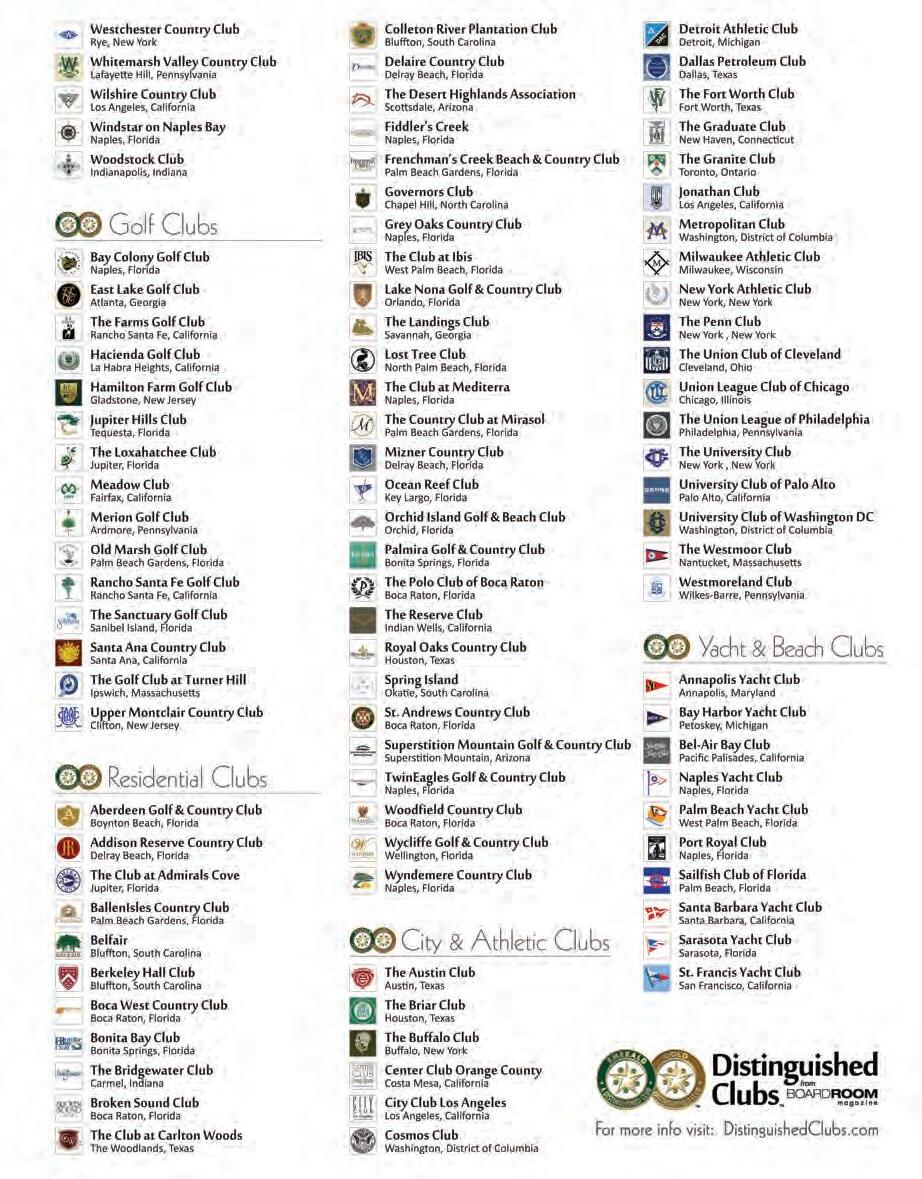
Gordon Welch, a former private club manager recently named president of the Association of Private Club Directors (APCD) says, “boards have a duty to monitor board performance, period.
“A performance report should be distributed annually so the board can score how the board members think they are as a group and as individuals. The general manager should also have input on this, and the GM may have a different experience with a board member than the full board has.”
Welch also offers another idea to monitor long term plans.
“Boards should have a ‘floating’ directorship that is appointed to the board that will oversee any long range plans. This position is not a voting position but an advisory position. The board member will participate as a director of follow-through.
“Having this position will give some stability through the process and historical knowledge. Many boards do not have this position, but in my opinion, it’s a good idea,” Welch offered.
“The board has a duty to measure its performance against the strategic plan, as well as the club’s greater vision and mission,” opined Skip Avery, executive vice president of Chambers, an industry planning and design firm, and a past president of the Club Managers Association of American.
“After all, performing in accordance with those goals is the point of having them written down in the first place. A strategic plan creates a stable environment for the club’s long-term health, establishing common goals and a common thought process that would otherwise evaporate whenever the board experiences 100 percent turnover.
“Boards need to utilize the strategic plan and long-term thinking to keep the club moving in the right direction,” he emphasized.
“Duty might be a strong word,” suggests Frank Gore of Gore Golf, and chief analyst for BoardRoom’s Distinguished Club program. “The board should have a long and short term strategic plan for the club, and it should include membership goals in both enrollment and retention. The plan should also include capital repairs, replacements and new improvements.”
While boards have a duty to monitor their own performance, they also must play the regular role of keeping management focused on the long term health of the club.
“As I’ve mentioned, boards must play an essential role in maintaining the goals and objectives of the strategic plan. In order to do this, they first need to understand their place in club governance,” Avery added.
“They (the board) are the ‘what’ in the equation. They determine what the club is going to do, who the club is
going to be, and, who the club is right now. On the other hand, management is the ‘how.’
“Management looks at the board’s ideas from an execution standpoint and decides how those ideas are actually going to get done. Understanding this difference is essential for board members to be effective in their role,” Avery expressed.
“This is what board meetings are supposed to be about, not daily operations but goals, both short and long term. Daily operations should not be the board’s focus…but future goals and objectives,” added Welch.
“Boards keep management focused through a commitment to the club’s strategic plan and the plan is institutionalized by managing it through an annual plan that makes up the club’s budget, “stressed Kapoor.
And, “the club’s long term health is dependent upon having a full and vibrant membership roster. This should be the focus of every club’s board,” added Gore.
So the question is, “do boards need to become bolder to make an effective stand against short-term thinking?
“Bolder is dangerous. It gives opportunity to renegade directors whereas commitment to the club’s strategic plan is leadership,” added Kapoor, in making the differentiation.
“Bold may not be the right term, Welch explained. “But they (board members) do need to stand together and keep each other in check. This has to be a part of the annual board retreat as well.
“It’s the executive committee’s role to make sure other board members are aware of the board’s ultimate role, and it is the responsibility of the GM to see that this is planned and followed through on.
“I recommend having a professional mediator present every three years so things can be hashed out. Having a (non-member) mediator present can be a great benefit,” he added.
Avery agreed that ‘bold’ is not necessarily the right term, but ‘directors…certainly need to be steadfast.
“A board of directors is doing its job when board members continually say to others and each other, ‘This is the direction we’re going as a club and we need to stay that way.’
“That means avoiding the personal agendas of certain board and committee members. Each person needs to represent the club as a whole instead of themselves as individuals. The easiest way to do this is to remain true to the strategic plan – and update it with the goal of keeping it active and current,” Avery outlined.
“The club board must have the courage to keep the club relevant to today’s consumers if it expects to attract new members especially the Gen’xers and Millennials, which is the future of clubs,” Gore injected.
“This requires making some changes that may not be popular with a segment of today’s members. The club owes
its older members a great debt it can never repay because they made sacrifices to get the club where it is today. Having said that, if the current board does not begin to make changes for the future and caters only to the older members the club may not survive in the future.”
What can a board do to keep directors focused on the long term goals?
“By ensuring that management and committees’ plans are sticking to the club’s strategic plan, and if the board is focused on the short term, the club’s general manager/COO should push to revise the club’s governing documents to manage through a strategic plan,” Kapoor expressed.
“As the board’s paid professional with the expertise, it’s the GM/COO’s responsibility to lead the board from behind,” and present the board with long term goals and strategy.
“The best way to keep the board focused on long-term goals is to conduct an orientation session at the beginning of each year, led by the president and the general manager, for new and current board members,” Sullivan outlined.
“The purpose is to gain input and buy-in for the operational and strategic goals and objectives for the upcoming year, along with establishing priorities, accountability and a timeline.
“This should become part of the board and management’s annual action plan. We also recommend that a similar orientation be conducted with all committee members, so everyone understands their roles and responsibilities, along with defining their involvement with short and longterm goals and priorities.
“A best practice in today’s club world means conducting one orientation with members of all committees at the same time, to clearly define the inter-relationship of committees,” Sullivan added.
“The board and management first must agree on a responsibility chart that defines the roles and responsibilities of the board, committees and management. Once agreed upon, this chart should be part of the board and committee orientations and published so the entire membership understands who is responsible for what.
“Best practices establish that management is responsible for operations, and boards have a more strategic role. Another best practice that helps keep everyone focused on long-term goals is… a regular quarterly, or even monthly review of the club’s strategic action, to closely monitor the status of each issue, “Sullivan explained.
“The role of the GM/COO is to be a partner with the board and committees on the process of identifying and agreeing upon the club’s long-term strategies and goals While the GM/COO has an invaluable perspective of the issues and challenges facing the club and must provide the board with the critical information necessary to make the
appropriate decisions, the board is elected and required to exercise its fiduciary responsibilities for which it is charged. This includes approving and monitoring longterm goals and strategies,” Sullivan emphasized.
Dealing with a board member’s personal agenda has always been a curse for private clubs, and as Avery explains, “it’s much easier to keep directors focused on long-term goals if there are procedures in place to ensure that they will avoid prioritizing personal agendas over the club’s overarching plan.
“All clubs should have a detailed board manual, thoughtful policies, and comprehensive procedures for their directors to learn and follow. It also helps to select board members that have previously served on committees, so they fully understand the nature of club governance and their role in it,” Avery added.
“There’s nothing inherently wrong with short-term goals, but those short-term goals need to fit into the club’s larger vision. Part of the general manager’s job is to ensure that the short-term goals boards … meet the club’s long-term objectives.
“General managers need to make sure that the board isn’t reworking certain aspects of the club plan for the wrong reasons and incorporate the board’s short-term goals into the overarching plan. This transforms the obsta-

cle of short-term thinking into an asset that betters the club as a whole,” Avery continued.
“If the club has a well thought out plan based on the market it’s located in, and have thoroughly reviewed the competition and understand what needs to be done to attract the next generation of members, they (the board and management) must have the discipline to stick to the plan,” Gore added.
“The general manager should assist the board, do research and give the club’s board options to consider based on industry trends. The GM should keep providing the board with facts…real usage data, real market comparisons, and real survey data from all members, not just a few.”
Welch suggests that if you have short term directors, you’ll also have short-term thinking, and these are directors “either new to the board who haven’t been trained or they’re directors on their way out.
“The challenge is this: Successful individuals (business people) are voted to the board. They’re successful in their own industries and believe they can crossover into the multi-faceted club industry.
“It’s very rare that this can be done successfully and without dangerous change. Again, it is the board’s role, the executive committee and the GM to train-up the new

board members. It is also the board’s role to provide board continuity as it transforms often. The most difficult transformation on the board is going from president to past president. You must plan for and transfer that power and flow of information,” Welch emphasized.
“If the board has hired a competent GM with the skills necessary to run the operation then they must prove, without a doubt, that they are in control, are professionals and are in charge. They must be able to accept the daily complaints that arrive from members to the board and the board needs to entrust the GM to handle them.
“If the board will not turn loose of the short-term then I’d hire a specialist to come in and have this discussion or workshop with the board. Unless the club is in major turmoil the board needs to stand down and let the professional management handle the daily operation. The individuals in charge need support and encouragement but not interference,” Welch opined.
So is it then the role of the GM/COO to present the board the long term goals and strategy?
“I believe it’s the role of the GM/COO to ‘plant the seed’ with the board for long range programs. Of course the management team is involved in all long range planning but as soon at the GM sees a need, even if it’s five years down the road they need to begin talking about it at the board meetings, committee meetings and annual meetings. (The more people that think it’s their idea the better.),” Welch commented.
“The general manager needs to communicate the longterm goals and strategy that current and future boards need to run the club,” Avery reiterated.
“Because boards experience such high turnover, sometimes the general manager might be the only person that has been present continually throughout the governance process. This makes them well-suited for keeping everyone’s ‘eye on the ball’ so-to-speak.”
Does this mean, directors should be elected or appointed for their ability to provide insight into the strategy proposed by the club’s management? The answer is singular –anyone on the board, first and foremost, should have the club’s long term health in mind.
“Directors who understand their role as stewards of the club should be chosen and their main role is attracting the next generation of members and providing the resources necessary to keeping the club relevant,” Gore offered.
“The ideal board member should have the ability to separate their personal agendas for the good of the club. This is incredibly important, because the board should be representative of a club’s entire membership, rather than just the needs and wants of a few individuals,” said Avery.
“All of your board members should have the ability to provide insight into the strategy,” added Welch. “The
GM/COO has a vision … and has a plan that is written and can carry it out.
“While there’s always some discussion about who’s idea is the best, the board needs to be aware of the issues and thoughtful enough to understand that the GM and management team have the skills and abilities to present the proper strategies.”
“Board positions should be based on the skills a person brings to the table that helps position the club for success, Sullivan said.
“Election or appointment to the board must not be a popularity contest, rather the identification by the nominating committee of the best possible candidates who can address strategic issues and assist in leading the club into the future, and the board members should be doing so in partnership with the GM/COO,” he added.
“Boards need to be aware or have an awareness of their club, roles and responsibilities. Boards need a thorough training annually and refreshers along the way. Board members should know the club’s mission and if a decision is being made the board needs to be able to explain the decision and how it will support the mission. Board training is the best way to survive your club!” Welch stressed.
“Maintaining a long-term club strategy all starts from having a good leadership culture,” Avery expressed.
“Everyone should understand their roles and responsibilities, as well as the differences between the board, the committees and the management team. Clubs must ensure that all of those roles are clearly stated, maybe in an official document, and that everyone signs off on it.
Ultimately, there needs to be a process and a culture of leadership achieved through combined efforts and goals.”
A club’s board of directors is there to remove a pain and solve problems for the club’s management and the club.
Perhaps many of a club’s difficulties arise from the way these clubs are set up…with a volunteer (and transitory) board and paid staff. Board members come and go and are often unwilling to solve some the issue clubs face.
I believe 99 percent of general managers and department heads are of the mindset that they must solve problems, yet often the boards are squashing change. Boards put change on hold, they’re slow to respond and as with many home owner or community associations as well, the customers (members) are the owners and as owners/customers, they also oversee the governance. To make this work effectively and efficiently is the challenge.
We need an evolution, but not an extreme revolution aimed at long term survival. And if it doesn’t happen, club members can expect rising dues, more assessments, and fewer amenities, even to the point of more clubs closing down their operations.
It’s as Frank Gore says: “The club’s board may never get the credit it deserves for having put in place the plan for the club’s next generation, but it is their (the board’s) main responsibility.
“The old club model that didn’t change for almost 100 years must now be modified. The market is ever-changing, the consumer is more informed, pace is faster and information is available to everyone at their fingertips. Clubs must adjust more quickly than they’ve had to in the past.”
Yes, a club’s board, operating with clearly defined roles and responsibilities, mindful of fiduciary responsibilities and working collaboratively with the club’s paid management, can contribute greatly to a club’s long term health.
Then it won’t be a matter of swallowing more Maalox to erase the painful symptoms because the club (the board and paid management working collaboratively) will be on course to root out, and take action to solve the problems that threaten the club’s survival. Collaborative governance is the goal.
At least, that’s the way I see it! BR
JohnG. Fornaro, publisher
If you have comments on this article or suggestions for other topics, please contact John Fornaro at (949) 376-8889 or via email: johnf@apcd.com


How do you know if you have the right goods? Are you going to believe your club controller/tech guru or general manager/COO? Do they really know?
There’s a lot to consider. Do you allow social media at your club? What’s a point of sale system (POS)? Websites? We don’t need ‘no stinking websites.’ Accounting software? Get a calculator…
From all these and more like catering software, membership packages and sales tracking systems, the list goes on, and on, and on...
From my recollection, Deanne Davies, the F&B secretary at the Fairmont Chicago – the nicest English woman one could know – in 1986 used with the first Apple computer for menu designs and monochrome screens for word processing, Lotus 1-2-3 spreadsheets.
Now, in 2016, the multitude of tech choices, the accounting and technical uses in and around clubs are astonishing! Over the years, informally I have surveyed some clubs and hotels, and if you want to be an effective board member and understand the club tech talk, make sure you have what you need.
Some ask, “What is technology good for?”
There is a small-club contingency that looks upon the technological advances as a hindrance.
I remember when using my Sharp calendar/ notepad instead of a pocket note pad, a colleague would say, “That may be cool and all but nothing is as fast as my pencil and blank pad.” The same thought from that group goes out in the food and beverage side of things.
Some clubs claim they have installed these sophisticated point of sales systems, but the fact that it takes a server 5-10 minutes in the order entry process on a POS terminal to get in a food order for a table of eight to the kitchen staff, basically causes a 10-minute delay before the kitchen can even start working on it. In the mean time, the members are watching their watches. The timer is running. And efficient service is all about pace, tempo and timing. What’s faster? The pen or the POS?
Others say, “I can’t live without it!” There is a definite larger group that thinks they need it. The sophistication seems to be more prevalent at larger facilities.
It’s a huge help to have automation and standard operating systems when you deal with volumewhether it’s a sale in the golf shop to the production of a financial statement - the more you can take advantage of “high tech” without affecting the “high touch” of service and personal contact with members, the more efficient and the more money you will save. Right? Commonsense, no?
The real reason technology came about is to make the staff’s lives life easier. In my experience I have dealt mostly with POS systems and they are very tricky in clubs. There are a lot of details required.
Early in my career I worked at some pretty high maintenance clubs and the “double club sandwich, with Swiss cheese, hold the bacon and substitute arugula for the lettuce, and can we have that with pumpernickel and split with my wife and her side should be...” well, you get the picture. Compare that to a hotel, which can get away using a more commercial software for an easy input, a facility that even prints “no substitutions” on the menu.
Club-specific software is really a benefit for those fancy orders, right? I mean how can you deal with those specifics with a limited system. The same goes for all other facets of this wonderful niche of the hospitality industry.
My suggestion: If you really want to know what’s best for your club in the tech realm, check with that CFO or controller, or ask your GM/COO, who is in charge of tech at the club. If they’re really good, they probably belong to HFTP (www.hftp.org) a great association that provides continuing learning and updated tech info all the time, specifically for this industry. Or check with your GM/COO. Their association, the CMAA (www.cmaa.org) has excellent resources. These are your best bets. And don’t try to relate your dot-com industry experience to hospitality. It’s a different animal.
Choose your tech carefully. Make a strong effort to get the right goods. And make sure it makes sense to your club members and club’s culture. Lean on your staff professionals- they are the pros and need you to let them Lead ON! BR
Christopher Boettcher, proudly a CCM and CCE, is the GM/COO at Burlingame Country Club near San Francisco, CA and a regular contributor to BoardRoom magazine. He can be reached at chris@boettcher.com
Nearly 70% of all customer data breaches are enabled by innocent employees who are duped into providing access to the company’s computer systems.
Your club is no exception. Your members are affluent and influential – prime targets for hackers and identity thieves.
InteProIQ trains your employees to recognize and avoid a myriad of ploys used to gain access to sensitive member data.
Slam the door on the cyber thieves with InteProIQ’s outstanding Private Clubs 360 training program. Your members will be glad you did!
FOR MORE INFORMATION CONTACT BILL BOOTHE, BBOOTHE@BOOTHEGROUP.COM HTTPS://PRIVATECLUBS360.INTEPROIQ.COM


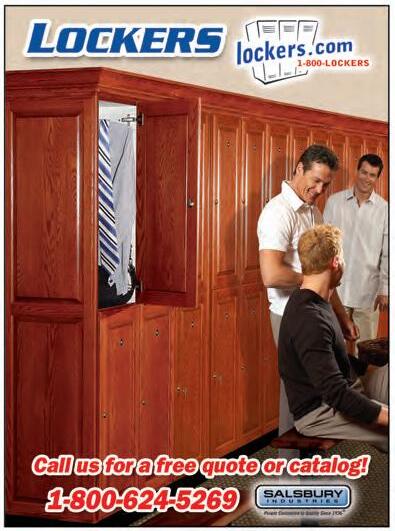




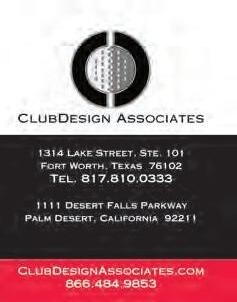



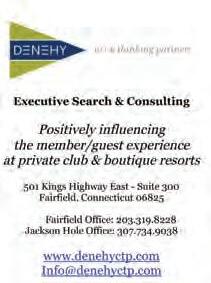



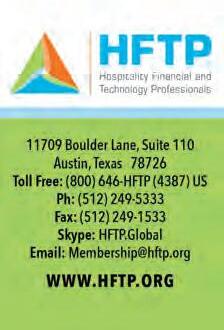


DuVal, President/CEO



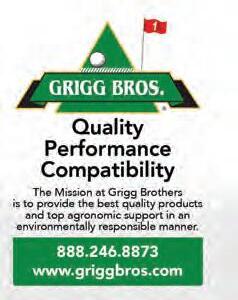













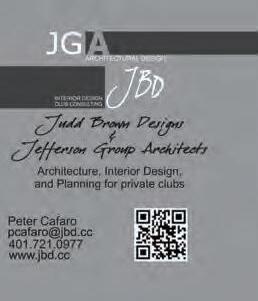



Addison Law Firm
14901 Quorum Drive, Ste. 650
Dallas, TX 75254
Tel: (972) 960-8677 Fax: (972) 960-7719
Website: www.addisonlaw.com
Email: clublaw@addisonlaw.com
Contact: Randolph Addison, president
Club Advisory Services
Club Consultants LLC
5121 Castello Drive, Suite 1
Naples, FL 34103
Tel: (239) 643-7800 Fax: (239) 643-7803
Website: www.clubconsultants.com
Contact: Bill Wernersback, sr. mng. dir.
Club Neckties, Scarves, Emblems
Stratton-Crooke Enterprises Inc.
P. O. Box 215-H
Scarsdale, NY 10583
Tel: (800) 732-9719 Fax: (914) 725-5196
Website: www.strattoncrooke.com
Email: StrattonCrooke@aol.com
Contact: Nancy & Jim Crooke
Club Services
HFTP
11709 Boulder Lane, STE 110
Austin, TX 78726-1832
Tel: (512) 249-5333 Fax: (512) 249-1533
Website: www.hftp.org
Email: Laura.Huffman@hftp.org
Contact: Laura Huffman
Clubhouse Design
Chambers
1800 Washington Blvd., Suite 111 Baltimore, MD 21230
Tel: (410) 727-4535 Fax: (410) 727-6982
Website: www.chambersusa.com
Email: jsnellinger@chambersusa.com
Contact: John R. Snellinger
Peacock + Lewis Architects
1295 US Highway One North Palm Beach, FL 33408
Tel: (561) 626-9704 Fax: (561) 626-9719
Website: www.peacocklewis.com
Email: Brian@peacocklewis.com
Contact: Brian Idle
Clubhouse Architect
Judd Brown Designs
700 School Street
Pawtucket, RI (401) 721-0977
Contact: Peter Cafaro
H. Anne Blakely Sciarrone Architecture
P.O. Box 357
Decatur, GA 30031 (678) 632-2663
Contact: Anne Sciarrone
Clubhouse Furniture
Eustis Chair
P.O. Box 842
Ashburnham, MA 01430
Tel: (978) 827-3103 Fax: (978) 827-3040
Web site: www.eustischair.com
E-Mail: fred@eustischair.com
Contact: Fred Eustis
Gasser Chairs
4136 Logan Way
Youngstown, OH 44505
Tel: (330) 759-2234 Fax: (330) 759-9844
Web site: www.gasserchair.com
Email: ksmith@gasserchair.com
Contact: Kevin Smith
Consulting
Clubwise Consulting
3507 Dunlin Shore Court Norcross, GA 30092 (770) 248-1047
Contact: Jerry McCoy
Email: Cmaamcm@msn.com
Denehy Club Thinking Partners
501 Kings Highway East 06825 (203) 319 8228
Website: www.denehyctp.com
Contact: Dan Denehy
McMahon Group
670 Mason Ridge Center Drive , Suite 220
St. Louis, MO 63141
Tel: (800) 365-2498
Website: www.mcmahongroup.com
E-Mail: info@mcmahongroup.com
Course Maintenance
International Golf Maintenance, Inc. (IGM) 8390
Champions Gate Blvd #200 Champions Gate, FL 33896
Tel: (800) 413-5500 FAX: (407)589-7223
Website: www.igminc.net
Email: gregp@igminc.net
Contact: Greg A. Plotner CGCS, EVP
Executive Search Firm
Kopplin Kuebler & Wallace
Southwest Office
7349 Via Paseo Del Sur, Ste. 202 Scottsdale, AZ 85258
Tel: (480) 443-9102 Fax: (480) 443-9642
Website: www.kkandw.com
Email: dick@kkandw.com
Contact: Dick Kopplin, partner
Kopplin Kuebler & Wallace
East Coast Office
132 Tulip Tree Court Jupiter, FL 33458
Tel/Fax: (561) 747-5213
Cell: (407) 864-6798
Website: www.kkandw.com
Email: kurt@kkandw.com
Contact: Kurt Kubler, CCM, partner
Kopplin Kuebler & Wallace
Cleveland Office
20373 Scott Drive
Cleveland, OH 44149
Tel/Fax: (440) 783-1268
Cell: (412) 670-2021
Website: www.kkandw.com
Email: tom@kkandw.com
Contact: Tom B. Wallace III, CCM, partner
Food & Beverage Software
Culinary Software Services
1900 Folsom Street #210 Boulder, CO 80302
(303) 447-3334
FOOD-TRAK®/System Concepts, Inc.
15900 N. 78th Street
Scottsdale, AZ 85260
Tel: (480) 951-8011 x 8026
Fax: 480-951-2807
Email: nancys@foodtrak.com
Website: www.foodtrak.com
Contact: Nancy Shina, director of marketing
C2 Limited Design Associates
95 Reef Road
Fairfield, Connecticut 06824
Tel: (203) 259-2555 Fax: (203) 259-2565
Website: www.c2limited.com
Email: studio@c2limited.com
Contact: Craig J. Smith
Ferry, Hayes & Allen Designers, Inc.
1100 Spring Street, Suite 600 Atlanta, GA 30309
Tel: (404) 874-4411 Fax: (404) 874-1099
Website: www.fhadesigners.com
Email: jbarret@fhadesigners.com
Contact: Jeff Barrett, executive vice president
HINT |Harris Interiors
49B Lenox Pointe
Atlanta, GA 30324
Tel: (404) 403-2931
Website: www.hintatlanta.com
Email: kelley@hintatlanta.com
Image Design, Inc.
3330 Cumberland Blvd.
Atlanta, GA 30339
Tel: (770) 952-7171 Fax: (770) 933-9093
Website: www.imagedesign.com
Email: mfleming@imagedesign.com
History
Private Club Historical
1100 South Coast Highway, Suite 309 Laguna Beach, CA 92651
Tel: (949) 497-6543
Website: www.privateclubhistorical.com
E-Mail: Tom@privateclubhistorical.com
Contact: Tom Neill
Kitchen & Banquet
Spring USA
127 Ambassador Drive #147 Naperville, IL 60540 (630) 527-8600
Website: www.springusa.com
Locker Room Suppliers
Sports Solutions, Inc. 2536 Manana Drive
Dallas, TX 75220
Tel: (800) 969-8008 Fax: (214) 351-2609
Website: www.sportssolutionsinc.com
Email: sales@sportssolutionsinc.com
Contact: Laurie Schmidt
Lockers
Salsbury Industries - Lockers.com 1010 East 62nd Street
Los Angeles, CA 90001
Tel: (800) LOCKERS Fax: (800) 562-5399
Website: www.Lockers.com
Email: Salsbury@Lockers.com
Outdoor Furniture
Bambrella
6464 East Rogers Circle
Boca Raton, FL 33487
Tel: (561) 288-8655
Website: www.Bambrella.com
E-Mail: info@Bambrella.com
Xhibtz Contract Furnishing
11071 Indian Lake Circle
Boynton Beach, FL 33437
Tel: (954) 614-1505
Fax: (888) 880-9124
Website: www.xhibtz.com
Email: xhibtz1@bellsouth.net
Purchasing Group
Essensa
555 West 57th St., 12th Floor
New York, NY 10019
Tel: (866) 430-5330
Website: www.Essensa.org
E-Mail: essensainfo@essensa.org
Research & Data
Club Benchmarking PO Box 2082
New Castle, NH 03854 (603) 553-8958
Technology
Culinary Software Services
2930 Center Green Court Boulder, CO 80301 (303) 447-3334
FOOD-TRAK®/System Concepts, Inc. 15900 N. 78th Street
Scottsdale, AZ 85260
Tel: (480) 951-8011 x 8026
Fax: 480-951-2807
Email: nancys@foodtrak.com
Website: www.foodtrak.com
Contact: Nancy Shina, director of marketing
Northstar
161 Kimball Bridge Road #200 Alpharetta, GA 30009
Website: www.globalnorthstar.com
Tableware/Menus
Polar
2046 Castor Avenue
Philadelphia, PA 19134
Tel: (800) 831-7823 Fax: (215) 535-6971
Website: www.the-polar.com
Email: bradk@the-polar.com
Contact: Brad Karasik
Walco Stainless/Utica Cutlery
820 Noyes St. Utica, NY 13503
Tel: (800) 879-2526 Fax: (315) 798-3757
Email: susan@uticacutlery.com
Website: www.uticacutlery.com
Contact: Susan Martin
Uniforms
High End Uniforms
5442 Gateway Plaza Drive
Benicia, CA 94510 (707) 746-7011



635 King Street |Charleston, SC 29403
(843) 884-4007 |bauersales@bauerinternational.com www.bauerinternational.com

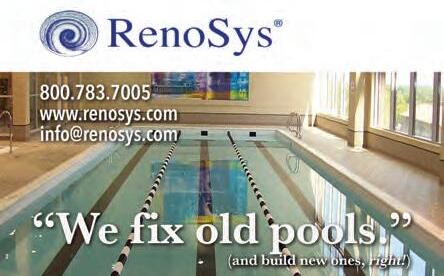
BOARDROOM MAGAZINE ADVERTISING INDEX
accp.
addison Law.
ambassador uniform.
boothe Group.
bozeman club & corporate Interiors.
c2 Limited Design associates.
129
11
87
133
78-79
Daniel paul chairs. .
15
DeI Food Service equipment & Design. . . . 104
Denehy club thinking partners.
epic Golf Insurance Services.
eustis chair.
Infrared.
Jonas club Software.
25
117
91
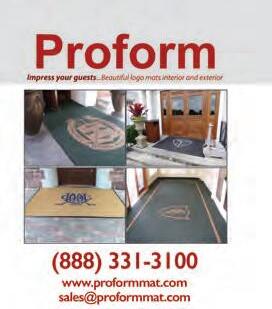

95
46-47 Judd brown Designs
107 kecamps.
108 kempersports.
65-65 chambers.
cheftec.
clubessential.
clubtec/clubster.
clubmark.
clubpay.
clubsystems group.
87
55
38-39
26, 27 & 36
31
53
eZLinks / IbS club Software.
Flora Springs.
FOOD-trak.
Fortessa hosting.
Gasser chair.
GcSaa.
Golf maintenance Solutions.
59
68-69
42-43
44-45
6
139
131
103 kopplin kuebler & Wallace.
23 Lichten craig architecture + Interiors.
103 maI.
19 mcmahon Group.
8 membersFirst.
48-49 northstar.
37 & 140 paisano performance partners.
40-41 clubwise.
club Software.
99
52 cornilleau uSa.
77 creative Golf marketing
2
Grigg brothers.
Groupvalet.
GSI executive Search.
high end uniforms.
hInt - harris Interiors.
BOARDROOM MAGAZINE COUNTRY CLUB INDEX
mike andelman, club member, elgin country club, IL
Sharon browning, past president, bel-air bay club, ca
cliff carter, Gm, meadowbrook country club, ak
adrianne coloton, port charlotte Golf club
bella collina Golf & towne club, ca
chris boettcher, ccm, cce, Gm/cOO, burlingame country club, ca
Jon Davidson, vp operations, Shangri-La resort
edward ewing, Jr, Gm, Sailfish point, Stuart, FL
ted Gillary, Gm/cOO, Detroit athletic club, Detroit, mI
Greg Griffin, Gm, rolling hills country club, texas
Lynn hearn, director of spa and fitness, Lost tree club
bill howard, Gm, bel-air bay club, bel-air, ca
Samantha La Due, director of communications, bel-air bay club, bel-air, ca
Dawn Jackson, director of communications/It, bald head Island club
Dwight Jenson, Gm/cOO, chicago Yacht club, chicago, IL
mike Leemhuis, president, Ocean reef club, key Largo, FL
nancy Levenburg, member, Spring Lake country club, Spring Lake, mI
Stephen LoGuidice, Gm/cOO, Ibis Golf & country club, West palm beach, FL
brian Long, Gm, clove valley rod & Gun club
anthony J. magdowski, president, Detroit athletic club, Detroit, mI
Greg miarecki, president, chicago Yacht club, chicago, IL
3
95
105
106
70-71
109 peacock + Lewis.
99 pGa.
17 polar.
91 reid consulting Services.
50-51
121 resortSuite.
peter miller, president, Ibis Golf & country club, West palm beach, FL
eben molly, Gm, Woodfield country club, boca raton, FL
macDonald niven, ccm, cce, Gm, La rinconada country club, Los Gatos, ca
Dr. bonnie knutson, the country club of Lansing and the michigan athletic club
robert norton, Gm, bald head Island club
al Oerter, late board member, new York athletic club, new York, nY
anthony Orlando, board member, new York athletic club, new York, nY
Gregg patterson, member, the beach club of Santa monica, ca
Daniel perez, assistant manager, new York athletic club, new York, nY
Joanna pratt, marketing and membership coordinator, St andrews country club
rachelle reali, director of member communication, La rinconada country club, ca
Dave Shinnebarger, boca Lago country club
Spring Island, Okatie, Sc
St charles country club, St charles, IL
Douglas Stewart, Gm, elgin country club
mark tabit, president, bel-air bay club, bel-air, ca
vernango valley Golf course, venango, pa
vestavia country club, birmingham, aL
chase Walker, Gm, cottonwood country club, ut
Geoffrey Williams, Gm, White mountain country club, aZ
Williams Island & Wycliffe country club, Wellington FL
SINGLE SUBSCRIPTION @ $8900* (U.S.)
One (1) annual subscription to the boardroom magazine.
EXECUTIVE TRI - PAK @ $14700* (U.S.)
three (3) annual subscriptions to the boardroom magazine for the general manager, board president and treasurer. Additional copies______@ $39 each
BOARDROOM - PAK @ $29500* (U.S.)
ten (10) annual subscriptions to the boardroom magazine for each of your board members. Additional copies______@ $29 each
reGuLar prIce: SInGLe SubScrIptIOn $178 - trI-pak $294 bOarDrOOm 10 pak $590 annuaL SubScrIptIOn 6 bI-mOnthLY ISSueS IncLuDInG ShIppInG!
mY check (paYabLe tO bOarDrOOm maGaZIne) FOr $__________________ IS encLOSeD. pLeaSe charGe $_____________________ tO mY creDIt carD (cIrcLe One). vISa mc ameX

bILLInG aDDreSS FOr
